Library of Social Science Newsletter
Chronological List
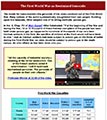
The First World War as genocide (Feb 22, 2019)
The model for mass-murder—the genocide of the Jews—evolved out of the First World War. Many nations of the world systematically slaughtered their own people. Building upon this template, Hitler adopted one of its killing methods: poison gas. In Vol. II, Chap. XV of Mein Kampf, Hitler fulminated: "If at the beginning of the War and during the War, 12 or 15 thousand of these Hebrew corrupters of the people had been held under poison gas, as happened to hundreds of thousands of our very best German workers in the field, the sacrifice of millions at the front would not have been in vain."
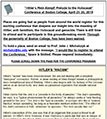
Hitler’s "Racism"—Free registration, Boston College Conference (Feb 21, 2019)
Hitler's "racism" has been misunderstood. We are not dealing with a simplistic "biological" conception. Rather, a close reading of Mein Kampf reveals a philosophical, even metaphysical way of thinking. Hitler's idea begins with his fantasy of the German nation as an actual body, and Jews as parasitical organisms that invade national bodies. Hitler claims that the Jew is a "parasite in the body of peoples." The Jew's spreading, he says, is a "typical phenomenon for all parasites;" he always seeks a "new feeding ground for his race." The Jew is the "typical parasite," a sponger who like a "noxious bacillus" keeps spreading "as long as a favorable medium invites him." The effect of the Jew's existence is that—wherever he appears—"the host people dies out."
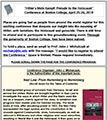
Register for groundbreaking conference on the Holocaust—Fee Waived (Feb 20, 2019)
Places are going fast as people from around the world register for this exciting conference that deepens our insight into the meaning of Hitler, anti-Semitism, the Holocaust and genocide. There is still time to attend and to participate in this groundbreaking event. Through the generosity of Boston College, fees have been waived. To hold a place, send an email to Prof. John J. Michalczyk with the message, "I would like to register to attend the Conference." Space is limited. Please respond immediately.
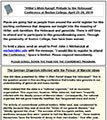
"The poison of Marxist ideas." Free Registration, Conference on Mein Kampf (Feb 19, 2019)
How did ideas presented by Hitler in Mein Kampf shape the Holocaust? This is the question posed in this exciting conference that breaks new grounds in our understanding of genocide and mass-murder. Hitler claimed that the state is a "national organism," not an economic organization. This organism, however, Hitler believed, had been "inwardly infected with the deadly poison of Marxist ideas." Consequently, the national organism did not grow inwardly healthier, but "languished more and more."
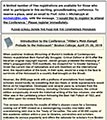
"Hitler’s MEIN KAMPF: Prelude to the Holocaust"—Free registration to the conference (Feb 19, 2019)
When publisher Andreas Wirsching of Munich's Institute of Contemporary History re-published Mein Kampf (My Struggle): Critical Edition in 2016 after the Bavarian original copyright expired. Jewish groups protested the reissuing of Hitler's propagandistic 1925 manifesto, his blueprint for "a Greater Germany." Given the current rise of nationalism and anti-Semitism on the international level, the republication of the book, in their eyes, would be a slap in the face to survivors of the Holocaust in a country that brought on the Shoah.
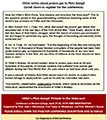
Poison gas: "Do unto others as has been done unto you." Free registration for Holocaust Conference (Feb 18, 2019)
In Hitler's fantasy, he would subject Jews to poison gas—just as he and hundreds of thousands of German soldiers had suffered from poison gas attacks during the First World War. Do unto others as had been done unto you. It was a miracle of history that Hitler would enact his desire: to subject other human beings to asphyxiation—just as he and his comrades had been. This horrific, catastrophic, cataclysmic miracle, which came to be known as the Holocaust, represented the enactment of Hitler's fantasy.
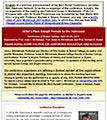
Groundbreaking Conference on Hitler & Holocaust—Free Registration (Feb 18, 2019)
Erratum: In a previous announcement of the Mein Kampf Conference, we listed Rev. Raymond Helmick, SJ as the co-organizer of the conference. Actually, the co-organizers of the meeting are Professor Susan A. Michalczyk—Film Co-Producer with John for Etoile Productions and Scriptwriter for their Berlin Wall film—along with Professor Michael S. Bryant. However, you may view a terrific video of John Michalczyk and Helmick here, in which they discuss their book, Through a Lens Darkly: Films of Genocide and Ethnic Cleansing.
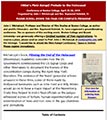
Groundbreaking Conference on Hitler & Holocaust—Free Registration (Feb 15, 2019)
Michalczyk's book, Filming the End of the Holocaust (Bloomsbury Academic) considers how the US Government commissioned the US Signal Corps and other filmmakers to document the horrors of the concentration camps during the April-May 1945 liberation. The evidence of the Nazis' genocidal actions amassed in these films, some of them made by Hollywood luminaries such as John Ford and Billy Wilder, would go on to have a major impact at the Nuremberg Trials.

Exhibit through our 2019 Promotional Package (Feb 14, 2019)
We invite publishers to exhibit through Library of Social Science's PROMOTIONAL PACKAGE, which gives you the opportunity to exhibit at all of our 2019 conference book exhibits at a single flat fee. If you are exhibiting on a conference by conference basis, why continue to do so? Exhibiting through the PP provides extraordinary savings and makes it easy to exhibit. You'll be astonished at how inexpensive it is to exhibit through this wonderful program.
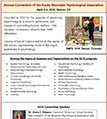
Book exhibit of the Rocky Mountain Psychological Association (Feb 14, 2019)
Founded in 1930 for the purpose of advancing psychology as a science, profession, and means of promoting human welfare—this dynamic conference attracts over 1000 attendees. Library of Social Science will be at the center of the action, representing most of the major publishers in psychology.

2019 Promotional Package: Library of Social Science (Feb 13, 2019)
Publishers may now register for the 2019 Promotional Package! Save up to 80% as compared with signing up on a conference-by-conference basis. Please send an email to Richard Koenigsberg at rak@libraryofsocialscience.com for options. Included in our 2019 Promotional Package are four book promotions (no additional charge) distributed to our database of 30,000 scholars, students and professionals around the world.
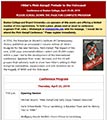
Conference on Mein Kampf & the Holocaust—Free Registration (Feb 12, 2019)
In 2016, the historians in Munich's Institute of Contemporary History published an annotated 2-volume edition of Hitler's blueprint for the new Germany, Mein Kampf. The impact of this new, 2,000 page annotated edition—which sold 85,000 copies within a year—led to the development of this international conference. Speakers from Israel, Germany and the US will present their scholarly work to show how Hitler's writing in Mein Kampf on nationalism, expansionism and anti-Semitism led to the tragedy of WWII and the Holocaust.
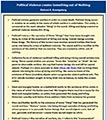
Political violence creates some thing out of no thing (Jan 30, 2019)
Collective forms of violence—political killing and dying—bring sacred entities into being. These sacred entities are unseen. Terms like "America" or "Allah" do not point to observable entities. We say that human beings die and kill for sacred objects. Perhaps it is more accurate to state (Zhuo Job Chen) that we bring these objects into being by virtue of dying and killing.

The First World War as routinized genocide (Jan 30, 2019)
The model for mass-murder—the genocide of the Jews—evolved out of the First World War. Many nations of the world systematically slaughtered their own people. Building upon this template, Hitler adopted one of its killing methods: poison gas. "All the capacity of industrial society—straining at the bit for destruction. One of the French soldiers called it extermination. I call it routinized, mechanized genocide: The genocide of people on their own citizens."
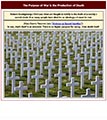
Suicide missions of the First World War (Jan 29, 2019)
Douglas Haig was the British General who planned and executed the Battle of the Somme, July 1, 1916-March 21, 1917. Reflecting on hundreds of thousands of British casualties, he wrote (De Groot, 1989): "Credit must be paid to the splendid young officers who were able time and time again to attack these tremendous positions. To many it meant certain death, and all must have known that before they started."

The purpose of war is dying (Jan 29, 2019)
Richard Koenigsberg's First Law: Wars are fought to testify to the truth of a society's sacred ideals. If so many people have died for an ideology—it must be real. Zhou Chen's Theorem (see "Violence as Sacred Sacrifice"): In war, death itself is an absolute: There is no higher purpose for dying…than death itself.
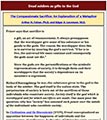
Dead soldiers as gifts to the god (Jan 23, 2019)
In war, the substance given to the god is the body of the soldier. The god itself is the nation-state. The perpetuation of society is born out of the sacrifices of those individuals who constitute society. Society itself is the god which is worshipped and for which sacrifices are made. One must pose the question: why has "society" has assumed such power over the minds of the individuals who constitute society.
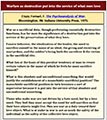
Destruction for the sake of love (Jan 23, 2019)
War as a sacrificial duty, though performing essentially destructive functions, has for men the significance of a destruction put into the service of the preservation of what they love.Fanatic behavior, the idealization of the leader, the need to sacrifice oneself in the name of an ideal, the giving and receiving of martyrdom, and the soldier's being both the sacrificer & the victim in the sacrificial rite.
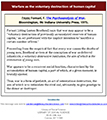
Warfare as the voluntary destruction of human capital (Jan 23, 2019)
Fornari (citing Gaston Bouthoul) says that war may appear to be a "voluntary destruction of previously accumulated reserves of human capital," an act performed with the implicit intention to "sacrifice a certain number of lives." Proceeding from the empirical fact that every war causes the deaths of young men, Bouthoul arrives at the conception of war as deferred infanticide, a voluntary destructive institution, the aim of which is the elimination of young men.
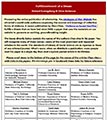
Fulfillment of a dream (Jan 22, 2019)
Pioneering the online publication of scholarship, the Ideologies of War Website has attracted a world-wide audience—exploring the sources and meanings of collective forms of violence. A recent publication by Zhuo Chen, "Violence as Sacred Sacrifice," fulfills a dream that we have had since 2006: a paper that uses the materials on our website to generate an exciting, groundbreaking insight.
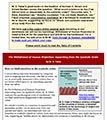
Separating from the symbolic order (Jan 18, 2019)
M. D. Faber's great book—in the tradition of Norman O. Brown and Ernest Becker—poses the question: "What would existence be like if we did not bind so desperately to the symbolic order?" Descartes said, "I think, therefore I am." Buddha countered: "I do not think, therefore I am." Faber proposes concentrative meditation as a technique to moderate our tie to objects, suggesting we focus on "direct, non-symbolic awareness of our body from the inside."
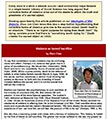
Violence as sacred sacrifice (Jan 18, 2019)
Drawing upon twenty-five article published on our Ideologies of War Website, Zhuo Job Chen takes this idea a step further hypothesizing that collective forms of violence give rise to the sacred object. Death itself is an absolute: "There is no higher purpose for dying than death itself." By dying, soldiers prove that there is "something worth dying for." Death creates the sacred object ex nihilo.

Great Books of 2018 (Jan 17, 2019)
We exhibit our clients' titles at cutting-edge conferences throughout North America—and sell publishers' books through the LSS Newsletter, which reaches 30,000 scholars, professionals and students throughout the world. PLEASE SCROLL DOWN TO READ ABOUT OUR "PICK HITS"—selected titles exhibited at our 2018 conferences. We think you'll find these books to be exciting, and relevant. For information on and/or to purchase any title—please CLICK THOUGH TO AMAZON.
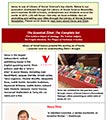
Verso and Slavoj Žižek (Jan 17, 2019)
Verso is one of Library of Social Science's top clients. Below is our promotion distributed through the Library of Social Science Newsletter, which reaches 30,000 scholars, professionals and students around the world. In 2019, LSS will focus—not only on book exhibits—but on promoting and selling your titles through the Library of Social Science Newsletter, Please scroll down to read more about Verso and Žižek.
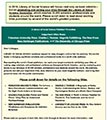
Promoting your books through the LSS Newsletter (Jan 17, 2019)
Representing the world's finest publishers, we reach your target markets by exhibiting your titles at cutting-edge scholarly and professional conferences throughout North America—and by marketing your books to our database of 30,000 scholars, professionals and students around the world. We publicize, promote and sell your important titles, draw attention to your most insightful authors—and bring their powerful ideas into the public marketplace.
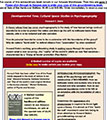
Developmental Time, Cultural Space: Special Sale (Jan 15, 2019)
Just five copies of this extraordinary book remain in our Amazon Warehouse. Then they are gone forever. Please click through to Amazon now to order your copy of this groundbreaking book. Special Sale of the Hardcover Edition: $6.95 (List $49.95). Order immediately to reserve your copy. “People seek secure boundaries,” Stein says, in order to “differentiate between us and them, inside and outside, good and evil.” Boundaries must be closed, and “anything which might threaten the perfection of greatness within must be excluded.”
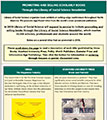
Library of Social Science Book Promotions (Jan 14, 2019)
Library of Social Science organizes book exhibits at cutting-edge conferences throughout North America. We promote significant titles from the world's most prominent publishers. In 2019 Library of Social Science will expand its service to include promoting and selling books through the Library of Social Science Newsletter, which reaches 30,000 scholars, professionals and students around the world. Below are a several titles that we promoted in 2018.
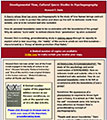
Walls, borders, Psychogeography and boundary maintenance (Jan 11, 2019)
A theory whose time has come: psychogeography is the study of how human beings contruct boundaries in order to protect the nation and shore up the self; to delineate inside from outside, who is to be included and who excluded. How do personal boundaries come to be co-extensive with the boundaries of the group? Why do nations “build walls” to defend citizens from “penetration” by alien outsiders? Howard Stein’s exciting, groundbreaking study is making waves through its capacity to explain what is now occurring…the “reality” of the world in which we now find ourselves—characterized by a “frenzy of border protection (Paul Kahn).”
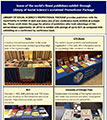
Exhibiting through Library of Social Science's Promotional Package (Jan 11, 2019)
LIBRARY OF SOCIAL SCIENCE'S PROMOTIONAL PACKAGE provides publishers with the opportunity to exhibit at each and every one of our conference book exhibits at a single fee. Please scroll down the page for photos of publishers who took advantage of this extraordinary opportunity (in 2018) to exhibit with savings of up to 80% as compared with exhibiting on a conference by conference basis.
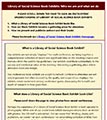
Library of Social Science Book Exhibits: who we are/what we do (Jan 10, 2019)
Our exhibits are not simply "displays." For each conference, we bring together a comprehensive collection of recent and significant titles on the meeting's topics and themes—from the world's top publishers. Our exhibits contribute substantially to the success and intellectual value of the meeting—becoming a gathering place where attendees meet and mingle. Our exhibits create excitement among conference-goers, showcasing the breadth and depth of research in their given field.

Top-Ranked Presses (Jan 10, 2019)
Library of Social Science works with over 220 publishers—presenting their titles to scholars, professionals and students at some of the best conferences held each year. There are many ways to evaluate a publisher. We have selected the twenty-one presses below as among the most passionate and deeply committed to reaching a title's target market.
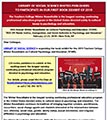
First Book Exhibit of 2019! (Jan 08, 2019)
LIBRARY OF SOCIAL SCIENCE INVITES PUBLISHERS TO PARTICIPATE IN OUR FIRST BOOK EXHIBIT OF 2019. The Teachers College Winter Roundtable is the longest running continuing professional education program in the United States devoted solely to cultural issues in psychology and education. The Library of Social Science book exhibit will be located at the center of the meeting space and open to attendees throughout the meeting. Our professional exhibit managers will be on-site throughout the conference.
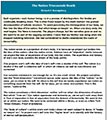
The nation transcends death (Dec 13, 2018)
"Each organism—each human being—is in a process of disintegration. Our bodies are continually breaking down. This is what Freud meant by the death instinct: the gradual decomposition of cellular structure. To avoid perceiving the disintegration of our body, we flee into the idea of the nation; that which keeps on keepin' on. When one story ends, the next begins. The News is immortal. The players change, but the narrative goes on and on."
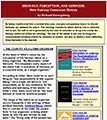
Ideology, perception and genocide (Dec 13, 2018)
By being transformed into a societal discourse, energies and passions bound to shared fantasies are released for action. The ideology transforms latent desires into a collective will to act. The will to act is generated by the wish to actualize or bring into reality the fantasy contained within the ideology. The role of the leader is not only to bring into consciousness fantasies shared by members of society, but also to devise a plan—allowing these fantasies to be enacted.
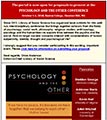
Call for papers: Psychology and the Other (Dec 12, 2018)
Since 2013, Library of Social Science has organized book exhibits for this well-run, interdisciplinary conference that brings together scholars from the fields of psychology, social work, philosophy, religious studies, anthropology, sociology and the humanities—to explore links between the psychic and the social. How do larger societal concerns interact with considerations of human subjectivity, identity, thought and psychological life?
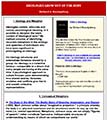
The bodily source of ideology (Dec 12, 2018)
The reality that the Nazis constructed cannot be separated from bodily fantasy. If ideas about a target domain are derived from experiences in a source domain, it follows that ideas about bodies politic cannot be separated from the experience of our own bodies. Social theory typically focuses on the ways that discourse shapes the body. I hypothesize that our bodies—bodily experience—give rise to and structure discourse.
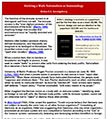
Building a Wall: Nationalism as Immunology (Dec 11, 2018)
The American President, it would appear, equates his own body with the American body politic. He has presented a policy—that some people embrace—insisting that Americans protect their own "geographic space" (Stein, 2013). A wall is necessary in order to firm up "porous boundaries"—to prevent alien elements from seeping into the national body.
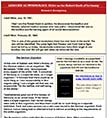
Genocide as Immunology: Hitler as Robert Koch (Dec 11, 2018)
At the core of Nazism was Hitler’s fantasy of the German nation—as an organism: “My Movement,” Hitler said, “encompasses every aspect of the entire Volk. It conceives of Germany as a corporate body, as a single organism.” It followed that there could be no such thing as “non-responsibility in this organic being,” not a single cell that was not responsible “for the welfare and well-being of the whole.”
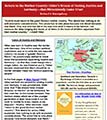
Return to the Mother-Country (Dec 7, 2018)
Hitler sought to annul the trauma of separation by enacting the fantasy of symbiotic union in relationship to political entities. Austria—once part of Germany—subsequently had separated from her. Hitler declared that separation was intolerable: Austria and Germany could not remain separate: Austria must return to the mother (country).
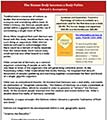
The Human Body becomes a Body Politic (Dec 7, 2018)
Hitler was an embodiment theorist. He insisted that Germany was a real entity, not merely an abstraction or "imagined community." His fantasy of Germany as a body crystallized at the Nuremberg rallies, which he created in order to perceive or "witness" the German body. At the moment people marched into the stadium and moved before him, Hitler's doubts about the reality of Germany vanished.
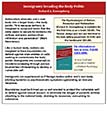
Immigrants invading the body politic (Dec 6, 2018)
Immigrants are experienced as if foreign bodies within one's own body, eliciting hysteria—a psychosomatic symptom—generating an immune response. Boundaries must be firmed up—a wall erected to protect the vulnerable self: to defend against sexual assault; to eliminate the danger of parasitic entities attaching to the national body, draining its resources, consuming its substance.
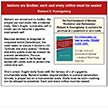
Nations are Bodies: every orifice must be sealed (Dec 5, 2018)
Because territory is imagined in corporeal terms (Neocleous), the state seeks to secure it borders—its "orifices and entry points." One's actual, fragile body fuses with the fantasy of a of a gigantic, invulnerable body. National bodies require borders to prevent penetration. Anxiety is played out on a monumental scale. Walls must be built—nothing can be allowed to penetrate. Each and every orifice must be sealed.
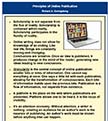
Principles of Online Publication (Dec 4, 2018)
Granularity is the central concept of online publication: smaller bits or bites of information. One cannot say everything at once. One says a little bit with each publication, allowing for the transformation of consciousness. Each bite of information builds upon the previous bite. Publication is a flow of information, not separate from existence.
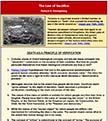
The Law of Sacrifice (Dec 4, 2018)
The concept of "killing" is subordinate to the concept of "dying." The purpose of acts of "aggression" (killing in war, genocide or terrorism) is to get others to die for the idea that is worshipped by one's own group. A society kills members of another group—so that members of this group will be persuading of "the truth." Collective forms of violence are undertaken in order to establish the truth or validity of a sacred ideal.
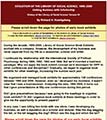
Uniting business with scholarship (Nov 26, 2018)
We organized and managed book exhibits for approximately 140 conferences between 1990 and 2000. However, even as I developed my business, it wasn't clear that I was a businessman. It turns out that I gave presentations at fifty-one conferences during this period. Did I give presentations because I was going to the meetings to organize book exhibits? Or did I organize book exhibits at these meetings in order to give me the opportunity to present papers.
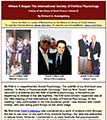
Int'l Society of Political Psychology (where it began) (Nov 26, 2018)
My PhD is in (experimental) Social Psychology. The subtitle of my first book was entitled, "A Study in Psychoanalytic Sociology." But my first "home" when I returned to academia was the field of political psychology, a discipline just beginning to emerge in the late eighties. The first book exhibit I organized was at the 1988 meeting of the International Society of Political Psychology.

In our hearts the dream remains the same (philosophy of book exhibits) (Nov 21, 2018)
As LSS Book Exhibits evolved in the Nineties, I frequently presented papers or participated in panels at meetings where we created book exhibits. What was my thinking? Did I create the book exhibit business in order to finance my desire to present ideas at conferences? Or—since I was organizing a book exhibit at a particular meeting, did I say to myself—"Gee, since I'm attending the meeting as an exhibitor, I might as well present a paper?"
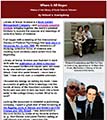
Birth of the Library of Social Science (Nov 20, 2018)
Library of Social Science is a Book Exhibit Management Company—and scholarly research institute bringing together the world's greatest thinkers to explore the sources and meanings of collective forms of violence. It all began with a meeting of the International Society of Political Psychology that took place in Secaucus, NJ, in July 1988. My missions—of studying collective forms of violence and creating book exhibits—were united from the beginning.
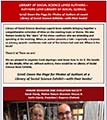
Library of Social Science Loves Authors (Nov 19, 2018)
Library of Social Science develops superb book exhibits bringing together a comprehensive collection of titles on the meeting topic or theme. We also feature books by the “stars” of the show—authors who are attending and speaking at the meeting. When an author presents a talk—especially a keynote or plenary speech—conferees rush out of the lecture hall and ask: Where is the book? There it is! There we are!
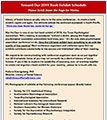
Once you have found a great conference, never let it go (Nov 16, 2018)
Library of Social Science usually returns to the same conferences—to create a book exhibit—again and again. Our attitude echoes the sentiment expressed in South Pacific, "Once you have found her, never let her go." We expect to be communicating with conference organizers soon as we put together our 2019 schedule. If you'd like to explore the possibility of becoming one—of working together to create and organize a book exhibit for your meeting…please be in touch with me.
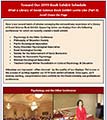
What an LSS book exhibit looks like: Part II (Nov 16, 2018)
Here is our second batch of photos conveying the extraordinary experience of a Library of Social Science Book Exhibit. Attendees are impressed—often stunned—by the quality of our displays. We're now in the process of putting together our 2019 book exhibit schedule. Once again, we'll develop exciting, comprehensive book exhibits for the finest scholarly and professional conferences.
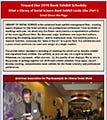
Toward Our 2019 Book Exhibit Schedule (Nov 15, 2018)
The photos below represent a sampling of meetings for which we've recently created and organized book exhibits. Our exhibits, as you can see, are a sight to behold. Attendees are impressed—often stunned—by the quality of our displays. We're now in the process of putting together our 2019 book exhibit schedule. Once again, we will develop exciting, comprehensive book exhibits for the finest scholarly and professional conferences.
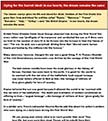
Dying for the Sacred Object (Nov 13, 2018)
The Iranian martyr gives his life and blood for Allah. Soldiers of the First World War gave their lives and blood for entities called “Russia,” “Germany,” “France” “Romania,” “Italy,” “Turkey”—and “the British Empire.” The difference between the soldiers of the First World War and Islamic suicide bombers lies in the quantity of the martyrs—and the degree to which people in the respective cultures are aware or conscious of the meaning of societal violence.
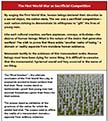
The First World War as Sacrificial Competition (Nov 13, 2018)
Like each cultural creation, warfare expresses, conveys, articulates—the desires of human beings. What is the nature of the desire that generates warfare? The wish to prove that there exists “another realm of being,” a domain or reality separate from mundane human existence. Memorials testify to the existence of this transcendent realm. Human beings must have been dying for some thing. It is difficult to conceive that the monumental, hysterical sound and fury occurred in the name of no-thing.

Psychoanalysis of Racism is back in stock! Limited quantity. (Nov 5, 2018)
One can call the diseased other a Jew or Bolshevik or homosexual or a mental patient or a Slav (as the Nazis did). Or one can call the diseased other a Mexican, a Muslim, a Syrian, an Arab or an immigrant. The name doesn't matter: in the heart of the radical nationalist—the dream remains the same: removal of the diseased other from within the boundaries of the nation. As long as the diseased other is present within the body politic, the nation cannot achieve greatness.
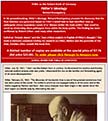
Hitler as the Robert Koch of Germany (Nov 5, 2018)
In his groundbreaking, Hitler's Ideology, Richard Koenigsberg presents his discovery that the Final Solution was generated based on Hitler's belief that he had identified Jews as pathogenic micro-organisms—cause of a "disease within the body politic" that could be cured by eliminating these pathogens from within the body politic. This finding has been confirmed by Robert Lifton—and many other researchers. Called an "instant classic" and the "best critical analysis in English of Hitler's thought," this book is bedrock—required reading for research on Hitler, Nazism and the genocide of the Jews. Scholars often consult this book first.
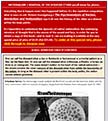
Nationalism = removal of the diseased other (Nov 1, 2018)
One can call the diseased other a Jew or Bolshevik or homosexual or a mental patient or a Slav (as the Nazis did). Or one can call the diseased other a Mexican, a Muslim, a Syrian, an Arab or an immigrant. The name doesn't matter: in the heart of the radical nationalist—the dream remains the same: removal of the diseased other from within the boundaries of the nation. As long as the diseased other is present within the body politic, the nation cannot achieve greatness.
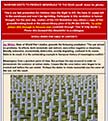
Warfare produces memorials to the dead (Oct 30, 2018)
Jay Winter, Dean of World War I studies, presents the following conclusion: "The war solved no problems. Its effects, both immediate and indirect, were either negative or disastrous. Morally subversive, economically destructive, socially degrading, confused in its course, futile in its result it is the outstanding example in European history of meaningless conflict." Meaningless from a practical point of view. But perhaps the war occurred as a testimonial to demonstrate the existence of nation-states. Crosses like the ones below were began to be erected well before the war ended. Perhaps the desire to create memorials was the cause of the war, not the result.
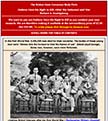
The nation state consumes body parts (Oct 30, 2018)
Willingness to join the military in the First World War was the way in which one demonstrated one's devotion to one's nation. To fight for one's country—risking death and body mutilation—represented a "pledge of allegiance" in its most radical form. A reporter described his encounter with a Canadian soldier who had been wounded in battle.
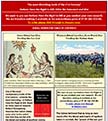
The most disturbing book of the 21st Century? (Oct 29, 2018)
One of the most revolutionary books of the 21st Century—certainly the most disturbing—is Nations Have the Right to Kill. Based on thirty years of research, Richard Koenigsberg theorizes that nation-states come alive to the extent that that they are fed with the blood and bodies of sacrificial victims. Scholars and students writing about collective forms of violence cannot afford to be without this book.
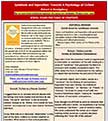
Psychological sources and meanings of culture (Oct 26, 2018)
Some of you may have been disappointed when you attempted to order Symbiosis and Separation. We've sold out the initial print run. However, due to the magic of print-on-demand-publishing, additional copies are now available. This is a foundational work on the psychological sources and meanings of culture. A limited number of copies are available at the special rate of $9.95 for the paperback edition (list $25.00). SYMBIOSIS AND SEPARATION lays the groundwork for a theory of culture and politics by showing how objects in the external world act as symbols and containers for inner objects.
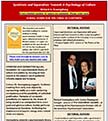
Symbiosis and Separation (Oct 3, 2018)
Culture, Dr. Koenigsberg suggests, facilitates breaking from early love-objects by representing reality as a realm containing omnipotence and the possibility of unlimited gratification. Fantasies of narcissistic grandiosity are replaced by the dream of being bound in an omnipotent tie to one’s great and glorious culture. Society performs developmental functions, facilitating the displacement of psychic energy onto cultural ideals and objects.
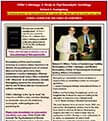
Psychoanalytic Interpretation of Culture & History (Oct 2, 2018)
Koenigsberg defines psychoanalytic sociology as a science whose objective is to identify the psychological roots of cultural ideas and beliefs, particularly those embodied in modern ideologies. Whereas conventional social theory often is satisfied with “discourse” as an explanatory concept, Koenigsberg explores the unconscious desires and fantasies that are the source of cultural narratives. Hitler’s Ideology is the “go to book” for research on Hitler’s ideas and Nazi ideology, an invaluable resource for historians, sociologists, anthropologists and psychologists.
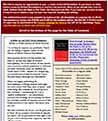
Thank you for reading the LSS Newsletter! A special opportunity for you. (Oct 1, 2018)
The essays we’ve presented through our Newsletter grow out of Koenigsberg’s Nations Have the Right to Kill: Hitler, the Holocaust and War. Many of you own and have read this book. But if you have not, we want to make it easy for to obtain copy—to use in your own research, teaching and writing. There are a few copies remaining in our Amazon warehouse. We are making the book available for readers of the LSS Newsletter at the nominal fee of $1.99 for the paperback version (list $39.99), and $3.99 for the hardback edition (list $45.95).
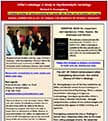
Methodology for the Interpretation of Ideology (Sep 27, 2018)
The LIST OF TABLES below present what Koenigsberg discovered—the central themes of Hitler's ideology. Dr. Koenigsberg is one of the few authorities on Hitler and Nazism whose formal training is in (Experimental) Social Psychology. What is unique about Hitler’s Ideology is it rigorous methodology. Koenigsberg identifies Hitler’s main ideas or themes inductively—through comprehensive analysis of the central images and metaphors that appear in Hitler’s writing and speeches.
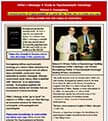
Psychoanalytic Sociology (Sep 27, 2018)
Koenigsberg defines psychoanalytic sociology as a science whose objective is to identify the psychological roots of cultural ideas and beliefs, particularly those embodied in modern ideologies. Whereas conventional social theory often is satisfied with “discourse” as an explanatory concept, Koenigsberg explores the unconscious desires and fantasies that are the source of cultural narratives. Hitler’s Ideology is the “go to book” for research on Hitler’s ideas and Nazi ideology, an invaluable resource for historians, sociologists, anthropologists and psychologists.
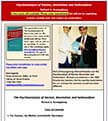
Michael Dukakis, Richard Koenigsberg & the Psychoanalysis of Racism (Sep 26, 2018)
The paperback version of The Psychoanalysis of Racism has sold out. We have just a few copies of the hardbound edition. Once these copies sell, we will not be reprinting. Caption: Richard Koenigsberg, Michael Dukakis and The Psychoanalysis of Racism, Revolution and Nationalism. Michael was defeated in the 1988 Presidential election. Had he read the book before his run, perhaps the outcome would have been different.
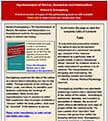
The Country, the Mother & Infantile Narcissism: The Psychology of Nationalism (Sep 25, 2018)
Koenigsberg’s book deconstructs this “dominant discourse”—by uncovering the fantasies and desires that compel us to fall under this ideology’s spell. Please order immediately to make certain you obtain your copy. IF YOU DO NOT LOCATE A COPY OF PSYCHOANALYSIS OF RACISM WHEN YOU CLICK THROUGH TO AMAZON, WE APOLOGIZE. This is because we have sold out.

Psychoanalysis of Racism, Revolution & Nationalism (Sep 25, 2018)
Koenigsberg examines the idea of the nation as a sacred object saturating our day-to-day reality. Through analysis of the writings of Hitler, Lenin, and others, he identifies core fantasies underlying the ideology of nationalism. What racists and revolutionaries have in common is belief that a particular class of people constitutes a "disease" within the body politic—that must be "removed" if the nation is to survive. Please order immediately to make certain you obtain your copy.
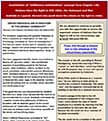
Annihilation of "Selfishness Individualism" (Sep 18, 2018)
The excerpt on the left, according to Richard Koenigsberg, reveals the meaning of Hitler’s “racism” or “anti-Semitism,” which has little to do with the popular idea, or even with typical conceptions presented by historians.When Hitler spoke of Germans as a “superior race,” he was referring to their ability to sacrifice for a national community. The Jewish “race” was the opposite—characterized by its inability to sacrifice for a national community.
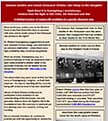
Like sheep to the slaughter (German soldiers & Holocaust victims) (Sep 18, 2018)
What do German soldiers sent to the Western Front in the First World War have in common with Jews sent to death camps in the Holocaust (see photos to the right)? Dr. Richard Koenigsberg suggests that in each case, innocent human beings were delivered to an unknown destination—where there was a high probability they would be slaughtered. What we witness, Koenigsberg says, is a profound betrayal of trust, an experience that in each instance acted to shatter belief in the goodness of society and its leaders: human beings were transported “like sheep to the slaughter.”
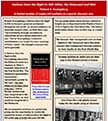
Death by cattle-car (Sep 17, 2018)
In Nations Have the Right to Kill, Koenigsberg shows how the Holocaust arose as a response to Hitler's traumatic experience of the First World War. The Holocaust represented a monumental reenactment, guided by the logic: “Do unto others as has been done unto you.” Just as German soldiers had been slaughtered in the First World War, so Jews would be slaughtered in the Holocaust.
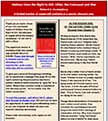
Nations Have the Right to Kill—still available at a special discounted rate (Sep 17, 2018)
To give you a sense of Koenigsberg’s thinking, we’ve reproduced a passage from page 45 (on the right) containing the provocative idea that a soldier’s death in battle functions to “give life” to a nation. Blood from a soldier’s body is transferred into the body politic. “As the soldier dies, the nation comes alive.” To read this passage—and others like it—please click through to Amazon now. We want you to have the opportunity to read this groundbreaking work—so you can integrate its ideas into your own research, teaching and writing.
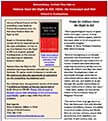
Special sale—Nations Have the Right to Kill (Sep 14, 2018)
Based on the extraordinary reviews of we've received (see to the right and below), it's fair to say that Nations Have the Right to Kill is an original, ground-breaking book on the sources and meanings of collective forms of violence. Nations Have the Right to Kill attracted enormous attention and sold very well. However, 76 copies remain in Amazon’s warehouse. We want you to have the opportunity to read and to use this compelling, foundational work.
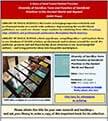
Free download—Diversity of Sacrifice (SUNY Press) (Aug 24, 2018)
Bringing together scholars from anthropology, archaeology, literature, and theology, Diversity of Sacrifice explores the power of sacrificial practices across a range of contexts—from prehistory to the present. Incorporating theory, material culture, and textual evidence, the volume considers new evidence and provides novel insights. We urge you to read the free Chapter, and to purchase the book for yourself and/or your college library. Click the link to the above for ordering information.
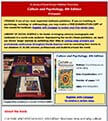
Free examination copy of "Culture and Psychology" from Cengage (Aug 24, 2018)
CULTURE AND PSYCHOLOGY, 6th Edition: illustrates how and why culture influences mental processes and behaviors in humans. Incorporating current research that highlights the relationship between culture and psychology, the authors use a cross-cultural framework that gives students the tools necessary for evaluating many psychological processes and principles from a cultural perspective. In addition, the text encourages students to question traditionally held beliefs and theories and their relevance to different cultural groups today, and to apply what they learn to their own lives.
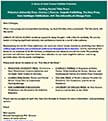
Far Right Culture, Mindfulness, the Ku Klux Klan, Movies & Mental Illness—great recent books (Aug 23, 2018)
When I was young and accomplished something, my Aunt Dorothy often proclaimed, “Tell the world, tell the world.” LIBRARY OF SOCIAL SCIENCE combines respect for deep thought—with a flair for publicity. Please scroll down for details on my “Pick Hits of the Week”. Please read my synopsis of each title, then click through to Amazon for more information—and purchasing options.
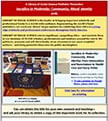
Sacrifice in Modernity (from Brill) (Aug 21, 2018)
Sacrifice seems to belong to a religious context of the past. In Sacrifice in Modernity: Community, Ritual, Identity it is demonstrated how sacrificial themes remain an essential element in our post-modern society. The shaping of community, performing rituals and the search for identity, three main characteristics of traditional sacrifice, are dynamics of our modern times as well which cannot be understood without sacrificial awareness.
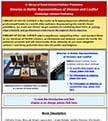
Us and Them: Binaries in Battle (Aug 20, 2018)
Defining things through binary opposition – male/female, familiar/foreign, life/death – forms the base of human thinking. Adding moral assessment to logic, we often represent binaries even as divisions into good and evil. Exclusions based on the division of Us vs. Them make their presence felt during any conflict, and become crucial in times of war. Binaries in Battle: Representations of Division and Conflict is a wide-ranging multidisciplinary anthology that presents the fundamental rationale of binary thinking from many different angles.
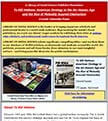
"To Kill Nations" (Cornell University Press) (Aug 20, 2018)
Between 1945 and 1950, the United States had a global nuclear monopoly. The A-bomb transformed the nation’s strategic airpower and saw the Air Force displace the Navy at the front line of American defense. In To Kill Nations, Edward Kaplan traces the evolution of American strategic airpower and preparation for nuclear war from this early air-atomic era to a later period (1950–1965) in which the Soviet Union’s atomic capability, accelerated by thermonuclear weapons and ballistic missiles, made American strategic assets vulnerable and gradually undermined air-atomic strategy.
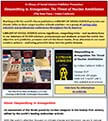
From The New Press: "Sleepwalking to Armageddon" (Aug 20, 2018)
An assessment of the threat posed by nuclear weapons in the twenty-first century, edited by the world’s leading antinuclear activist. With the world’s attention focused on climate change and terrorism, we are in danger of taking our eyes off the nuclear threat. But rising tensions between Russia and NATO, proxy wars erupting in Syria and Ukraine, a nuclear-armed Pakistan, and unsecured stockpiles of aging weapons around the globe make a nuclear attack or a terrorist attack on a nuclear facility arguably the biggest threat facing humanity.
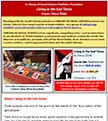
New title by Slavoj Žižek (special sale) (Aug 17, 2018)
About Living in the End Times: Žižek analyzes the end of the world at the hands of the “four riders of the apocalypse.” There should no longer be any doubt: global capitalism is fast approaching its terminal crisis. But if the end of capitalism seems to many like the end of the world, how is it possible for Western society to face up to the end times?
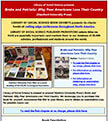
Broke and Patriotic: Why Poor Americans Love their Country (Stanford UP) (Aug 9, 2018)
LIBRARY OF SOCIAL SCIENCE BOOK EXHIBITS presents its clients' books at cutting edge conferences throughout North America. LIBRARY OF SOCIAL SCIENCE PUBLISHER PROMOTIONS selects titles we think are especially important—and markets them to our database of 30,000 scholars, professionals and students around the world. Library of Social Science is pleased to present Stanford University Press's Broke and Patriotic: Why Poor Americans Love Their Country.
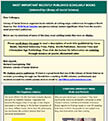
Best recent scholarly books (Aug 6, 2018)
Library of Social Science organizes book exhibits at cutting-edge conferences throughout North America. Our 2018 Book Exhibits (see photos below) contain significant titles from the world's most prominent publishers. Below are my selections of some of the best, most exciting books that were on display.
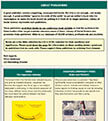
Great publishers (Jul 17, 2018)
A great publisher creates compelling, consequential books. But this is not enough...not nearly enough. A great publisher "goes to the ends of the earth" to get an author's book into the marketplace; to make the book known by putting it in front of its target audience. Library of Social Science represents such publishers.
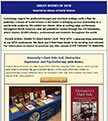
Great books of 2018 (Jul 16, 2018)
Combining respect for profound thought and excellent writing—with a flair for publicity—Library of Social Science is the leader in bringing serious scholarship to a world-wide audience. We exhibit our clients’ titles at cutting-edge conferences throughout North America—and sell publishers’ books through the LSS Newsletter, which reaches 30,000 scholars, professionals and students throughout the world.
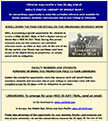
Free 30-day trial: Brill's Digital Library of World War I (Jul 9, 2018)
BRILL is providing a special opportunity for Libraries to receive a FREE 30-DAY TRIAL of Brill’s Digital Library of World War I FREE 30-DAY TRIAL During this period, everyone may use this resource—an unrivalled reference work—as often as they wish. At the end of the 30-day period, your library may purchase—and have access to the digital library in perpetuity—or simply cancel with no obligation.
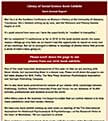
Semi-annual report with photos (Jun 7, 2018)
We've completed 11 conferences so far in 2018. In the book exhibit world—for some reason—things go so fast—so we haven't had the opportunity to report on every one of our meetings. But we've arranged a tableau or montage of photos below that provide a sense of what's been going on. One of the most important developments of this year—is that we are working with fewer clients, but representing them in a deeper way. Please scroll down the page to see full table displays for Brill, Polity, The New Press, American Psychological Association and Springer Publishing Company.
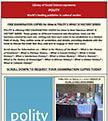
Free examination copies—from POLITY (May 24, 2018)
POLITY is offering FREE EXAMINATION COPIES for titles in their fabulous WHAT IS HISTORY SERIES. These guides to different historical sub-disciplines mark out the territory covered by each one, setting out how each came to be established as a distinct field of study. They outline areas of contention and debate, providing students with the tools to discuss the texts that they read and to engage in their own work.
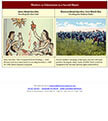
Warfare as submission to a sacred object (May 24, 2018)
Aztec Ritual Sacrifice: Feeding the Sun God - Aztec Sacrifice. Post-Conquest Nahua Painting, c. 1560. (Priests hold excavated
heart to sun atop teocalli) c. 1650 ref 1500 Aztecs Spanish Conquest. Western Ritual Sacrifice, First World War: Feeding
the Nation-State - French soldiers charging, in the open, toward a German position during the early weeks of WWI. Most
would be slaughtered by German machine guns and artillery.
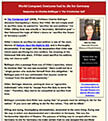
The cancer of individualism (May 23, 2018)
Cox discusses Koenigsberg’s critique of the “masculinity” of warriors. Whereas the soldier in battle is often viewed as the
essence of virility, in fact the opposite is the case: the soldier’s role is one of abject masochism. He is someone
who “offers himself to be slain.” In fact, Cox notes that depiction of the soldier as virile and aggressive is a significant
dimension of the sacrificial dynamic itself, citing Koenigsberg as follows: “We encourage the soldier’s delusion of
masculine virility and call him a hero—in order to lure him into becoming a sacrificial victim.”

World conquest: everyone had to die for Germany (May 23, 2018)
Killing and dying, Koenigsberg demonstrates, amounted to the same thing. Dying was the way in which one demonstrated one’s
devotion to Germany. This was the fundamental objective of Nazism. The purpose of killing was to compel others (non-Germans)
to die for Germany—to make certain that no one escaped the sacrificial obligation. Hitler went to war to “conquer the
world,” that is, to compel everyone to do what he eventually did—die for Germany.
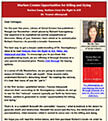
War creates opportunities for killing & dying (May 22, 2018)
For the past few years, Library of Social Science has published—though our Newsletter—short pieces by Richard Koenigsberg.
Our objective is to crystallize his central propositions or theorems. Many of you, however, have asked us to contextualize
Richard theories—to provide a broader framework. The best way to get a deeper understanding of Dr. Koenigsberg’s ideas
is to read Nations Have the
Right to Kill: Hitler, the Holocaust and War.
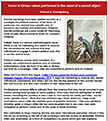
Terror as Virtue (May 15, 2018)
My research for the past thirty years bears out Atran’s hypothesis: political violence is often carried out as a “sublime
matter of moral virtue.” The springs of popular government, Robespierre declared, are “at once virtue and terror: virtue,
without which terror is fatal; terror, without which virtue is powerless.” Virtue and terror: violence carried out with
a sense of moral righteousness.
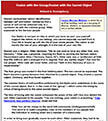
Fusion with the Group/Fusion with the Sacred Object (May 14, 2018)
Hitler sought to melt the German people together—to fuse them into one. He insisted that each and every German unite with
the national group. He promoted this idea endlessly, insisting that individuals could not exist unless fused with the
group. “The nation is not merely the root of your strength,” he explained to his people, “It is the root of your very
life.”
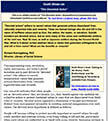
“The Devoted Actor” (Scott Atran) (May 10, 2018)
“Devoted actors” adhere to sacred values that generate actions dissociated from rationally expected risks and rewards. These
are human beings who die and kill in the name of ineffable values such as God, the nation, the leader, or salvation.
Suicide bombers are devoted actors, but so were many of the union and confederate soldiers of the civil war, Nazi SS-men,
as well as Japanese soldiers during the Second World War. What is it about certain abstract ideas or ideals that generates
willingness to die and kill in their name? What are the benefits or rewards?
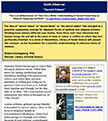
Sacred Values (Scott Atran) (May 10, 2018)
The idea of “sacred values” or “sacred ideals” or “the sacred object” has emerged as a powerful explanatory concept for disparate
forms of political and religious violence. Working from entirely different case studies, Scott Atran and I have theorized
that human beings die and kill in the name of ideas or values or entities to which they feel profoundly attached. In
a series of Newsletters, Library of Social Science will present this concept—as the foundation for a scientific understanding
of collective forms of violence.
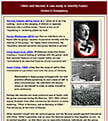
Hitler & Nazism: A case study in identity fusion (May 7, 2018)
Hitler claims that at the conclusion of one of his speeches, adherents and adversaries both had fused into a single enthusiastic
mass. Above all else, Hitler aspired to fuse the German people into a single, united body. When it comes to the large
community, the formation of a “group” is not automatic or self-evident. It is not given, a priori. Hitler understood
this—recognized that his job as leader was to bring the German people together.
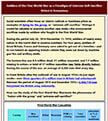
Extreme self-sacrifice in the First World War (May 3, 2018)
In Great Britain after the outbreak of war in Aug 1914—in just eight weeks—over three-quarters of a million men in Britain
had volunteered. Between the period of August 1914 and December 1915—2,466,719 men had joined the British army voluntarily.
How can the study of the First World War illuminate the phenomena of “fusion with the group” and “extreme self-sacrifice?”
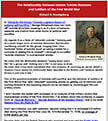
Islamic suicide bombers & soldiers of the First World War (May 2, 2018)
In “Dying for the Group: Towards a general theory of extreme self-sacrifice,” George Whitehead does not “wall-off” suicide
terrorism—treating it as if a form of behavior separate and distinct from other forms of political self-sacrifice. He
regards it as a form of “altruistic suicide,” forming part of a much larger class of extreme behaviors that involve
sacrificing oneself for the group.
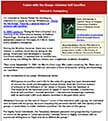
Fusion with the group—extreme self-sacrifice (Apr 30, 2018)
I’m indebted to Steven Pinker for drawing my attention to a paper by Harvey Whitehouse, “Dying for the Group: Towards a general
theory of extreme self-sacrifice.” In 1990 I spoke on “Dying for One’s Country” at a meeting of the International Society
of Political Psychology. During the period 1990-2000, I presented papers on this topic (N = 50) in nearly every academic
discipline.

Extreme self-sacrifice (Apr 26, 2018)
How deluded people are when they focus on Islamic radicals and Kamikaze pilots as examples of dying for the group and “extreme
self-sacrifice.” These men are pikers compared with the soldiers of the First World War. Western people are in denial
of their own history.

Broke and Patriotic: Why Poor Americans Love their Country (Stanford UP) (Apr 26, 2018)
LSS exhibits our clients' books at cutting edge conferences throughout North America. We promote selected, recent titles
to our database of 30,000 scholars, professionals and students around the world. We are pleased to present Broke and
Patriotic: Why Poor Americans Love Their Country, an important volume that sheds new light on this sector of American
society. We encourage you to order a copy of this book for yourself, and for your library.
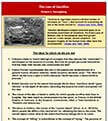
The Law of Sacrifice (Apr 26, 2018)
Cultures create or invent ideological concepts that they elevate into “absolutes”— worshipped as the essence of society.
But how do people persuade themselves that the ideas their society has constructed are real? Franco Fornari hypothesizes
that war is the spectacular establishment of a general human situation whereby “death assumes absolute value.” The ideas
for which we die have a right to truth—because “death becomes a demonstrative process.”
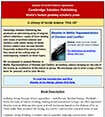
Binaries in Battle (Cambridge Scholars Publishing)—pick hit (Apr 26, 2018)
Cambridge Scholars Publishing has produced an astonishing array of original edited collections—many of them dealing with
issues of political violence and warfare—with which Library of Social Science readers have become familiar. Frequently
authored by young scholars, they stand at the cutting edge of contemporary research on these topics.
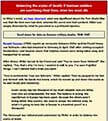
Balancing the scales of death (Apr 25, 2018)
In Hitler’s mind, we have observed, what was significant about the First World War was that the best men had died, whereas
the worst men had survived. Hitler was deeply disturbed by what he perceived as a profound injustice. Scroll down for
data on German military deaths, 1940-1947.
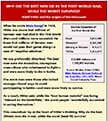
Why do the best men die in war, while the worst survive? (Apr 25, 2018)
When he wrote Mein Kampf in 1924, Hitler was aware that millions of German men had died in the First World War—and millions
more wounded. He knew that millions of German men would not pass their genes along—a case of “negative selection.”
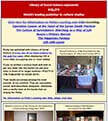
Exciting new titles from POLITY (Apr 24, 2018)
Polity has exhibited with Library of Social Science at every one of our book exhibits for the past five years, often displaying
100 or more titles (occupying two or more tables). If you’ve written a serious book and wish to get you ideas into the
world—to put your titles in front of its target markets—POLITY IS THE PUBLISHER TO WORK WITH.
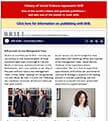
Publishing with Brill (Apr 24, 2018)
One of the world's oldest and greatest publishers—and also one of the easiest to work with. Need support prior to submitting
your manuscript? Make the process of preparing and submitting a manuscript easier with Brill's suite of author services,
an online platform that connects academics seeking support for their work with specialized experts who can help.
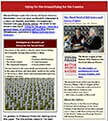
Dying for the group/dying for the country (Apr 23, 2018)
Steven Pinker reads the Library of Social Science Newsletter—and has been particularly interested in a piece we recently
published, Koenigsberg's Second Law (see directly below). He wrote to me about a new paper, Dying for the group: Towards
a general theory of extreme self-sacrifice (Harvey Whitehouse), published in Behavioral and Brain Sciences.
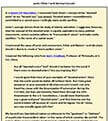
Lenin, Hitler—and Abraham Lincoln (Apr 19, 2018)
My Second Law (see below) makes no reference to the “goodness” or “badness” of a particular transcendent value—in the name
of which societies die and kill. The nature of the cause—and the mechanism by which the cause is validated—are orthogonal.
Dying and killing represent vehicles for verification—the manner in which the value (or “truth”) of the transcendent
value is established. Dying and killing constitute proof of devotion.
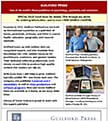
Special sale: Guilford titles in psychology, psychiatry and education (Apr 12, 2018)
Founded in 1973, Guilford Publications has built an international reputation as a publisher of books, periodicals, software,
and DVDs in mental health, education, geography, and research methods. Guilford teams up with authors who are recognized
experts, and who translate their knowledge into vital, needed resources for practitioners, academics, and general readers.
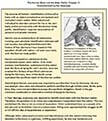
Overwhelmed by the sovereign (the human body & the body politic) (Apr 11, 2018)
The essence of Nazism: identification of the self or body with an object conceived as omnipotent and immortal—one’s nation.
Hitler asked each individual to abandon concern for his or her own body, and to connect only with the German body politic.
Identification required renunciation of personal and private interests.
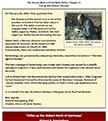
Curing the nation's disease (Apr 10, 2018)
Just as Robert Koch had discovered the bacillus that caused tuberculosis, Hitler imagined he had discovered the bacillus
that was the cause of Germany’s disease. Removal of “Jewish bacteria” from within the body politic, in Hitler’s mind,
was tantamount to a “cure.” In a nutshell, this was the theory—fantasy—that gave rise to the Final Solution.
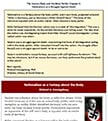
Nationalism as a struggle against death (Apr 10, 2018)
Nationalism is a fantasy about the body politic: one’s own body, projected outward. “Hitler is Germany, just
as Germany is Hitler (Rudolf Hess):” The body of the individual equated with an entire nation. Hitler
became a body politic. Hitler believed that the German nation was in a state of “disintegration.” This
was a claim he made repeatedly. He feared that Germany was falling apart. The idea that the nation was disintegrating
meant that Hitler himself would disintegrate—unless radical action was taken.
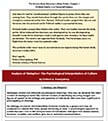
The human body becomes a body politic (Apr 6, 2018)
One doesn’t need to “psychoanalyze” political figures to grasp where they are coming from. They reveal themselves through
the words they use: the images and metaphors contained within their rhetoric. Political leaders project their desires
and fantasies into the external world. Political reality is a projected fantasy. Political leaders project their bodies
into reality. Their own bodies become the body politic.
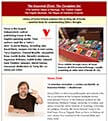
The Essential Žižek (Verso) (Apr 5, 2018)
Verso is making four of Žižek's classic titles—that stand as the core of his ever-expanding life’s work—available as new
editions. Each is beautifully repackaged, including new introductions from Žižek himself. Simply put, they are the essential
texts for understanding Žižek’s thought and thus cornerstones of contemporary philosophy.
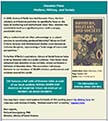
Mothers, Military and Society (Demeter Press) (Apr 4, 2018)
In 2006, Andrea O’Reilly founded Demeter Press, the first scholarly and feminist publisher to specifically focus on the topic
of mothering and motherhood. Since then, Demeter has established itself as a significant press—with a unique, passionate
voice. Why is motherhood not often acknowledged as a subject position in constituting gendered identities?
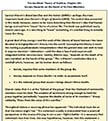
The flow of blood will be eternal (Apr 2, 2018)
Carolyn Marvin states that “Blood sacrifice preserves the nation.” Deputy Fuhrer to Adolf Hitler, Rudolf Hess declared that
“The stream of blood which flows for Germany is eternal—the sacrifice of German men for their Volk is eternal—therefore
Germany will also be eternal.” The Nazis understood the sacrificial theory of warfare. Not only did they understand
it, they embraced and enacted it. No society in history affirmed with such passion the proposition that “blood sacrifice
maintains the nation.”

Wiping out the vermin (Apr 2, 2018)
Hitler had posed the question: Why do the best men die in war (those that volunteer for military service); whereas the worst
men (those that shirk their duty to fight) survive? Then, however, he took this logic a step further, making a “discovery”
that was to have momentous implications. Upon returning home from the Western Front on leave, he said that he found
that “all the offices were filled with Jews.”

If the best men die, shouldn't the worst men die as well? (March 30, 2018)
In Allowing the Destruction of Life Unworthy of Life (1920), Hoche and Binding had posed the question: Why was Germany so
promiscuous with the lives of some of its citizens (e. g., soldiers), while taking such care preserving the lives of
other German citizens (e. g., mental patients in institutions). This question tied to a broader conundrum: why do the
most valuable members of society live, while the least valuable members die?

Fetishizing the idea of "dying for one's country" (March 30, 2018)
We now understand the ideological proposition—the logic—that led to Nazi mass murder: If the state is willing to sacrifice
the lives of its soldiers, why should so many resources be expended to keeping mental patients alive? If the nation
is willing to kill its most valuable possession—those who make the greatest contribution to the state—why can’t it also
kill human beings who have no value—make no contribution to the state?

The Logic of Mass-Murder (March 30, 2018)
Hoche and Binding were posing, albeit obliquely, the same question I have been posing for the last twenty-seven years: Why
were young men during the First World War asked to get out of trenches for four years and to run into machine-gun fire
and artillery shell (two million German dead and over four million wounded)? The authors could not pose the central
question: Why is Germany so promiscuous with the lives of young men, allowing them to be slaughtered in battle?

Everyone must die for Germany (March 28, 2018)
There are no secrets about Hitler; nothing hidden. He said what he said, and did what he said he would do. To understand
the Holocaust and the war the Nazis waged, we need to pay close attention to Hitler’s words. Declaring war on Sep
1, 1939, Hitler stated that he was asking every German to “lay down his life” for their people and country. This was
the fantasy that generated warfare, which Hitler enacted: that Germans would die for Germany.

Who won the cold war? (March 27, 2018)
The photo below shows Dr. Vamik Volkan with Mikhail Gorbachev. Reading the LSS Newsletter, you’ll discover that you’ll find
evidence that Volkan’s relationship with Gorbachev—and the field of political psychology—played a role in the fall of
the Berlin Wall (Nov 9, 1989). The narrative of this event, of course, was that it marked America’s victory in
the Cold War; the triumph of freedom over tyranny.

The Totem Secret—is Secret No More (March 22, 2018)
Marvin states that knowledge that the group must sacrifice its own to survive is “a secret.” Due to the work of Library of
Social Science—those who publish with us, and those who continue to read the LSS Newsletter—this secret is secret no
more. We now recognize that the fundamental purpose of political violence is not to achieve concrete, practical objectives,
but to sacrifice (that is to say—kill) members of society.

Soldiers as the “Sacrificial Class” (March 22, 2018)
Sacrifice to the totem god—the nation—Marvin suggests, implies the existence of a “religious community of devotees” who perform
the sacrificial mission. This community is the military. While it may “strain conventional wisdom” to think of soldiers
as a “religious class,” General Douglas MacArthur told graduating West Pointers in 1962 that they as soldiers, above
all other men, were required to practice the “greatest act of religious training—sacrifice.”

The Enemy is the Pretext to Kill the Savior (March 22, 2018)
We tell ourselves that the purpose of war is to kill the enemy. This narrative has sustained the ideology of warfare for
the past one-hundred years. Nations—according to our conventional way of thinking—go to war to “defeat” an enemy that
threatens national security. Marvin says that the fundamental purpose of warfare is to sacrifice members of one’s own
group. If the ritual of war is to work, however, we can’t allow ourselves to be aware of this.

The victim is willing (March 22, 2018)
According to Carolyn Marvin (1999), society “depends on the death of it’s own members at the hands of the group.” The sacrificial
victim, however, is not some outsider group—a “scapegoat”—but is a member of one’s own group, an “insider.” Put bluntly,
the soldier is the fundamental sacrificial victim. On the other hand, while the “violent death of some of its members”
is the “cost of society”—what holds the group together—we are not allowed to know that this is the case.

Society depends on the death of its own members (March 22, 2018)
Carolyn Marvin’s Blood Sacrifice and the Nation (1999) is perhaps the most important book since Darwin’s Origin of Species
(1859). The central idea presented in this book, however, seems to be more disturbing than Darwin’s idea that human
beings evolved from “lower” forms of animal life. The book was published nearly twenty years ago. It is one thing to
“know” something; it's another thing to actually know this thing.
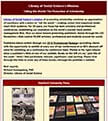
Telling the world: the promotion of scholarship (March 20, 2018)
Library of Social Science’s mission of promoting scholarship combines an appreciation of excellence with a desire to “tell
the world”—making certain that important books reach their audience. For 30 years, our focus has been scholarly and
professional conferences, establishing our reputation as the world’s premier book exhibit management firm. Now we move
toward promoting publishers’ books through the LSS Newsletter—that reaches 30,000 scholars, professional and students
around the world.
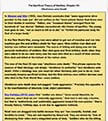
Obedience unto death (March 20, 2018)
In Women and War (1995), Jean Elshtain concludes that “some aggressive drive peculiar to the male sex” did not surface as
the “most potent theme that drove men to their deaths in wartime.” Rather, one “incessant theme” emerged from the hundreds
of “war stories” Elshtain encountered—the theme of sacrifice. The young man goes to war, “not so much to kill as to
die;” to “forfeit his particular body for that of a larger body.”
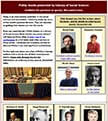
Polity: books by our greatest thinkers: available at special, discounted rates (March 20, 2018)
Polity is an international publisher in the social sciences and humanities—featuring books by some of the world’s greatest
thinkers. They are devoted to getting their books out into the world. Have you experienced a Polity display at a Library
of Social Science Book Exhibit (see photo below)? LSS features Polity titles at every one of our conferences on a full
table (and often on two or three tables). Conferees are invariably excited to discover Polity’s new and significant
publications.
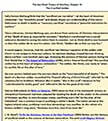
The crucified soldier (March 19, 2018)
Kelly Denton-Borhaug finds that the “sacrificial war narrative”—at the heart of American citizenship—has “Incredible power”
and deeply shapes our understanding of the nation. References to death in battle as “necessary sacrifices” constitute
a “powerful motivation for warfare.” These references, Denton-Borhaug says, are drawn from centuries of Christian interpretation
of the “death of Jesus as required for salvation.”

Brill: Literature/Cultural Studies Collection (free 30-day trial) (March 19, 2018)
COLLEGE INSTRUCTORS AND STUDENTS: Bring or forward this flyer to your librarian explaining that he or she is eligible to
receive free access to this wonderful resource. Once your Library has access, you too will have access. LIBRARIAN: This
collection of important Brill titles in the Social Sciences is available for a free 30-day institutional trial. For
a complete list of the 21 titles included in this collection, please click here.
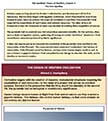
The First Sacrifice (March 16, 2018)
Scholars enjoy writing about the Greeks—individuality, and development of the first democracy. But the West began with Egyptian
civilization, which flourished for over three-thousand years. Here we witness the origin of civilization in sacrifice—the
pyramids—that required the expenditure of vast human and material resources. The labor of tens-of-thousands of men for
thousands of years was devoted to building these megalithic structures.
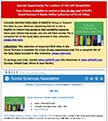
Free 30-day trial: Brill's Social Science Collection (March 15, 2018)
COLLEGE INSTRUCTORS AND STUDENTS: Bring or forward this flyer to your librarian explaining that he or she is eligible to
receive free access to this wonderful resource. Once your Library has access, you too will have access. For a complete
list of the forty titles included in this collection, please click here. LIBRARIAN: This collection of important Brill
titles in the Social Sciences is available for a free 30-day institutional trial.
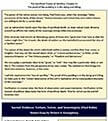
The proof of the pudding is in the dying and killing (March 15, 2018)
The power of the nation comes into being, Paul Kahn says, when the sovereign “takes possession of the body of the citizen.”
Nations become real—what they are—when citizens are willing to die for a sacred ideal. Just as nationalism builds upon
the idea of sacrificial death, so does radical Islam. Blowing oneself up affirms the reality of the sovereign; brings
Allah into existence.
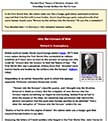
Shoveling human hearts and bodies into the furnace (March 14, 2018)
British political leader David Lloyd George stated (Haste, 1977) that every nation during the First World War conducted its
military activities as if there were no limit to the number of young men who could be “thrown into the furnace to feed
the flames of war.” The First World War was a perpetual, driving force that “shoveled warm human hearts and bodies by
the millions into the furnace” (Gilbert, 2004).
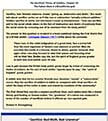
The nation-state is a bloodthirsty god (Strenski & Koenigsberg) (March 14, 2018)
A soldier who dies for his country Strenski says, becomes “sacred;” a “consecration” occurs. May the sacrifice of soldiers
in battle be compared with ritual sacrifice—in which the body of the victim is eaten and shared by members of the community?
The First World War was like a massive sacrificial ritual, each nation-state like a blood-thirsty god feeding on human
bodies. The “greatness” of a nation was measured in terms of the number of sacrificial victims it offered up: loss equaled
gain.
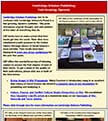
Free downloads on warfare (Cambridge Scholars Publishing) (March 13, 2018)
Cambridge Scholars Publishing (not to be confused with Cambridge University Press) is a fast growing, dynamic publisher.
This press champions original thought, and puts authors at the heart of everything they do. CSP works hard to make certain
that their books get into the world. Their titles have established a solid presence in the United States—through Library
of Social Science’s book exhibits. Their books have been displayed at every one of our conferences for the past four
years.
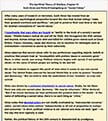
Sacred values (Scott Atran and Richard Koenigsberg) (March 13, 2018)
After many years of research on terrorism, Scott Atran has moved from an evolutionary psychological perspective toward the
view that human beings “make their greatest exertions and sacrifices,” not just to preserve their own lives or kin,
but for abstract conceptions of “sacred values.” I hypothesize that wars often are fought to “testify to the truth of
a society’s sacred ideals.” Middle-Eastern radical die and kill for Allah. But throughout the 20th century and beyond,
human beings have died and killed for entities given names such as Great Britain, France, Germany, Japan and America.
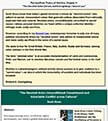
The "Devoted Actor" (Atran) and Koenigsberg's Second Law (March 12, 2018)
Scott Atran shows how today’s global terrorism is driven by “devoted actors” who adhere to sacred, transcendent values that
generate actions dissociated from rationally expected risks and rewards. Devoted actors, unconditionally committed to
sacred causes—whose personal identities are fused within a unique collective identity—willingly make costly sacrifices.
However, according to my Second Law, contemporary terrorism is only one of many political movements driven by “devoted
actors.”
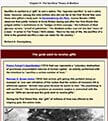
Gods exist to receive gifts (March 5, 2018)
Sacrifice in warfare is a “gift” to one’s nation. The “supreme sacrifice” is one’s entire body. However, among the nine-million
who did not die in the First World War were those who gifted a body part. In Dismembering the Male, Joanna Bourke (1996)
observed that public rhetoric in Great Britain during and after the First World War judged soldier’s mutilations to
be “badges of their courage,” the hallmark of their glorious service, “proof of patriotism.” The disabled soldier was
not less but “more of a man.”
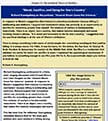
Blood, Sacrifice, and Dying for One's Country (March 5, 2018)
In response to Bloom’s suggestion that violence is a bonding mechanism because killing is exhilarating and addictive, I argued
that humankind values war primarily as an opportunity to sacrifice for something greater than oneself. The violence
of warfare is fundamentally masochistic. There is an object, one’s country, that makes violence meaningful and moral.
Invoking Horace’s phrase, “It is sweet and honorable to die for one’s country,” I suggested that the sacrificial ideology
is at the core of Western civilization.
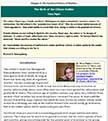
The Birth of the Citizen Soldier (March 5, 2018)
The nation, Pajari says, “needs sacrifices.” Willingness to fight is essentially “moral in nature.” In nationalism, the fatherland
is the “greatest love object of all.” Men do not enter battle because of “male aggression;” they enter battle to prove
their love. Dying in battle is the greatest act of love. If male citizens are not willing to fight for the country,
Pajari says, the nation is “in danger of oblivion.” A nation of weak, effeminate men “does not have a right to exist.”
As Carolyn Marvin has observed, “blood sacrifice creates the nation.”
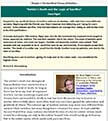
Soldier's Death and the Logic of Sacrifice (March 5, 2018)
Support for my sacrificial theory of warfare continues to develop—with data from many different societies. Beginning with
the Finnish case, Pajari observes that defending and “dying for one’s country” is the ultimate sacrifice. Only the best
citizens can manage this—being an able-bodies male is the first qualification. In Europe during the 19th century, Pajari
says, love for the homeland was supposed to be taught at home, especially by mothers. This was their essential role
in the nation.
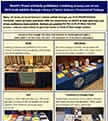
World's finest scholarly publishers: devoted to authors (March 3, 2018)
World’s finest scholarly publishers: Exhibiting at every one of our 2018 book exhibits through Library of Social Science’s
Promotional Package Many of Library of Social Science’s clients exhibit through our 2018 PROMOTIONAL PACKAGE, which
provides publishers with the opportunity to exhibit at each and every one of our conference book exhibits. Authors are
grateful for the work of these devoted presses—who are determined to get their books in front of their target market.
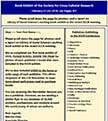
Photos and report: Society for Cross Cultural Research (February 27, 2018)
We’ve completed our first book exhibit of 2018. PLEASE SCROLL DOWN THE PAGE for photos of each publisher’s books that were
included in the SCCR exhibit. We’ve also included LINKS to the home or order page of each publisher. This allows recipients
of this LSS Newsletter to learn more about each press—and to purchase books. You are receiving this Newsletter because
you are a publisher. However, we are sending a similar flyer to our database of 30,000 scholars, professionals and students
around the world (many of whom are authors).
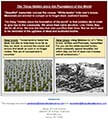
The thing hidden since the foundation of the world (February 26, 2018)
“Beautiful” memorials conceal the corpse. “White-tombs” hide men’s bones. Memorials are erected to compel us to forget dead,
mutilated bodies. The thing “hidden since the foundation of the world” is that soldiers die in order to give rise to
the community. We adore their naïve devotion. Like Christ, they die for all of us. We love the idea that men sacrifice
their lives. But we don’t want to be reminded of the ugliness of dead and mutilated bodies.
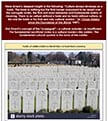
The tomb of the soldier (Rene Girard) (February 26, 2018)
Rene Girard’s deepest insight is the following: “Culture always develops as a tomb. The tomb is nothing but the first human
monument to be raised over the surrogate victim, the first and most elemental and fundamental matrix of meaning. There
is no culture without a tomb and no tomb without culture; in the end the tomb is the first and only cultural symbol.”
(in
Things Hidden since the Foundation of the World, 1987).
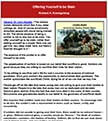
"You offer yourself up to be slain" (February 22, 2018)
General Sir John Hacket: “The military makes demands which few if any other callings do. And of course emotionally disturbed
people talk about being trained to kill. The whole essence of being a soldier is not to slay but to be slain. You offer
yourself up to be slain, rather than setting yourself as a slayer. Now one can get into very deep water here, but there’s
food for thought in it.”
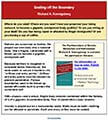
Boundary of the self, boundary of the nation (February 22, 2018)
Where do you exist? Where are you now? Have you projected your being outward, to become a gigantic, omnipotent body (politic)?
Or are you sitting at your desk? Do you fear being raped or attacked by illegal immigrants? Or are you having a cup
of coffee. Anxiety is played out on a monumental scale. Walls must be built—nothing can be allowed to penetrate. Each
and every orifice must be sealed.
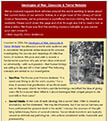
Ideologies of War Website—exciting resource for scholars (February 13, 2018)
We’ve received requests from scholars around the world wanting to know about the current status of our website. Below, in
a single issue of the Library of Social Science Newsletter, we’ve presented a crystallized version—listing the items
now available. Please scroll down the page and click through any link to read a text or view a video. We hope you find
this exciting resource valuable as you pursue your own research.
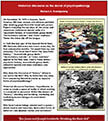
Historical discourse as the denial of psychopathology (February 9, 2018)
Why does the discourse of “history” refuse to use terms like this? Why do historians shy away from conceiving historical
events as massive forms of psychopathology? Historical discourse functions, I hypothesize, in order to create a space
of reality in which nothing is conceived as abnormal. Within the domain of “history,” shooting and bombing, murdering
and mutilating human beings—is considered normative.
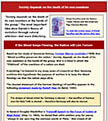
Society depends on the death of its own members (February 8, 2018)
“Society depends on the death of its own members at the hands of the group.” The most important idea since Darwin’s theory
of evolution through natural selection—but more disturbing. Based on her study of American history, Carolyn Marvin concludes
(1999) that “Blood sacrifice preserves the nation.” Society depends on the death of its own members at the hands of
the group. War is a ritual in which the “lifeblood” of the members of a nation are shed.
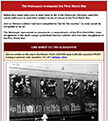
The Holocaust re-enacted the First World War (February 8, 2018)
Before they used cattle cars to send Jews to die in the Holocaust, Germans used (the same) cattle cars to send their soldiers
to die en masse in the First World War. Just as German soldiers had been compelled to "die for the country," so Jews
would be compelled to do so. The Holocaust represented an enactment—a reenactment—of the First World War: Jews slaughtered
in the death camps symbolized German soldiers who had been slaughtered in the First World War.
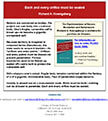
Fear of national penetration (January 31, 2018)
Nations are conceived as bodies. We project our own body into a national body. One’s fragile, vulnerable self is blown up—to
become a gigantic, omnipotent self. Because territory is imagined in corporeal terms (Neocleous), the state seeks to
secure it borders—its “orifices and entry points.” Orifices and entry points must be closed—to prevent penetration.
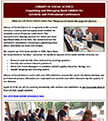
Organizing and managing book exhibits for scholarly conferences (January 25, 2018)
Library of Social Science is recognized as the premier company creating and managing book exhibits for scholarly and professional
conferences. Our comprehensive displays present the latest and most significant titles in the field. Our exhibits enrich
the conference experience—becoming a gathering place where attendees can meet and mingle.
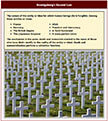
Koenigsberg's Second Law (Jan 25, 2018) The nature of the entity or idea for which human beings die is fungible.
The mechanism is the same: death and memorials erected in the name of those who have died—testify to the reality of
the entity or ideal. Death and memorialization perform a validation function.
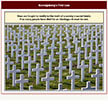
Koenigsberg's First Law (Jan 25, 2018) Wars are fought to testify to the truth of a society’s sacred ideals. If
so many people have died for an ideology—it must be real.
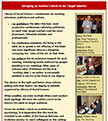
Bringing an author's book to its target market (Dec 20, 2017)
When possible, we order multiple titles—and conduct book signings. We want the author's work to be known—to reach its target
audience. If one has written a book on evolutionary psychology, it is imperative that this book be included in the exhibit
of the Human Behavior and Evolution society: to reach colleagues on the cutting-edge of developing this field.
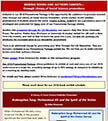
Making your books and authors famous (Dec 19, 2017)
Included in our 2018 Promotional Package is the opportunity for publishers to promote selected titles through our Library
of Social Science Newsletter, which reaches 30,000 scholars, professionals & students around the world. PLEASE SCROLL
DOWN to see a promotion piece LSS developed and promoted for Verso (one of our Promotional Package clients).
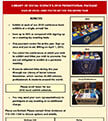
Extraordinary saving: exhibit through our 2018 Promotional Package (Dec 19, 2017)
Exhibit at each of our 2018 conference book exhibits at a single, annual fee. Save up to 80% as compared with signing up
on a meeting-by-meeting basis. One payment covers the entire year. Sign up once and you’re set. Billing on Apr 1,
2018. You select the conferences at which you wish to exhibit and titles you wish to promote. You are not obligated
to exhibit at a particular meeting.
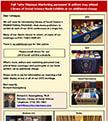
Full Table Displays (Dec 15, 2017)
We will soon be introducing Library of Social Science's PROMOTIONAL PACKAGE—that allows publishers to exhibit at each of
our 2018 conferences at a single fee. Many of our clients choose to select—at some of our meetings—a FULL TABLE DISPLAY.
There is no additional cost for this option. What's more, editors and marketing personnel may attend these meetings—and
participate in our book exhibit—at no additional charge.
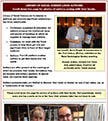
Library of Social Science loves authors (Dec 13, 2017)
Library of Social Science—in its mission to publicize and promote significant scholarship—has three constituents. Conference
organizers & attendees: our exhibits enhance the intellectual value and success of meetings at which we organize & manage
book exhibits. Publishers: we work with the finest presses to help them get new and significant titles in front of their
target audience. Authors: The LSS platform enables authors to get their books into the world.
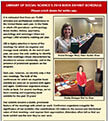
2018 Book Exhibit Schedule (Dec 13, 2017)
It is estimated that there are 15,000 scholarly and professional conferences in the United States each year. In the fields
in which LSS specializes—anthropology, Asian studies, history, psychiatry, psychology and sociology—there are perhaps
1,000 scholarly meeting per year. LSS is highly selective in terms of the meetings for which we organize and manage
book exhibits.
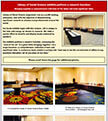
LSS Book Exhibits perform a research function (Dec 12, 2017)
Library of Social Science originated—not as a profit-making enterprise—but with the objective of disseminating significant
research to scholars and professionals around the world. Our book exhibits begin with this mission. LSS is unique in
the time and energy we devote to research. We make a special effort to identify and display books authored by speakers.
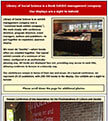
An LSS book exhibit is a sight to behold (Dec 11, 2017)
Library of Social Science is an exhibit management company (not a “combined book exhibit company”). We work closely with
conference directors, program directors, event managers, authors and publishers—to put together an expansive, spacious
display. Our exhibits are unique in terms of their size and scope. At a typical conference, we represent 25-35 publishers,
with 200-350 books in the display. Our exhibits are a sight to behold.
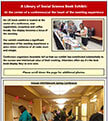
LSS book exhibits: the heart of a conference experience (Dec 11, 2017)
An LSS book exhibit is located at the center of a conference, near registration, receptions and coffee breaks. Our display
becomes a locus of the meeting. Our exhibit constitutes a significant dimension of the meeting experience; a place where
conferees of all ranks meet and mingle. Conference organizers invariably tell us that our exhibit has contributed substantially
to the success and intellectual value of their meeting. Attendees often say it’s the best book display they’ve ever
seen.
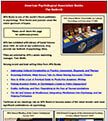
Books from American Psychological Association: the bedrock (Dec 7, 2017)
APA Books is one of the world’s finest publishers in psychology. Their books and journals cover the entire spectrum of topics.
APA has exhibited with Library of Social Science since 2009. At each of our conferences, they provide our bedrock of
psychology titles. Titles are selected by APA’s astute marketing manager, Tom Wolfe. Conferees at our meetings rely
on APA Books to become aware of the latest trends—and most significant publications—in psychology.
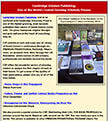
World's fastest growing scholarly press: Cambridge Scholars Publishing (Dec 7, 2017)
Cambridge Scholars Publishing (not to be confused with Cambridge University Press) is one of the fastest growing, most dynamic
publishers that Library of Social Science works with. The press champions original thought and puts authors at the heart
of everything they do. CSP offers the wonderful service of allowing readers to sample the first chapter of each of their
books.
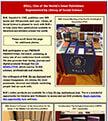
Brill: one of the world's great publishers (Dec 7, 2017)
Brill, founded in 1863, publishes over 800 books and 200 journals each year. Library of Social Science is pleased to work
with Brill—to help make their publications available to librarians and scholars around the world. Brill participates
in our PREMIUM PROMOTIONAL PACKAGE, exhibiting at every one of our conference book exhibits. We also promote their books,
journals and digital products through the LSS NEWSLETTER, which reaches 30,000 scholars, professionals and students.
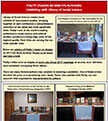
Polity stands behind its authors (Dec 5, 2017)
Library of Social Science creates book exhibits of unsurpassed quality, bringing together at each conference a comprehensive
collection of the latest and most significant titles. Polity—one of the world’s leading publishers in social science
and cultural studies—produces cutting-edge work of the highest quality.Their titles are among the our most popular ones.
Below are photos of Polity’s books on display at 2017 LSS Book Exhibits. Please scroll down and take a look.
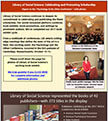
Library of Social Science: Celebrating and Promoting Scholarship (Dec 1, 2017)
Library of Social Science continues to deepen its commitment to celebrating and publicizing the finest scholarship. Our world-renowned
platform combines book exhibits, book promotions, and writings by prominent authors. We’ve completed our 2017 book exhibit
cycle. From a multitude of conferences, LSS selects cutting edge meetings that define the state of the art in a field.
One exciting event, the Psychology and the Other Conference, occurred in the rich pastures of Cambridge, Massachusetts,
Oct 13-15.
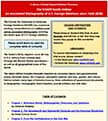
Free access: U.S. Foreign Relations (Brill) (Oct 31, 2017)
The Society for Historians of American Foreign Relations (SHAFR) has created an exciting, comprehensive 2.1 million-word
online annotated bibliography covering the entire span of U.S. foreign relations. The Guide’s thirty chapters cover
all eras in U.S. history from colonial days through the Barack Obama presidency—as well as all geographical areas of
the world.
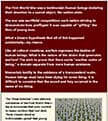
Warfare as Devotion (Oct 31, 2017)
The First World War was a testimonial: human beings declaring their devotion to a sacred object, the nation-state. The war
was sacrificial competition: each nation striving to demonstrate how profligate it was: capable of “gifting” the lives
of young men. What a bizarre hypothesis that all of this happened accidentally—by chance. Like all cultural creations,
warfare expresses the desires of human beings. What is the nature of the desire that generates warfare?
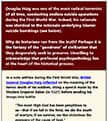
World War I as a Suicide Operation (Oct 30, 2017)
Douglas Haig was one of the most radical terrorists of all time, conducting endless suicide operations during the First World
War. Indeed, his rationale was identical to the rationale underlying Islamic suicide bombings. Why do historians run
from the truth? Perhaps it is the fantasy of the “goodness” of civilization that they desperately seek to preserve.
Unwilling to acknowledge that profound psychopathology lies at the heart of the historical process.
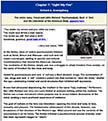
"Light My Fire" (Oct 30, 2017)
In the Sixties, ideas of radical psychoanalytic thinkers such as Reich, Brown and Marcuse—and rock and roll music—converged,
leading to psychic and cultural transformations that altered the American character. The revolution of the Sixties,
simply put, was a struggle to attain freedom from society—in the name of freedom for the mind and body.
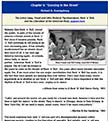
"Dancing in the Street" (Oct 30, 2017)
This book examines how rock ‘n’ roll was part of a developmental dynamic within American society—leading to the liberation
of sexuality. But initially, rock ‘n’ roll was primarily about physical exuberance and dancing. To say that rock and
roll led to the liberation of sexuality is not to say that rock and roll was primarily about sex. In spite of efforts
to find “dirty lyrics,” early rock and roll was about movement, dancing, excitement, and energy.
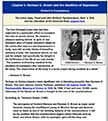
Norman O. Brown and the Abolition of Repression (Oct 28, 2017)
Perhaps no thinker played a more significant role in liberating sexuality than Norman O. Brown. This once-obscure classics
Professor published Life against Death: The Psychoanalytic Meaning of History in 1959. By 1966, it had sold over 50,000
copies. Historians of the Sixties see Brown’s thought at the core of the counterculture.
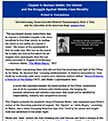
Norman Mailer, the Hipster and the Struggle Against Middle-Class Morality (Oct 27, 2017)
Norman Mailer was among those who did not find the sweetness and light of the Fifties to his liking. He declared that “creeping
totalitarianism” in America amounted to “slow death by conformity with every creative and rebellious instinct stifled.”
Morris Dickstein, a historian of the Sixties (1977), calls Mailer’s psychopathic hero "a bomb that explodes beneath
the bland surface of the Fifties.
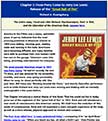
Release of the “Great Ball of Fire” (Oct 27, 2017)
America in the Fifties was a sunny, optimistic place. A survey indicated that the most pressing problems in American schools
in 1950 were talking, chewing gum, making noise and running in the halls. Americans were becoming affluent, and many
families were able to purchase their own homes—with two cars in the garage. Television came into being, providing entertainment
for everyone.
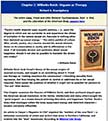
Orgasm as therapy (Oct 26, 2017)
Wilhelm Reich took Freud’s theory of the sexual origins of neurosis seriously, and sought to do something about it. Freud
saw therapy as “making conscious the unconscious”—liberating sexuality from repression, but then helping the patient
to control or sublimate his or her sexual impulses. Reich posed the question of whether it might not be possible for
persons to “live out” their desires.
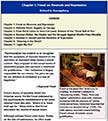
Freud & Little Richard: Psychoanalysis and Rock 'n' Roll (Oct 26, 2017)
Freud’s theory of sexuality shook the Victorian world. Yet the Freud embraced by the psychoanalytic establishment is the
sober, rational Freud who said, “Where id is, there shall ego be.” Many believe that Freud advocated the control of
sexual desire. Although perhaps Freud came down, finally, on the side of sublimation, he often made statements such
as “We may well raise the question whether our ‘civilized’ sexual morality is worth the sacrifice which it imposes on
us.”

Free access to Brill's "Weapons of Mass Destruction" (Oct 24, 2017)
The documents in this new online collection - quietly declassified since the late 1970s - explain the role of nuclear, chemical,
and biological weapons in a series of world crises, how they shaped U.S. and NATO defense and foreign policy during
the Cold War, and what incidents and nearly averted disasters happened. Moreover, they shed a light on the dreadful
human and ecological legacy left by decades of nuclear, chemical and biological weapons manufacturing and testing in
the U.S. and overseas.

Ideology, metaphor and unconscious fantasy (Oct 20, 2017)
Scroll down the page to read Richard’s paper, “Ideology, Metaphor and Unconscious Fantasy” The MASTERCLASS is sponsored by
the Zizekian Institute (David Gabbard). Focusing on the theories of Zizek, Koenigsberg & Norman O. Brown, the class
presents a psychoanalytic interpretation of culture, showing how ideologies allow unconscious desires and fantasies
to make their way into the “external” world.

Why do Ideologies Exist? Koenigsberg's online MASTERCLASS (Oct 18, 2017)
There still is time to sign up for Richard Koenigsberg’s ONLINE MASTERCLASS (no charge). Everyone can participate: all you
need is a web browser. The Webinar will occur on Wednesday, Nov 8, at 7pm, but please Register now to hold your
place (even if you are not certain you’ll be able to “attend”). Simply click the Register now button (in green, directly
below). Once you register, you’ll receive feedback as things develop—and special advance bonuses.

Zizek, Koenigsberg & Norman O. Brown: online webinar (Oct 16, 2017)
I forgot to mention that this is an ONLINE WEBINAR. Anyone and everyone can participate—no matter where you are. Simply click
the Register now button (in green, directly below) to hold your place (even if you are not certain you will be able
to be in the virtual room at the time). Once you register, you’ll receive feedback as things develop—and special advance
bonuses.

MASTERCLASS: Ideology and Fantasy (Oct 13, 2017)
I’m pleased to invite readers of the LSS Newsletter to participate in a MASTERCLASS with Dr. Koenigsberg sponsored by the
Zizekian Institute (David Gabbard) on Nov 8, 2017 at 7pm. Koenigsberg will present a psychoanalytic theory of culture,
showing how ideologies allow unconscious desires and fantasies to make their way into the “external” world. Scroll down
for a description of the MASTERCLASS.
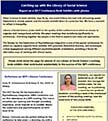
Catching up with LSS Book Exhibits (Oct 12, 2017)
When it comes to book exhibits, days fly by: one event follows the next with exhausting speed. Sep is already passed,
and the months dwindle down to a precious few. We have a moment to reflect in tranquility. Library of Social Science
prides itself on the quality of the conferences at which we choose to organize and manage book exhibits. We select meetings
that contribute significantly to scholarship—that bring together top people in the field to explore new ideas and approaches.
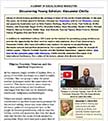
Discovering Young Scholars—Alexander Chirila (Oct 6, 2017)
In addition to established authors, LSS is also on the lookout for promising young scholars—to provide the opportunity for
their work to reach a wide audience. One of our discoveries is Alexander Chirila. Like many LSS authors and readers—he
aspires to use psychology to illuminate cultural and political phenomena. He’s a powerful, insightful writer. An excerpt
of Chirila’s paper, “Pilgrim-Tourists: Tourism and the Spiritual Experience,” appears below.
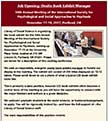
Job Opening: Conference on Psychosis (Sep 28, 2017)
Library of Social Science is organizing the book exhibit for the 16th Annual Meeting of the International Society for, Psychological
and Social Approaches to Psychosis, coming up Nov 17-19 at the University Place Hotel, located at 310 SW Lincoln
St, Portland, OR 97201. Please see below for a description of this exciting conference. We seek an responsible, energetic
onsite book exhibit manager to handle our display at the meeting.

Texas Psychological Association: Job Opening (Sep 19, 2017)
We are looking for an individual to manage our book exhibit for this meeting onsite. You will be rigorously trained by—and
have the full support of—the Library of Social Science staff. This is primarily a sales position, however LSS book exhibits
often becomes a central locus of the meeting so you will have the opportunity to connect with the major thinkers and
authors in a given discipline

Job Opening: Book Exhibit Manager (Sep 19, 2017)
We are looking for an individual to manage our book exhibit for this meeting onsite. You will be rigorously trained by—and
have the full support of—the Library of Social Science staff. This is primarily a sales position, however LSS book exhibits
often becomes a central locus of the meeting so you will have the opportunity to connect with the major thinkers and
authors in a given discipline
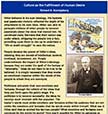
Culture as the fulfillment of human desire (Sep 14, 2017)
Hitler believed in his own ideology. His hysteria and passionate rhetoric reflected the depth of his attachment to his own
ideas. Hitler was able to persuade millions of other people to become passionate about the ideas that moved him. He
convinced many Germans that their nation was under attack, whipping the people into a fury, prevailing upon them to
rise up to undertake a "life or death struggle" to save the nation.
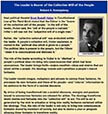
The leader is bearer of the collective will (Sep 13, 2017)
Nazi political theorist Ernst Rudolf Huber in Constitutional Law of the Third Reich stated that the Führer is the “bearer
of the collective will of the people.” In the will of the leader, Huber said, the “will of the people is realized.”
Hitler’s will was not the “subjective will of a single man.” Rather, the “collective national will” was embodied within
the leader.
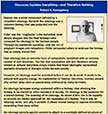
Discourse explains everything—therefore nothing (Sep 13, 2017)
Nazism was a social movement defined by a consistent ideology. Beneath this ideology was a coherent fantasy that was projected
into the ideology. Hitler was the “ringleader”—the individual most deeply plugged into the Nazi fantasy—who conveyed
the ideology to the German people. Through his passionate speaking—and the use of pregnant images and metaphors—Hitler
persuaded others to embrace the fantasy that so deeply moved him.

Killing bacteria (Sep 8, 2017)
A manual by Rudolf Ramm (Lifton, 2017) proposed that doctors become "physicians to the Volk" and "alert biological soldiers"
living under the great idea of the "National Socialist biological state structure." According to this manual, National
Socialism was in "accord with the biology of man." Rudolf Hess claimed that National Socialism was "nothing but applied
biology." What does it mean to say that National Socialism—politics—is applied biology?
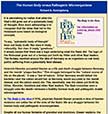
The human body vs. pathogenic microorganisms (Sep 8, 2017)
It is astonishing to realize that what the Nazi’s did grew out of a systematic body of thought. Even more astounding is to
recognize that the ideas that led to the Holocaust were based on biological concepts. To say, “systematic body of thought”
does not imply truth. Nor does it imply rationality. Nor does it imply “goodness.” It simply means that there was a
logic underlying what the Nazis did.
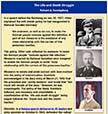
The life and death struggle (Sep 7, 2017)
In a speech before the Reichstag on Jan. 30, 1937, Hitler explained the anti-Jewish policy he had inaugurated in National
Socialist Germany: We endeavor, as well as we can, to make the German people immune against this infection. A part of
our measures is the avoidance of any close relationship with the carriers of this poisonous bacillus. This policy, Hitler
said, reflected his endeavor to make the German people "immune against this infection."

Germany has an immune system (Sep 6, 2017)
Hitler, we have seen, spoke about the German nation as if it was an organism—a real body politic. In Mein Kampf (1923), he
plaintively poses the question: Could anyone believe that Germany alone was not subject to exactly the same laws as
all other human organisms? What was the “law” to which Hitler referred? I hypothesize that he was pointing to the biological
mechanism of the immune system, which recognizes what is “self,” and rejects everything that is “not self.”
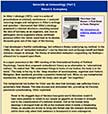
Genocide as Immunology (Part I) (Sep 6, 2017)
In Hitler’s Ideology (1975)—and a series of presentations at scholarly conferences—I analyzed recurring images and metaphors
in Hitler’s writings and speeches. I discovered that Hitler’s ideology possessed a coherent structure—revolving around
the idea of Germany as an organism, and Jews as pathogenic micro-organisms whose continued presence within the nation
could lead to its demise. Genocide grew out of the logic of this fantasy...
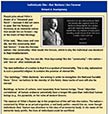
Individuals Die—But Nations Live Forever (Sep 6, 2017)
It is right to focus on Hitler as the core and essence of the Nazi movement. He was the individual who defined Nazi ideology,
and was the one most deeply plugged in to it. Yet what occurred in Germany happened only because millions of people
embraced Nazism. The defining event of this era, perhaps, was the mass-rallies at Nuremberg, where hundreds of thousands
of Germans came together to worship Hitler and to applaud his every word.
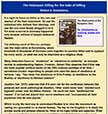
The Holocaust: Killing for the Sake of Killing (Sep 5, 2017)
It is right to focus on Hitler as the core and essence of the Nazi movement. He was the individual who defined Nazi ideology,
and was the one most deeply plugged in to it. Yet what occurred in Germany happened only because millions of people
embraced Nazism. The defining event of this era, perhaps, was the mass-rallies at Nuremberg, where hundreds of thousands
of Germans came together to worship Hitler and to applaud his every word…in what can only be described as a religious
ritual.
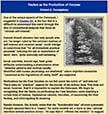
Nazism as the Production of Corpses (Sep 5, 2017)
One of the unique aspects of the Holocaust, I suggested in Chapter XV, is the fact that it is difficult to understand this
event through the lens of conventional analyses that focus on “rational self-interest.” Hannah Arendt observes that
only people who are “no longer ruled by the common motives of self-interest and common sense” could indulge in convictions
that “for all immediate practical purposes” (winning the war or exploitation of labor) were “quite obviously self-defeating.
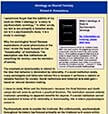
Ideology as Shared Fantasy (Sep 5, 2017)
I sometimes forget that the subtitle of my book on Hitler’s ideology is “a study in psychoanalytic sociology.” In other words,
my text is not primarily a historical study, nor is it a psychoanalytic study. It is a study in
sociology. Why the sociological focus? Because explanations of social phenomena at the time I wrote the book focused
on the “functionality” of institutions. The assumption was that institutions
do something for society—and for members of society.
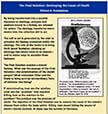
The Final Solution: destroying the cause of death (Sep 4, 2017)
By being transformed into a societal discourse or ideology, energies and passions bound to a fantasy are released for action.
The ideology transforms latent desires into the collective will to act. The will to act is generated by the wish to
actualize the fantasy contained within the ideology. The role of the leader is to bring forth latent fantasies—devising
an ideology that allows them to be shared—and to devise ways to actualize these fantasies.
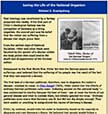
Saving the life of the national organism (Sep 4, 2017)
Nazi ideology was constituted by a fantasy projected into reality. If the first part of Hitler's ideological fantasy was
his conception of Germany as a living organism, the second part was his belief that the nation was suffering from a
disease that might prove fatal.
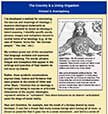
The country is a living organism (Sep 4, 2017)
I’ve developed a method for uncovering the sources and meanings of ideology. I examine ideological statements as manifest
content to reveal an ideology's latent meaning. I identify specific words, phrases, images and metaphors bound to central
terms of an ideology (e.g., in the case of Nazism, terms like "the German people," "the Jew," etc.).
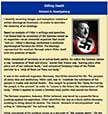
Killing death (Sep 1, 2017)
I identify recurring images and metaphors contained within ideological structures—in order to ascertain the meaning of an
ideology. Based on analysis of Hitler’s writings and speeches, I’ve found that he conceived of the German nation as
an organism—as an immortal organism that could “live on.” Hitler’s ideology performed a profound psychological function
for Hitler. His ideology represented the medium through which Hitler dealt with the problem of death.
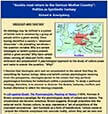
Return to the Mother Country (Aug 31, 2017)
An ideology may be defined is a system of beliefs held in common by a group of people within a given society. Once having
identified a society’s “dominant discourses”—its prevailing narratives—the question remains: Why are certain ideologies
or beliefs systems present within a given society? Why have certain ideas—among all ideas put forth—been embraced and
perpetuated? A psychological approach to the study of culture poses and seeks to answer the question, “Why?”
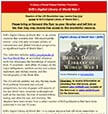
Free access to Brill’s Digital Library of World War I (Aug 30, 2017)
Readers of the LSS Newsletter may receive free trial access to Brill’s Digital Library of World War I. Please bring or forward
this flyer to your librarian and tell him or her that they may receive free access to this wonderful resource. Brill’s
Digital Library of World War I is an online resource that contains over 700 encyclopedia entries—plus 250 peer-reviewed
articles of transnational and global historical perspectives on significant topics of World War I.
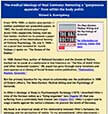
Removing a "gangrenous appendix" from the body politic (Aug 30, 2017)
From 1976-1998—a twelve-year period—I neither published nor presented papers. In 1987, the Israeli clinical psychologist
Avner Falk—apparently having read my two books—invited me to present a paper at a meeting of the International Society
of Political Psychology. On Jul 3, 1988—on a panel that included Dr. Vamik Volkan—I spoke on “The Dream of the Nation.”
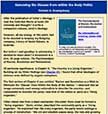
Removing the disease from within the body politic (Aug 28, 2017)
After the publication of Hitler’s Ideology, I read the Collected Works of Lenin (50 volumes) and thought I’d write a companion
volume, Lenin’s Ideology. However, all my energy, at this point, had to be devoted to keeping my fledgling company,
Library of Social Science, in business. But before I said goodbye to scholarship, I decided to share what I’d discovered
in a slim, 50-page volume,
The Psychoanalysis of Racism, Revolution and Nationalism.
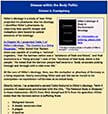
Disease within the body politic (Aug 28, 2017)
Hitler’s Ideology is a study of how Hitler projected his phantasies into his ideology. I identified Hitler’s phantasies by
observing how specific images and metaphors were bound to central elements of his ideology. In Chapter VI, I presented
Table 1 of Hitler’s Ideology, “The Country is a Living Organism.” Hitler stated that Nazism alone was capable of creating
a “national organism,” that the German nation was a “substance of flesh and blood,” and that economics is a “living
process”—one of the “functions of that body which is the people.”
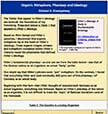
Organic metaphors, phantasy and ideology (Aug 25, 2017)
The Tables that appear in
Hitler’s Ideology are bedrock: the foundation of my theorizing. Presented below is Table 1 that appears in
Hitler’s Ideology. Based on
Mein Kampf and Hitler’s speeches, I discovered that organic metaphors lay at the heart of Hitler’s ideology. These
organic images, phrases and metaphors contained within Hitler’s rhetoric reveal the phantasies that defined Hitler’s
ideology.
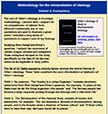
Methodology for the Interpretation of Ideology (Aug 25, 2017)
The core of
Hitler’s Ideology is its unique methodology. I present data—support for my propositions—in tabular form. Whereas
traditionally one or two quotations are used to illustrate a given point, I included a long series of quotations to
support each of my findings. Studying
Mein Kampf and Hitler’s speeches, I noticed the recurrence of certain images, phrases and metaphors. These metaphors
focused on the body, specifically on the idea of the German nation as an organism or body politic.
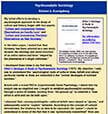
Psychoanalytic Sociology (Aug 25, 2017)
My initial efforts to develop a psychological approach to the study of culture and history began with two papers, “Culture
and Unconscious Fantasy: Observations on Courtly Love” and “Culture and Unconscious Phantasy: Observations on Nazi Germany.”
In the latter paper, I stated that Nazi Germany had been selected as a case study because the ideology and social structure
of an entire nation had been “shaped by the phantasies of a single individual.”
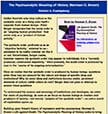
The psychoanalytic meaning of history (Norman O. Brown) (Aug 24, 2017)
Unlike theorists who view culture or the symbolic order as a thing unto itself—separate from human beings—Peter Berger recognizes
that the social order is an “ongoing human production” that exists only as a “product of human activity.” The symbolic
order confronts us as an “objective facticity,” external to us—persistent in its reality whether we like it or not.
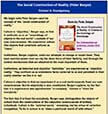
Forgetting our authorship of the human world (Aug 24, 2017)
It is important to keep in mind, Peter Berger says, that the “objectivity” of the social world, however massive it may appear
to us, is a “humanly produced, constructed objectivity.” Berger uses the term “objectivation” to characterize the process
by which the “externalized products of human activity attain the character of objectivity.” The institutional world
is objectivated human activity, and so is every single institution.

The Psychological Interpretation of Culture and History (Aug 24, 2017)
We begin with Peter Berger—and his concept of the “social construction of reality.” Culture is “objective,” Berger says,
in that it confronts us as an “assemblage of objects in the real world”—outside of our own consciousness. We experience
culture (the objects that constitute culture) as “there.” Institutions, Berger explains, resist our attempts to change
or evade them. They have coercive power over us—by the sheer force of their facticity, and through the control mechanisms
that are attached to the most important of them.
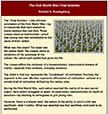
First World War: Final Solution (Aug 17, 2017)
The “Final Solution”—the ultimate conclusion of the First World War—lay in memorials that were erected to honor soldiers
that had died. These crosses stand as testimonials—proof that young men had contributed to the cause of their nation.
What was this cause? The cause was the nation itself. The crosses stand as validation of the greatness of the nation—for
which each soldier had given his life.
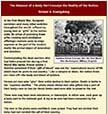
The absence of a body part conveys the reality of the nation (Aug 17, 2017)
In the First World War, European societies—and many other societies throughout the world—offered up young men as “gifts”
to the nation-state. By virtue of providing these gifts—making such prodigious offerings—nations came to reign supreme
as the god of the modern world: the primal object of veneration and devotion.
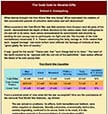
The gods exist to receive gifts (Aug 17, 2017)
What desires brought the First World War into being? What motivated the creation of this monumental episode of collective
destruction and self-destruction? What occurred in the First World War was that societies from Europe—and all parts
of the world—demonstrated the depth of their devotion to the nation-state: their willingness to die and kill in its
name. Each nation demonstrated its commitment and sincerity by sending its own young men to participate—to fight and
die.
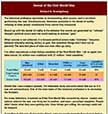
Denial of the First World War (Aug 16, 2017)
The historical profession specializes in documenting what occurs—and is excellent performing this task. Simultaneously, historians
specialize in the denial of reality: refusing to draw proper conclusions from events they document. Bound up with the
denial of reality is the delusion that events are generated by “rational” thought: political actors scan the world seeking
to achieve “gain.”
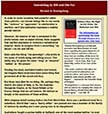
Something to Kill & Die For (Aug 15, 2017)
In order to make ourselves feel powerful rather than pathetic—we human beings like to use words like “violence” or “aggression”
in relationship to warfare—as if this institution expresses a healthy animal instinct. However, the essence of war is
contained in the photo below: men as abject victims. Kahn suggests that warfare expresses or conveys a metaphysical
impulse: desire to imagine there is something “up above”—to die and kill for.
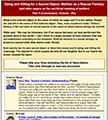
Dying and killing for a sacred object (warfare as a rescue fantasy) (Jul 19, 2017)
What is the beloved object in the name of which we wage war? It is the nation. People die and kill in the name of this beloved
object. Thus, mass-murderers make “history.” History is the narrative of sacred objects in the name of which human beings
die and kill. Hitler said, “We may be inhumane, but if we rescue Germany we have performed the greatest deed in the
world.” I can’t think of a single episode of mass violence that was not undertaken according to this template.
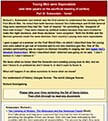
Young men were expendable (Jul 19, 2017)
Richard L. Rubenstein (see below) was the first scholar to understand the meaning of the First World War. He noted that both
German General Von Falkenhayn and British General Haig were convinced they had the “best of reasons” for permitting
the “slaughter of their own troops.” They were chosen by political leaders because they were trusted to make the right
decisions, and those decisions “were accepted.” Both the British and the German generals made the same decision: their
country’s young men were expendable.
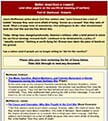
Better dead than a coward (Jul 19, 2017)
James McPherson writes about Civil War soldiers who “went forward into a hail of bullets” because they were more afraid of
being “known as a coward” than they were of death. What a strange form of masculinity—this willingness to die—that characterized
both the Civil War and the First World War.
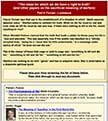
The ideas for which we die have a right to truth (Jul 18, 2017)
Franco Fornari says that war is the establishment of a situation in which “death assumes absolute value.” Warfare seeks to
validate the truth. What we die for must be real and true; what we kill for must be real and true. If there were nothing
to kill or die for, would anything be true? This is the clamor of those that wage or seek to wage war: “something to
kill and die for;” “something to kill and die for:” “something to kill and die for.”
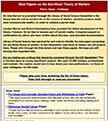
Best papers on the sacrificial theory of warfare (Jul 18, 2017)
Library of Social Science has searched far and wide to identify the best papers presenting the sacrificial theory of warfare.
In this Newsletter—and those to follow—we will present them. Please click through the links below and read these papers.
We hope you will develop this important idea. Are we missing any writings that should be promoted through the LSS Newsletter?
This is the best place to convey significant research.
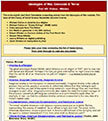
America is a religion (and other entries from the Ideology of War website) (Jul 13, 2017)
This is the eighth (and final) Newsletter presenting entries from the Ideologies of War website. This issue of the Library
of Social Science Newsletter includes links to: Michael Vlahos on America is a religion; Michael Vlahos on "Drone Killings"
(WABC radio); Video excerpts from The Matrix; Eric Weitz on genocide in the 20th century; Robert Whalen on German victims
of the First World War; Human Wave Attacks; Jeanne Willette on digital publishing; Jonah Winters on martyrdom in jihad
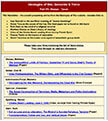
Ivan Strenski on "human bombings" (and other entries from the Ideology of War website) (Jul 13, 2017)
This Newsletter—the seventh presenting entries from the Ideologies of War website—includes links to: Ivan Strenski on the
sacrificial meaning of "human bombings"; Hakan Tunç on the causes of the Iraq War (best paper we've found on this topic);
Ruth Stein on the mind of a religious terrorist; Matthew Sharpe on Zizek's theory of ideology; Video of the Omaha Beach
Landing (from Saving Private Ryan); Frances Tustin on the trauma of separation; Stuart Twemlow on the Leader as an agent
of masochistic group death.
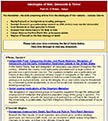
Immigrants as invading pathogens (and other entries from the Ideology of War website) (Jul 13, 2017)
This Newsletter—the sixth presenting entries from the Ideologies of War website— includes links to: Maciej Paprocki on immigrants
as invading pathogens; Rudolph Rummel's groundbreaking research on 20th century mass-murder (democide); Scott Romaniuk
on Nazi genocide in Poland; Excerpts from Elaine Scarry's The Body in Pain; Takuan Seiyo on the First World War as European
suicide; Meghan O'Donnell on the Nazi ideology of death.
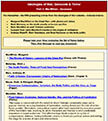
The death penalty as human sacrifice (and other entries from the Ideology of War website) (Jul 13, 2017)
This Newsletter—the fifth presenting entries from the Ideologies of War website— includes links to: Margaret MacMillan on
the Great War—with photos and videos; Mark Mahoney on the death penalty as human sacrifice; Myra Mendible on post-Vietnam
syndrome; Excerpts from Lewis Mumford's books on the origins of civilization; Andreas Musolff, Mark Neocleous, and Boaz
Neumann on the body politic.
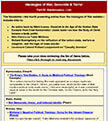
How the Body of Christ became a body politic (and other entries from the Ideology of War website) (Jul 13, 2017)
This Newsletter—the fourth presenting entries from the Ideologies of War website— includes links to: An entire book by Mark
Levene, Genocide in the Age of the Nation-State; Excerpts from Ernst Kantorowicz' classic book—on how the Body of Christ
became a body politic; Akio Kimura on Yukio Mishima; Richard Koenigsberg on the reification of the nation-state, warfare
as slaughter, and the logic of mass-murder; Lieutenant Colonel Richard Lacquement on "Casualty Aversion"
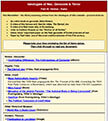
Genocide, Nuremberg Rallies, Saddam Hussein (and other entries from the Ideologies of War website) (Jul 12, 2017)
This Newsletter—the third presenting entries from the Ideologies of War website—presents links to: An entire book on genocide
(Alex Hinton); A video of the famous anti-Semitic video, The Eternal Jew; A video of a Nazi mass-rally at Nuremberg;
Links to Saddam Hussein on the "Mother of all Battles"; Adam Jones' important paper on the Nazi genocide of Soviet prisoners
of war; Paper by Paul Kahn, one of the most creative scholars of the 21st century.
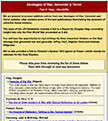
Part II: Ideologies of War, Genocide and Terror (Jul 12, 2017)
We are pleased to present addition entries from our Ideologies of War, Genocide and Terror website—that contains some of
the best publications illuminating the dynamics of collective forms violence. This issue of the LSS Newsletter includes
a link to a Report by Douglas Haig—providing insight into why the First World War proceeded as it did.
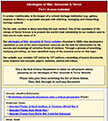
Ideologies of War, Genocide and Terror (Part I) (Jul 11, 2017)
A curator, traditionally, is the keeper of a cultural heritage institution (e.g., gallery, museum or library)—a specialist
charged with selecting, managing and interpreting heritage material. On the web, curation is about selecting the best
content. One of the mandates of the Library of Social Science is to present the world’s best scholarship to our readers—and
to help you to make sense of it.
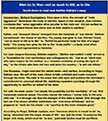
Part 10: What should we call fallen warriors? (David Weddle) (Jul 7, 2017)
The central question posed by Denton-Borhaug, Weddle says, is: “What meaning shall we assign to the deaths of soldiers in
combat?” Deaths in battle most often are designated as sacrifice, and therein a “powerful motivation for warfare lies.”
It is Denton-Borhaug’s conviction, Weddle says, that American fervor for war is “sustained by the pervasive use of sacrifice
to name the loss of life in battle.”

Part 9: War as ritual and symbolic theater (M. Vlahos) (Jul 7, 2017)
For thousands of years, human sacrifice has represented a sacred ritual in which our most precious loss—transforms into our
most precious gift. According to Vlahos, terrorism is deeply related to war. Each pursues a dual path of sacrificial
death—one in which our own are martyred, and another in which The Other is ritually slaughtered.

Part 8: Transcendence through Blood Sacrifice (M. Vlahos) (Jul 7, 2017)
Vlahos tells us that 20th century wars—1914-1951—killed perhaps 150 million human beings. Although we often ascribe this
calamity to “madness, evil, or the inevitable efficiencies of an industrial economy,” Vlahos argues that this killing
was “embedded in the “desire of peoples to fulfill—through wars—the vision that drove them.”

Part 7: Human Bombers as Sacrificial Gifts (Ivan Strenski) (Jul 6, 2017)
Muslims, Strenski says, see sacrifice as a very particular kind of gift—in that the sacrificial victim is “destroyed in the
process of giving it.” While some emphasize the “utilitarian” concept of suicide bombings, Strenski (focusing on the
Palestinian case) observes that even when attacks fail, the bombers will detonate the charge anyway.

Part 6: Lambs to slaughter: warfare as sacrificial ritual (Strenski) (Jul 6, 2017)
Lockwood states that it is not the sacrifice of the enemy that creates a unified identity but the “sacrifice of the group’s
own.” She focuses on the Australian Anzac tradition. Annually, on Apr 24, Australians gather to commemorate the fallen—in
a day filled with ritual, liturgy and solemnity—seeming to fill a religious need within a secular society.

Part 5: Australia is born: blood sacrifice at Gallipoli (Renee Lockwood) (Jul 6, 2017)
Lockwood states that it is not the sacrifice of the enemy that creates a unified identity but the “sacrifice of the group’s
own.” She focuses on the Australian Anzac tradition. Annually, on Apr 24, Australians gather to commemorate the fallen—in
a day filled with ritual, liturgy and solemnity—seeming to fill a religious need within a secular society.

Part 4: U.S. War Culture (Kelly Denton-Borhaug) (Jul 6, 2017)
Focusing on the American case, Denton-Borhaug writes about the “sacrificial metaphor at the heart of citizenship.” A sacrificial
war culture, she says “profoundly shapes our understanding of citizenship and the nation.” The sacrificial metaphor—intrinsically
tied to war—is even more powerful because citizens are “unconscious of its active impact on our own lives.”

Part 3: First World War as ritual purification (Roger Griffin) (Jul 6, 2017)
Roger Griffin observes that the bellicose mood accompanying the onset of the First World War in 1914 was based on the assumption
or myth that “destroying a contemptible society would open the way to a better one.” Within this mindset, the ruthless
slaughter was perceived as a ritual act of purification; a “cleansing fire.”

Part 2: Men go to war to die (Jean Elshtain) (Jul 6, 2017)
Once upon a time, the concept of “male aggression” dominated the study of warfare. Based on her research, Jean Elshtain concludes
that “some aggressive drive peculiar to the male sex” did not surface as the “most potent theme that drove men to their
deaths in wartime.”
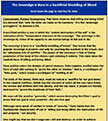
Part 1: The sovereign born in the shedding of blood (Paul W. Kahn) (Jul 6, 2017)
Paul Kahn observes that killing and being killed is a demand that “only the state can make on its members.” It is the “sovereign
prerogative” to demand a life. A sacrificial politics is one in which the “violent destruction of the self” is the realization
of the “transcendent character of the sovereign.” The sovereign is the sovereign by virtue of his capacity to ask human
beings to kill and to die.
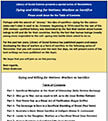
Dying and Killing for Nations: Warfare as Sacrifice (Jul 5, 2017)
Perhaps with the advent of “drones,” the idea of sacrifice—dying for the nation-state—isn’t what it used to be. However,
beginning in 1914—and for the rest of the 20th century—political history was dominated by the fact that leaders asked
human beings to kill and die for their countries. And by the fact that human beings (mostly young men) responded to
the call—going into battle when asked to do so.
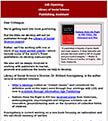
Job Opening: Publishing Assistant (Jun 28, 2017)
Koenigsberg is current working on a new book focusing on nationalism and the sacrificial meaning of warfare. We also are
in the process of bringing into print an edited volume, Paranoid Fantasy and Enemy Creation. We week an intelligent,
dynamic, well-organized individual to work with us on the development of these projects.
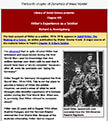
Hitler's Experience as a Soldier (Dynamics of Mass Murder: Chapter XIII) (Jun 21, 2017)
The best account of Hitler as a soldier, 1914-1918, appears in Adolf Hitler: The Making of a Fuhrer, an online publication
by Walter Smoter Frank. A major source of the material below is Frank’s Chapter 9: A Born Soldier. Hitler had experienced
the nightmare of the First World War. Yet, he did not become an anti-war activist. Indeed, he refused to complain about
what he had gone through—or to blame Germany. What’s more, in spite of everything, through the rest of his life he embraced
war.
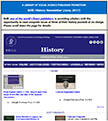
Brill: read history journals at no charge (Jun 20, 2017)
A LIBRARY OF SOCIAL SCIENCE PUBLISHER PROMOTION. Brill: History Newsletter (Jun, 2017). Brill, one of the world’s finest
publishers, is providing scholars with the opportunity to read complete issues of three of their history journals at
no charge. Please scroll down the page for details.
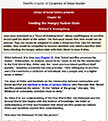
Feeding the Hungry Nation-State (Dynamics of Mass Murder: Chapter XII) (Jun 19, 2017)
Jews were conceived as a “force of disintegration” whose unwillingness to sacrifice would spell the death of the nation.
The Holocaust meant that Jews would not be exempt. They too would be obligated to make a blood sacrifice. Like the German
soldier, they would be compelled to become obedient unto death—sacrifice their lives—feeding the hungry nation-state
with their blood to keep it alive.
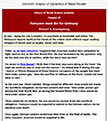
Obedience unto death (Dynamics of Mass Murder: Chapter XI) (Jun 19, 2017)
The Holocaust conveys suffering and death at the hands of a nation-state— stripped of words like honor and glory. The Holocaust
enacts the horrific fate of a body that has been put at the disposal of a nation: given over to—taken over by—the state.
Hitler, as we have observed, imagined that Jews had evaded their obligation to fight (and to die) in the First World
War. He was tormented by the question: why do the best men die in warfare, while the worst men survive?
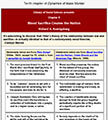
Blood sacrifice creates the nation (Dynamics of Mass Murder: Chapter X) (Jun 19, 2017)
It’s astonishing to discover that Hitler’s theory of the relationship between war and sacrifice—is virtually identical to
that of a contemporary social theorist, Carolyn Marvin. Statements below are from Mein Kampf (Hitler, 1924), except
for #3, which is from a pamphlet by Joseph Goebbels. Statements below are from Blood Sacrifice and the Nation: Totem
Rituals and the American Flag (Marvin, 1999).
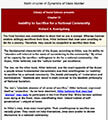
Unwillingness to Sacrifice (Dynamics of Mass Murder: Chapter IX) (Jun 19, 2017)
The Final Solution was undertaken to show that no one is exempt. Whereas German soldiers willingly sacrificed their lives,
Hitler believed that Jews were unwilling to die for a country. Therefore. they would be compelled to sacrifice their
lives. The fundamental characteristic of the Aryan, according to Hitler, was his ability to “abandon self-interest in
the name of surrendering to the community.”
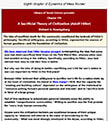
Sacrificial Theory of Civilization (Dynamics of Mass Murder: Chapter VIII) (Jun 17, 2017)
The idea of sacrificial death for the community constituted the bedrock of Hitler’s philosophy. Sacrificial willingness,
according to Hitler, represented the essence of human goodness—and the foundation of civilization. We have observed
that Hitler became enraged contemplating the idea that some men had died—sacrificed their lives—in the First World War;
whereas other men had avoided serving in the military.
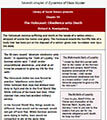
Obedience unto death (Dynamics of Mass Murder: Chapter VII) (Jun 16, 2017)
The Holocaust conveys suffering and death at the hands of a nation-state— stripped of words like honor and glory. The Holocaust
enacts the horrific fate of a body that has been put at the disposal of a nation: given over to—taken over by—the state.
The SS-man vowed “absolute obedience unto death.” In repeating his “Oath of Loyalty,” the German solder said: “I shall
render unconditional obedience…and shall at all times be prepared to give my life for this oath.”
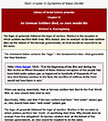
The logic of genocide follows the logic of war (Dynamics of Mass Murder: Chapter VI) (Jun 16, 2017)
The logic of genocide followed the logic of warfare. Warfare is the occasion in which soldiers sacrifice their lives. Why
should Jews be exempt? As German soldiers died (at the behest of the German government), so Jews would be required to
do the same.
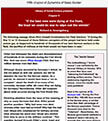
If the best men die, so should the worst men (Dynamics of Mass Murder: Chapter V) (Jun 16, 2017)
The following passage (from Mein Kampf) foreshadows the Final Solution: “If during the War 12 or 15 thousand of these Hebrew
corrupters of the people had been held under poison gas, as happened to hundreds of thousands of our best German workers
in the field, the sacrifice of millions at the front would not have been in vain.”
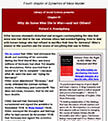
Why do some men die in war and not others? (Dynamics of Mass Murder: Chapter IV) (Jun 16, 2017)
Hitler become obsessed—disturbed and enraged—contemplating the idea that some men had died in the war, whereas others had
avoided fighting. How to deal with human beings who had refused to sacrifice their lives for Germany? Hitler’s answer
to this question was the source of everything that was to follow.
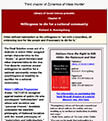
Refusal to abandon warfare (Dynamics of Mass Murder: Chapter III) (Jun 16, 2017)
Hitler defined nationalism as the willingness to “act with a boundless, all embracing love for the people and if necessary
to die for it.” The Final Solution arose out of a dialectic in which Hitler assigned certain characteristics to the
“Aryan,” or good German—and other characteristics to the Jew. This dialectic revolved around willingness to sacrifice
for a national community versus the unwillingness or inability to sacrifice for a national community.
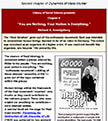
"You are nothing, your nation is everything" (Dynamics of Mass Murder: Chapter II) (Jun 16, 2017)
The “Final Solution” grew out of the euthanasia movement. Each was intended to exterminate human beings deemed to be of no
value to Germany. The nation was conceived as an organism of a higher order. If one could not benefit this organism,
one became “life unworthy life.
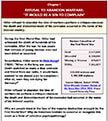
Refusal to abandon warfare (Dynamics of Mass Murder: Chapter I) (Jun 15, 2017)
Hitler refused to abandon the idea of warfare—perform a critique—because the death and dismemberment of his comrades occurred
in the name of his beloved country. He insisted—in spite of two million dead in the First World War—that it would be
a “sin to complain.” During the First World War, Hitler had witnessed the death of hundreds of his comrades. After the
war, he was aware that millions of young German men had been killed or wounded.
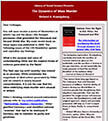
The Dynamics of Mass Murder (Jun 15, 2017)
You will soon receive a series of Newsletters in which I lay out the ideas—the thought processes—that generated the Holocaust
and Second World War. My most recent book on these topics was published in 2009. The following issues of the LSS Newsletter
update and crystallize my findings.
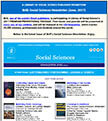
Brill: New titles in Social Science (Jun 13, 2017)
Brill, one of the world’s finest publishers, is participating in Library of Social Science’s 2017 PREMIUM PROMOTIONAL PACKAGE.
Their books and journals will be presented at every one of our exhibits, and will be featured in the LSS Newsletter,
which reaches 35,000 scholars, professionals and students around the world. Below is the latest issue of Brill’s Social
Sciences Newsletter. Enjoy.
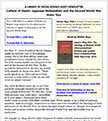
Culture of Death (Japanese Nationalism & the 2nd World War) (Jun 9, 2017)
On May 27, 2016 President Barak Obama made an historic visit to Hiroshima, Japan. He is the first sitting American president
to have visited the site where the first atomic bomb was dropped at the end of the Second World War. In the speech he
delivered at the site, he stated with regards to those who died, “Their souls speak to us. They ask us to look inward,
to take stock of who we are and what we might become.”
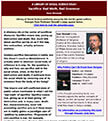
Ivan Strenski on Sacrifice (Jun 9, 2017)
A dilemma sits at the center of sacrificial discourse. Sacrifice means loss, giving up, destruction and death. But, much
talk about sacrifice carries on as if this loss, this subtraction, actually achieves addition. Soldiers sacrifice themselves
in battle, but this doesn’t count as diminishment.
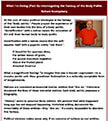
Interrogating the fantasy of the body politic (Jun 8, 2017)
At the core of many political ideologies is the fantasy of the “body politic.” People project the experience of their own
bodies into the idea of a body politic. “Identification” with a nation means the relocation of the self: from human
body to body politic. Identification with a nation means that the self-equates itself with a gigantic entity “out there.”
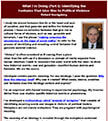
Fantasies generating political violence (Jun 8, 2017)
I study the shared fantasies that lie at the heart and soul of societies, and that generate and define the historical process.
I focus on collective fantasies that give rise to cultural forms of violence, such as war, genocide and terrorism. I
use the phrase “making conscious the unconscious on the stage of social reality” to refer to the process of identifying
and revealing central fantasies that generate societal violence.
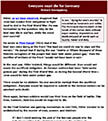
Everyone must die for Germany (Jun 6, 2017)
Hitler, as we have observed, imagined that Jews had evaded their obligation to fight (and to die) in the First World War.
He was tormented by the question: why do the best men die in warfare, while the worst men survive? In war, “dying for
one’s country” is conceived as honorable and noble. The Holocaust depicts death at the hands of the nation-state without
sugar-coating: degradation and death stripped of words such as loyalty, honor and duty.
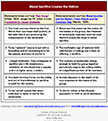
Blood Sacrifice Creates the Nation (Jun 6, 2017)
Statements below are from
Mein Kampf (Hitler, 1924), except for #3, which is from a pamphlet by Joseph Goebbels; and
Blood Sacrifice and the Nation: Totem Rituals and the American Flag (Marvin, 1999).
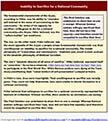
Unwillingness to Sacrifice (Jun 5, 2017)
The fundamental characteristic of the Aryan, according to Hitler, was his ability to “abandon self-interest in the name of
surrendering to the community.” By virtue of his capacity for sacrifice—willingness to die for a national community—the
Aryan, Hitler believed, was the “culture builder” par excellence.
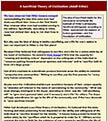
Sacrificial Theory of Civilization (Jun 5, 2017) We have observed that Hitler became enraged contemplating the
idea that some men had died—sacrificed their lives—in the First World War; whereas other men had avoided serving in
the military. Specifically, according to Hitler, Jews had shirked their duty to risk their lives in battle. But why
was the idea of dying in battle—sacrificing one’s life for one’s nation in war—so important to Hitler in the first place?
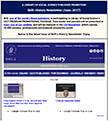
Brill: New titles in History (Jun 1, 2017) Brill, one of the world’s finest publishers, is participating in Library
of Social Science’s 2017 PREMIUM PROMOTIONAL PACKAGE. Their books and journals will be presented at every one of our
exhibits, and will be featured in the LSS Newsletter, which reaches 35,000 scholars, professionals and students around
the world. Below is the latest issue of Brill’s History Newsletter. Enjoy.
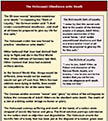
Obedience unto death (May 31, 2017) The SS-man vowed “absolute obedience unto death.” In repeating his “Oath of
Loyalty,” the German solder said: “I shall render unconditional obedience…and shall at all times be prepared to give
my life for this oath.” The Holocaust victim too was compelled to practice “obedience unto death.” Hitler believed that
Jews had shirked their duty to fight and die in the First World War. While millions of Germans had died, Hitler claimed
that Jews had avoided military service.
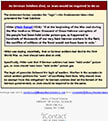
The logic of genocide follows the logic of war (May 31, 2017) The statement below contains the “logic”—the fundamental
idea—that generated the Final Solution: Hitler (Mein Kampf,1924): “If at the beginning of the War and during the War
twelve or fifteen thousand of these Hebrew corrupters of the people had been held under poison gas, as happened to hundreds
of thousands of our very best German workers in the field, the sacrifice of millions at the front would not have been
in vain.”
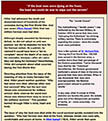
If the best men die, so should the worst men (May 30, 2017) Hitler had witnessed the death and dismemberment of
hundreds of his comrades during the First World War. And was aware (Mein Kampf,1924) that two million German men had
died. Although deeply wounded by Germany’s defeat, he did not adopt an anti-war posture; nor did he abandon his love
for the German nation. As a patriot, he claimed it would have been a “sin to complain” about the death of so many of
his comrades, because—after all—were they not dying for Germany?

Why do some men die in war and not others? (May 29, 2017) We’ve noted that Hitler had witnessed the death and maiming
of his comrades during the First World War; and knew millions of Germans had died. Yet despite the devastation, Hitler
asserted that it would be a “sin to complain”—because after all, were the men not “dying for Germany?” Hitler never
abandoned “Germany,” and rarely criticized the German military leaders, Hindenburg and Ludendorff. This does not mean,
however, that he did not have doubts.
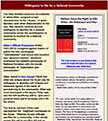
Willingness to die for a national community (May 26, 2017) The Final Solution arose out of a dialectic in which
Hitler assigned certain characteristics to the “Aryan,” or good German—and other characteristics to the Jew. This dialectic
revolved around willingness to sacrifice for a national community versus the unwillingness or inability to sacrifice
for a national community. Hitler’s Official Programme (Feder, 1927/2013) inveighed against leaders of public life who
worshipped “individualism” and whose sole incentive was “personal interest.” Goebbels contrasted the idealistic philosophy
of National Socialism with the Jewish philosophy of “materialism and individualism.”
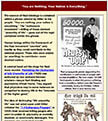
"You are nothing, your nation is everything" (May 25, 2017) The essence of Nazi ideology is contained within a phrase
uttered by Hitler to his people: “You are nothing, your nation is everything.” The “euthanasia movement”—killing of
those deemed “unworthy of life”—grew out of the logic contained within this phrase. Human beings within the framework
of the Nazi movement “counted” only insofar as they could contribute to the national project. Those who were unable
(or unwilling) to contribute—were deemed useless.
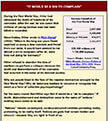
"It would be a sin to complain" (May 25, 2017) During the First World War, Hitler had witnessed the death of hundreds
of his comrades. After the war, he was aware that millions of young German men had been killed or wounded. Nevertheless,
Hitler wrote in Mein Kampf (1924): “When in the long war years Death snatched so many a dear comrade and friend from
our ranks, it would have seemed to me almost a sin to complain—after all, were they not dying for Germany?”
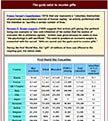
Gods exist to receive gifts (May 22, 2017) Franco Fornari’s hypothesizes (1974) that war represents a “voluntary
destruction of previously accumulated reserves of human capital,” an activity performed with the intention to “sacrifice
a certain number of lives.” Norman O. Brown states (1959) that archaic gift-giving (the potlatch being an example) is
“one vast refutation of the notion that the motive of economic life is utilitarian egoism.”
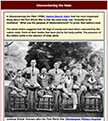
Dismembering the Male (May 22, 2017) In Dismembering the Male (1996), Joanna Bourke states that the most important
thing about the First World War is that the male body was “intended to be mutilated.” What was the purpose of dismemberment?
To prove that nations exist. The photo below suggests that the legs of young men have been consumed by the nation-state.
Parts of their bodies had been fed to the body politic. The presence of the nation exists in the absence of body parts.
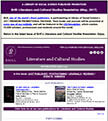
Brill: New titles in Literature and Cultural Studies (May 18, 2017) Brill, one of the world’s finest publishers,
is participating in Library of Social Science’s 2017 PREMIUM PROMOTIONAL PACKAGE. Their books and journals will be presented
at every one of our exhibits, and will be featured in the LSS Newsletter, which reaches 35,000 scholars, professionals
and students around the world. Below is the latest issue of Brill’s Literature and Cultural Studies Newsletter. Enjoy.
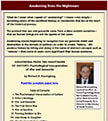
Awakening from the Nightmare of History (May 18, 2017) What do I mean when I speak of "awakening?" I mean—very simply—becoming
aware of the sacrificial fantasy or mechanism that lies at the heart of the historical process. We pretend that war
and genocide come from a place outside ourselves—that we human beings are not the agents or the cause. Awakening means
beginning to recognize how we generate death and destruction in the domain of politics—in order to create "history."
We produce history by killing and dying in the name of abstract concepts such as "nations"—that come to seem more significant
than human existence.
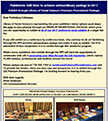
Exhibiting through our Premium Promotional Package (May 18, 2017) Library of Social Science is representing the
great publishers below (please scroll down the page to view photos) through our PREMIUM PROMOTIONAL PACKAGE, which gives
you the opportunity to exhibit at all of our 2017 conference book exhibits at a single flat fee. If you still exhibit
on a conference by conference basis, why continue to do so? Exhibiting through the PPP provides extraordinary savings
and makes it easy to exhibit. You’ll be astonished at how inexpensive it is to exhibit through this wonderful program.
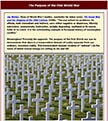
The Purpose of the First World War (May 17, 2017) Jay Winter, Dean of World War I studies, concludes his video series,
The Great War and the Shaping of the 20th Century (1996): “The war solved no problems. Its effects, both immediate and
indirect, were either negative or disastrous. Morally subversive, economically destructive, socially degrading, confused
in its course, futile in its result, it is the outstanding example in European history of meaningless conflict.”
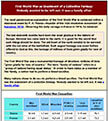
The First World War: a family affair (May 16, 2017) The First World War was a monumental homage of devotion: millions
of lives “given gladly for love of country.” The term “family of nations” refers to a “group of nations having equal
status.” In order to have status as a member of the family, a nation had to perform a blood sacrifice.
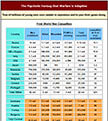
The psychotic fantasy that warfare is "adaptive" (May 16, 2017) Tens of millions of young men were unable to reproduce
and to pass their genes along.
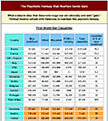
The psychotic fantasy that warfare seeks "gain" (May 16, 2017) What a bizarre idea: that those who wage war act
rationally and seek “gain.” Political leaders collude with historians to maintain this psychotic fantasy.
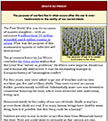
Death as Proof (May 15, 2017) The First World War was the occasion of massive slaughter—with an estimated 9 million
dead, 21 million wounded, and 8 million missing in action. What was the purpose of this monumental episode of collective
self-destruction? The prominent historian Jay Winter concludes his video series stating that the Great War “solved no
problems.” Its effects were negative, disastrous and economically destructive. It was the outstanding example in European
history of “meaningless conflict.”
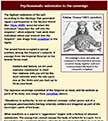
Psychosomatic Submission (May 10, 2017) The highest realization of the self, according to the ideology that generated
Japan’s participation in the Second World War (Skya, 2009), occurred when the individual “absorbed the self into the
emperor;” when subjects “cast aside their individual selves and entered into the Emperor” (see image from Leviathan
to the right).
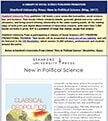
Stanford University Press: New in Political Science (May 10, 2017) Stanford University Press is participating in
Library of Social Science’s 2017 PREMIUM PROMOTIONAL PACKAGE. Their books will be presented at every one of our exhibits,
and will be featured in the LSS Newsletter, which reaches 35,000 scholars, professionals and students around the world.
Below is Stanford’s University Press's latest "New in Political Science" Newsletter. Enjoy.
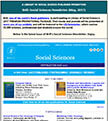
Brill: New titles in Social Science (May 10, 2017) Brill, one of the world’s finest publishers, is participating
in Library of Social Science’s 2017 PREMIUM PROMOTIONAL PACKAGE. Their books and journals will be presented at every
one of our exhibits, and will be featured in the LSS Newsletter, which reaches 35,000 scholars, professionals and students
around the world. Below is the latest issue of Brill’s Social Sciences Newsletter. Enjoy.
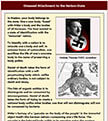
Diseased attachment to the nation-state (May 09, 2017) In Nazism, your body belongs to the state. One’s own
body “fused” with Hitler’s body and the bodies of all Germans. The Nazi existed in a state of identification
with the “immortal” nation. To identify with a nation is to relocate one’s body and self. In extreme
forms of nationalism, one sacrifices the life of one’s concrete body in the name of preserving a body politic.
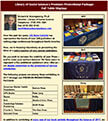
Premium Promotional Package 2017 (May 09, 2017) Over the past ten years, LSS Book Exhibits has represented the books
of over 240 publishers at cutting edge conferences throughout North America. Now, we’re focusing intensively on promoting
the titles of a select number of very special publishers. Do you wish to increase the visibility of your Press—and to
make your authors famous? We have space to represent a few additional publishers who—like us—are deeply committed to
the promotion of serious scholarship.
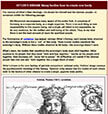
Hitler's dream (May 08, 2017) Hitler explains to his people that they must “weld and fuse together.” Insofar as
the people weld together, then Germany will “never fall to pieces.” All difficulties will vanish if the German people
fuse into one and “hold together like a single block of steel.” Hitler’s dream is the core fantasy of patriots everywhere:
national unity. Hobbes’ image conveys the psychosomatic meaning of this fantasy. National unity means that the bodies
of each citizen weld to the bodies of other citizens to create a single, gigantic body politic.
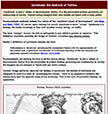
Symbiosis: the bedrock of politics (May 05, 2017) Psychoanalysts endlessly debate the nature of “symbiosis”—the
“symbiotic phase of development (see Blass and Blatt, 1996). Of course, upon leaving the womb, symbiosis is never “actual.”
Symbiosis is a fantasy: the desire to merge or fuse with another human being—or entity. Psychoanalysts are looking for
love in all the wrong places. “Symbiosis” is not a “phase of development. Rather it is the primordial or primal fantasy
governing our relationship to society. We imagine we are merged or fused with our entire culture.
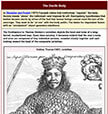
The Docile Body (May 04, 2017) In
Discipline and Punish (1975) Foucault claims that institutions “regulate” the body. Society stands “above” the
individual—and imposes its will. Koenigsberg hypothesizes that bodies become docile by virtue of the fact that human
beings cannot resist the lure of the sovereign. They want to be “at one” with the body politic. The desire for dependent
fusion with an “omnipotent” object generates obedience.
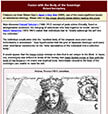
Fusion with the body of the sovereign (May 03, 2017) Skya discusses Hozumi Yatsuka’s concept of
godo seizon (literally, fused or amalgamated existence): the merging of individuals who fuse together to create
“society.” Kakehi Katsuhiko (1872-1961) stated that individuals had to “totally submerge the self into the collective.”
The individual would enter into the “mystical body of the emperor once one’s own individuality is abandoned.” Skya hypothesizes
that the goal of Japanese ideology—and many other totalitarian movements—is the “total assimilation of the individual
into a collective body.”
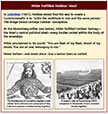
Hitler Fulfilled Hobbes’ Ideal (May 01, 2017) In Leviathan (1651), Hobbes stated that the way to create a Commonwealth
is to “unite the multitude in one and the same person.” The image below conveys Hobbes’ conception. At the Nuremberg
rallies (see below), Hitler fulfilled Hobbes’ fantasy—the West’s central political ideal—many bodies united within the
body of the sovereign. Hitler proclaimed to his youth: “You are flesh of my flesh, blood of my blood. You are all one,
belonging to me.” Never before—and never since—has a nation been so united.
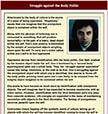
Struggle against the Body Politic (May 01, 2017) Attachment to the body of culture is the source of a sense of being
oppressed. “Hegemony” means that one imagines that the omnipotent object is contained within the self. Along with the
pleasure of believing one is connected to something that will produce immortality—is the pain of a heavy, dead object
within the self. One’s own potency is diminished by the weight of omnipotent objects weighing down upon the self. To
carry one’s entire nation within one’s self is to feel oppressed.
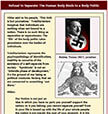
The human body binds to a body politic (Apr 29, 2017) Hitler said to his people, “This Volk is but yourselves.”
Totalitarianism imagines that individuals are nothing when not bound to a nation. There is no such thing as separation
or separateness. The “life” of the body politic takes precedence over the bodies of individuals. Totalitarianism represents
the psychopathology of identification: inability to conceive of the existence of a self-separate from society.
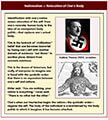
Nationalism = relocation of one's body (Apr 28, 2017) Identification with one’s nation means relocation of the self:
from one’s concrete, human body to the idea of an omnipotent body politic—that replaces one’s actual body. This is the
bedrock of “civilization:” belief that one becomes immortal by fusing one’s self with another domain of existence “out
there:” in another place, distant from concrete existence.
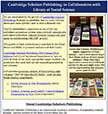
Cambridge Scholars Publishing/Library of Social Science (Apr 27, 2017) We are astonished by the growth of Cambridge
Scholars Publishing. Perhaps no publisher that we work with has developed more quickly—and in such a dynamic way. They’ve
established a reputation as one of the top publishers presenting cutting-edge scholarly monographs and edited collections.
Library of Social Science will once again be collaborating with CSP in 2017.
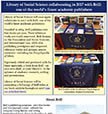
Library of Social Science/Brill (Apr 26, 2017) Library of Social Science will once again collaborate in 2017 with
Brill, one of the world’s finest academic publishers. Founded in 1683, Brill publishes over 800 books per year. Their
reference works are world renowned. Brill focuses on the Humanities and Social Sciences, and International Law, while
also publishing prestigious and respected reference works and primary source materials—including the Encyclopedia of
Islam. Library of Social Science will be presenting a full range of Brill titles at our book exhibits throughout 2017.
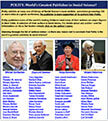
Polity: World's Great Publisher in Social Science? (Apr 25, 2017) Polity exhibits at every one of Library of Social
Science’s book exhibits, sometimes promoting 100 or more titles at a given conference. No publisher is more supportive
of its authors than Polity. Polity publishers some of the world’s leading thinkers—and many of their authors are major
figures in their fields. A selection of their authors is listed below. For details about any author—and for information
on his or her books—simply click on the author’s name. Glancing through the list of authors below—is there any reason
not to conclude that Polity is the world’s greatest publisher in social science?

Polity: World's Great Publisher in Social Science? (Apr 25, 2017) Polity exhibits at every one of Library of Social
Science’s book exhibits, sometimes promoting 100 or more titles at a given conference. No publisher is more supportive
of its authors than Polity. Polity publishers some of the world’s leading thinkers—and many of their authors are major
figures in their fields. A selection of their authors is listed below. For details about any author—and for information
on his or her books—simply click on the author’s name. Glancing through the list of authors below—is there any reason
not to conclude that Polity is the world’s greatest publisher in social science?

Like Sheep to the Slaughter—Part II (Apr 25, 2017) LIKE SHEEP TO THE SLAUGHTER—PART 2: German soldiers (WW-I): in
cattle cars on their way to the Western Front (total casualties 7,311,977). Jews (WW-II): in cattle cars on their way
to the death camps.
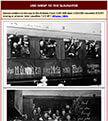
Like Sheep to the Slaughter (Apr 25, 2017) LIKE SHEEP TO THE SLAUGHTER: German soldiers on the way to the Western
Front: 2,037,000 dead; 4,300,000 wounded; 974,977 missing or prisoner; total casualties 7,311,977 (Whalen, 1984).
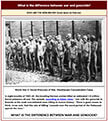
What is the difference between war and genocide? (Apr 24, 2017) In eight months of 1941-42, the invading German
armies killed an estimated 2.8 million Soviet prisoners-of-war. The episode, according to Adam Jones, “vies with the
genocide in Rwanda as the most concentrated mass-killing in human history.” There is good reason to think, Jones said,
that this rate of killing “exceeds even the worst period of the Holocaust against the Jews.”
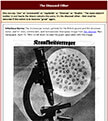
The Diseased Other (Apr 19, 2017) One can say “Jew” or “communist” or “capitalist” or “Mexican” or “Muslim.” The
name doesn’t matter: in our hearts the dream remains the same. It’s the diseased other—that must be removed if the nation
is to become “great” again. Infectious Germs: The microscope reveals symbols for the British pound and the American
dollar, and for Jews, communists, and homosexuals (triangles).
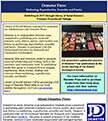
Demeter Press: Exhibiting through LSS's Premium Promotional Package (Apr 13, 2017) Library of Social Science is
pleased to announce our collaboration with Demeter Press. Demeter is an independent feminist press committed to publishing
peer-reviewed scholarly work, fiction, poetry, and creative non-fiction on mothering, reproduction, sexuality and family.
Demeter is partnered with the Motherhood Initiative for Research and Community Involvement.
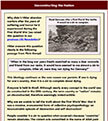
Dying for one's country: it would be a sin to complain (Mar 31, 2017) Why didn’t Hitler abandon warfare after the
years of suffering and horror he’d experienced during the First World War (we raised this question in our previous LSS
Newsletter)? Hitler answers this question clearly in the following passage from Mein Kampf: “When in the long war years
Death snatched so many a dear comrade and friend from our ranks, it would have seemed to me almost a sin to complain.
After all, were they not dying for Germany?”
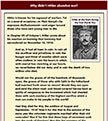
Why didn't Hitler abandon warfare? (Mar 31, 2017) Hitler is known for his espousal of warfare. Yet on a several
occasions—in Mein Kampf—he expresses disillusionment—and anger toward those who have sent young men to die. In Chapter
VII of Volume I, Hitler wrote about his reaction on learning that Germany had surrendered on Nov 10, 1918: And
so, it had all been in vain. In vain all the sacrifices and privations; in vain the hunger and thirst of months which
were often endless; in vain the hours in which, with mortal fear clutching at our hearts, we nevertheless did our duty;
and in vain the death of two million who died.
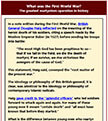
The greatest martyrdom operation in history (Mar 28, 2017) In a note written during the First World War, British
General Douglas Haig reflected on the meaning of the heroic death of his soldiers, citing a speech made by the Moslem
Emperor Baber (in 1527) before sending his troops into battle: “The most High God has been propitious to us—that if
we fall in the field, we die the death of martyrs; if we survive, we rise victorious the avengers of the cause of God.”
This statement, Haig said, conveyed the “root matter of the present war.” The ideology or philosophy of this British
general, it is clear, was identical to the ideology or philosophy of contemporary Islamic radicals.
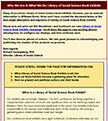
Who We Are & What We Do: LSS Book Exhibits (Mar 28, 2017) Many of you know Library of Social Science Book Exhibits.
However, you’ve received information in different forms. Orion and I have created the document below as the best single
description and depiction of Library of Social Science Book Exhibits. Please save and print out this Newsletter—and
bookmark our new Library of Social Science Book Exhibits Homepage. Scroll down the page to view exciting photos: showing
how we configure our displays, and how conferees react.
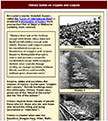
History builds on cripples and corpses (Mar 22, 2017) Bin Laden’s mentor Abdullah Azzam—called the “Lenin of international
jihad”—produced a philosophy of history more precise than that of Hegel or Nietzsche (certainly more concise): “History
does not write its lines except with blood. Glory does not build its loft edifice except with skulls. Honour and respect
cannot be established except on a foundation of cripples and corpses. Empires, distinguished peoples, states and societies
cannot be established except with examples. Indeed, (one cannot) change reality, or change societies, without blood,
sacrifices and invalids, without pure, innocent souls.”
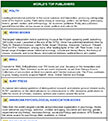
WORLD'S TOP PUBLISHERS (Mar 16, 2017) #1 POLITY: Leading international publisher in the social sciences and humanities,
producing cutting-edge work of the highest quality. Particularly strong in sociology, politics, social theory, philosophy,
history, gender studies, and anthropology. An academic publisher, Polity also publishes general interest titles on key
issues in social, political and cultural life.
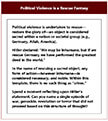
Political Violence is a Rescue Fantasy (Mar 15, 2017) Political violence is undertaken to rescue—restore the glory
of—an object is considered sacred within a nation or societal group (e.g., Germany, Allah, America). Hitler declared:
“We may be inhumane, but if we rescue Germany we have performed the greatest deed in the world.” Spend a moment reflecting
upon Hitler’s statement. Can you name a single episode of war, genocide, revolution or terror that did not proceed based
on this structure of thought?
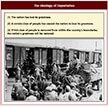
Deportation (Mar 15, 2017) (1) The nation has lost its greatness. (2) A certain class of people has caused the nation
to lose its greatness. (3) If this class of people is removed from within the country’s boundaries, the nation’s greatness
will be restored.
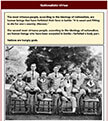
Nationalistic Virtue (Mar 15, 2017) The most virtuous people, according to the ideology of nationalism, are human
beings that have forfeited their lives in battle: “It is sweet and fitting to die for one’s country (Horace).” The second
most virtuous people, according to the ideology of nationalism, are human beings who have been wounded in battle—forfeited
a body part. Nations are hungry gods.
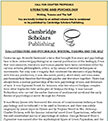
Call For Chapter Proposals: Literature and Psychology (Mar 15, 2017) Centuries ago, Aristotle fashioned a term that
brought literature and psychology face to face: catharsis (psychological or mental purification of the feelings). From
that time onwards, literature and human psyche have been correlated either by various writers, philosophers, critics,
or by means of several techniques or movements. Not only was it tragedy that combined the elements of psychology with
literary production, it was also novel, poetry, short story and even some psychoanalytical theories that brought psyche
and literature together.
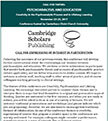
Call for Papers: Psychoanalysis and Education (Mar 14, 2017) Following the successes of our previous events, this
conference will develop further conversations about the relationships and tensions between psychoanalysis and education.
We are keen to invite submissions to participate that involve both psychoanalytic theory and accounts of psychoanalytic
practice (where applicable), and we define education in its widest context. We hope to welcome academic staff, teaching
staff in other areas of practice, and of course colleagues working primarily in clinical settings.

Koenigsberg's Second Law (Mar 08, 2017) The nature of the entity or idea for which human beings die is fungible.
The mechanism is the same: death and memorials erected in the name of those who have died—testify to the reality of
the entity or ideal. Death and memorialization perform a validation function.
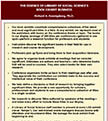
The essence of the book exhibit business (Mar 08, 2017) Our book exhibits constitute comprehensive collections of
the latest and most significant titles in a field. At any exhibit, we represent most of the publishers with books on
the conference theme or topic. The books in our display (average of 260 titles per conference)—gathered in one spot—perform
a research function for professors and students. Instructors discover the significant books in their field for use in
research and course development.

Koenigsberg's First Law (Mar 08, 2017) Wars are fought to testify to the truth of a society’s sacred ideals. If
so many people have died for an ideology—it must be real.
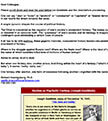
Political history as the enactment of a series of fantasies (Mar 07, 2017)One can say “Jew” or “kulak” or “landlord”
or “communist” or “capitalist” or “Islamic terrorist” or “infidel:” in our hearts the dream remains the same. A single
dynamic shapes the course of political history. The Other is conceived as the negation of one’s society’s omnipotent
fantasy. The enemy symbolizes doubt or disbelief in an absolute truth. The “greatness” of one’s society and its ideology
is imagined to be contingent upon eliminating a certain class of people.

Exciting Opportunities for Writers/Authors (Wendy Goldman Rohm) (Feb 20, 2017)We are presenting a number of creative
retreats and workshops for authors of nonfiction and fiction in 2017, as well as our ongoing online 12-week Master Class,
for those who cannot attend our workshops in person but seek an in-depth, extended course. This Sunday we start our
new session of the online course, and are accepting 10 writers. Click on the link above for more information, including
the course syllabus. Please register via the Register page.
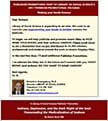
Making your books famous: LSS's 2017 Premium Promotional Package (Feb 10, 2017)Library of Social Science is expanding
its services. We want to do more for you (representing your books at exhibits remains the bedrock). To begin, we will
help publicize and promote recent titles: to HELP MAKE YOUR BOOKS (and their authors) FAMOUS. Please scroll down to
see a Newsletter that we just distributed to 35,000 scholars, professionals and students around the work (a Jessica
Kingsley title). In the next few days, I’ll send additional Publisher Promotions. I’ve selected the titles, but in the
future we’ll consult with you: WHAT BOOKS (and authors) DO YOU WANT TO MAKE FAMOUS?
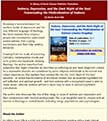
Sadness, Depression & the Dark Night of the Soul (Jessica Kingsley) (Feb 08, 2017)Revealing a tension between the
medical model of depression and the very different language of theology, this book explores how religious people and
communities understand severe sadness, their coping mechanisms and their help-seeking behaviors. Drawing from her study
of practicing Catholics, contemplative monks and nuns, priests and laypeople studying theology, the author describes
how symptoms that might otherwise be described as pathological and meet diagnostic criteria for a depressive disorder
are considered by some religious individuals to be normal and valued experiences.
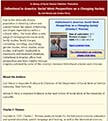
New title: "Fatherhood in America" (Charles C Thomas) (Feb 08, 2017)Due to the ethnically diverse population in
America, culture and context frames the nature of fathering and shapes expectations within a cultural milieu. The book
offers a wide range of vantage points–social work, family studies, family therapy, counseling, sociology, psychology,
gender studies, ethnic studies, urban studies, and health. Applicable in classrooms and treatment situations, Fatherhood
in America offers fresh perspectives and keen insights through chapters authored by some of the country's foremost fatherhood
scholars and clinicians
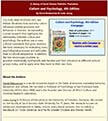
New title: "Culture and Psychology" (Cengage) (Feb 08, 2017)CULTURE AND PSYCHOLOGY, 6th Edition: illustrates how
and why culture influences mental processes and behaviors in humans. Incorporating current research that highlights
the relationship between culture and psychology, the authors use a cross-cultural framework that gives students the
tools necessary for evaluating many psychological processes and principles from a cultural perspective. In addition,
the text encourages students to question traditionally held beliefs and theories and their relevance to different cultural
groups today, and to apply what they learn to their own lives.
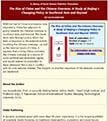
New title: "The Rise of China and the Chinese Overseas" (ISEAS) (Feb 08, 2017)With the rise of China and massive
new migrations, China has adjusted its policy towards the Chinese overseas in Southeast Asia and beyond. This book deals
with Beijing's policy which has been a response to the external events involving the Chinese overseas—as well as the
internal needs of China. It appears that a rising China considers the Chinese overseas as a source of socio-political
and economic capital, and would extend its protection to them whenever this is not in conflict with its core national
interest. The impacts on and the responses of the relevant countries are examined.
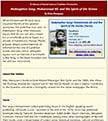
New Title: "Redemption Song" (Verso) (Feb 08, 2017)When Muhammad Ali died, many mourned the life of the greatest
sportsman the world had ever seen. In Redemption Song, Mike Marqusee argues that Ali was not only a boxer but a remarkable
political figure in a decade of tumultuous change. Playful, popular, always confrontational, Ali refashioned the role
of a political activist and was central, alongside figures such as Malcolm X and Martin Luther King, to the black liberation
and the anti-war movements.
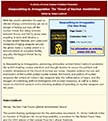
New title: "The Threat of Nuclear Annihilation" (The New Press) (Feb 07, 2017)Library of Social Science—the world’s
foremost book exhibit management company—is developing new ways to publicize and sell its clients’ books. We will select
from among the best titles recently released—and will distribute promotional material and purchasing information to
our database of 35,000 scholars, professionals and students. Eventually, we will consult with our publisher clients—and
authors—for input on titles they would like us to feature.
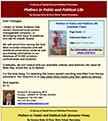
New title: "Mothers in Public & Political Life" (Demeter Press) (Feb 07, 2017)Library of Social Science—the world’s
foremost book exhibit management company—is developing new ways to publicize and sell its clients’ books. We will select
from among the best titles recently released—and will distribute promotional material and purchasing information to
our database of 35,000 scholars, professionals and students. Eventually, we will consult with our publisher clients—and
authors—for input on titles they would like us to feature.

Nazism as Psychotic Fantasy (Goebbels) (Feb 06, 2017)“Every Jew is our enemy in this historic struggle, whether
he vegetates in a Polish ghetto or carries on his parasitic existence in Berlin or Hamburg or blows the trumpets of
war in New York or Washington. All Jews by virtue of their birth and their race are part of an international conspiracy
against National Socialist Germany. They want its defeat and annihilation, and do all in their power to bring it about.”
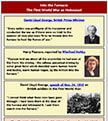
Into the Furnace: First World War as Holocaust (Feb 03, 2017)The First World War as Holocaust: David Lloyd George,
British Prime Minister: “Every nation was profligate of its manpower and conducted the war as if there were no limit
to the number of men who were fit to be thrown into the furnace to feed the flames of war.” The First World War, Jul
28, 1914 – Nov 11, 1918, claimed the lives of at least 6,000 men a day.

Feeding the God (Jan 31, 2017)Rudolf Hess on the Nazi god: The stream of blood which flows for Germany is eternal
— the sacrifice of German men for their Volk is eternal — therefore Germany will also be eternal. Lopez Austin on the
Aztec god: As long as men could offer the blood and hearts of captives taken in combat, the sun god would continue on
his course above the earth. It was necessary to feed the sun every day with its food, the precious water, that is, with
human blood.
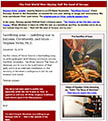
Slaying half the seed of Europe, one by one (Jan 26, 2017)Stephen Hicks’ website recently linked to an LSS Guest
Newsletter, “Sacrificial Heroics” (Carol Delaney). Based on the Newsletter, he created his own post, adding an image
and commentary. In her essay, Delaney quotes Wilfred Owen’s famous poem, “The Parable of the Old Man and the Young.”
When Abraham is about to offer the ram as a substitute sacrifice, he decides not to do so, but instead slays his son—“And
half the seed of Europe, one by one.”
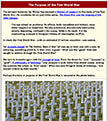
The Purpose of the First World War (Jan 24, 2017)The eminent historian Jay Winter has devoted a lifetime of research
to the study of the First World War. He concludes his six-part video series, The Great War and the Shaping of the 20th
Century: "The war solved no problems. Its effects, both immediate and indirect, were either negative or disastrous.
Morally subversive, economically destructive, socially degrading, confused in its course, futile in its result, it is
the outstanding example in European history of meaningless conflict." In short, the First World War—with an estimated
37 million casualties—was useless.
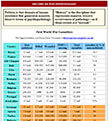
History as Psychopathology (Jan 24, 2017)Politics is that domain of human existence that generates massive, bizarre
forms of psychopathology. “History” is the discipline that represents massive, bizarre occurrences of pathology—as if
these events are “normal.”
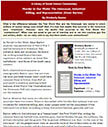
Mass-murder: First World War vs. Holocaust (Jan 23, 2017)What is the difference between the First World War and
the Holocaust, two events in which millions of human beings were killed? Well, it’s clear that deaths that occurred
in the Holocaust were “intentional.” However, were the deaths that occurred in the First World War “unintentional?”
When men are asked to get out of trenches and to run into machine-gun fire and artillery shells—do we really wish to
say that their deaths were unintentional?
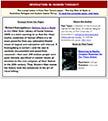
Revolution in Human Thought (Jan 20, 2017)"Richard Koenigsberg’s Nations have a Right to Kill (New York: Library
of Social Science, 2009) is a stark warning to us that the ritual mythic undertow of human affairs is a lot more powerful
than any rationalist Realist vision of logical and calculative self-interest. If Koenigsberg is correct – and his case
is carefully documented and powerfully reasoned – then over 200 million people were quite literally sacrificed in violent
rituals of devotion to the civic religions of their Nation in the 20th century. Thus, Modern Man makes the Aztecs look
like armatures in the art of ritual killing."
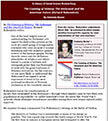
World War I as Mass Extermination (Jan 13, 2017)From the review: “Rubenstein understands World War I as a
moment in which human societies developed the capacity for mass extermination of their own members.” Rubenstein
traces the transformation of society that culminated in the Holocaust— through which leaders came to view their own
populations as expendable—to earlier historical events. He notes that World War I generals whose strategies caused mass
casualties among their own troops enjoyed public approval.
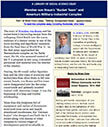
Part II: Wernher von Braun & America’s Military-Industrial Complex (Brian Crim) (Jan 12, 2017)One thing both proponents
and critics of Project Paperclip could agree upon was Wernher von Braun’s essentially transactional worldview. Whether
he wore an SS uniform or bore NASA credentials, von Braun’s agenda was transparent when it came to developing rockets:
“We felt no moral scruples about the possible future use of our brainchild. We were interested solely in exploring space.
It was simply a question with us of how the golden cow could be milked most successfully.”

Wernher von Braun & America’s Military-Industrial Complex (Brian Crim) (Jan 12, 2017)The story of Wernher von Braun
and his rocket team’s harrowing escape from the collapsing Third Reich into the warm embrace of a former enemy is one
of the more exciting and significant moments from the final days of World War II. As the Red Army approached the Peenemünde
complex on the Baltic coast, the SS, who assumed control of the V-2 program in late 1944, evacuated personnel and material
into the interior of the country.
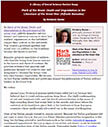
Death & Degradation in the Great War (Jan 06, 2017)In
Mark of the Beast: Death and Degradation in the Literature of the Great War, Alfredo Bonadeo surveys literary and
historical sources to show how soldiers’ experiences on the battlefield shaped their outlook on life and death. He provides
evidence that generals and politicians thought war could be easy and inexpensive—because the troops were less-than-human;
expendable. He focuses on how Italian intellectuals and politicians shaped the philosophies of Italian military leaders
in the Great War.
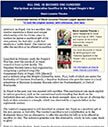
Martyrdom as Generative Sacrifice (Jan 06, 2017)In Nepal, war is a sacrifice. The warrior maintains a direct and
unique relationship with the divine, since in warfare he makes a sacrificial gift of his own person, the bali dân—a gift
that results in a ‘noble death’. The warrior can offer the sacrifice or be offered in sacrifice. Marie Lecomte-Tilouine
is Senior Researcher in Social Anthropology at CNRS, France, and teaches at the Institut National des Langues Orientales,
Paris.
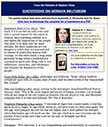
German Militarism (Stephen Hicks) (Jan 06, 2017)Immanuel Kant (1724-1804): “War itself, if it is carried on with
order and with a sacred respect for the rights of citizens, has something sublime in it, and makes the disposition of
the people who carry it on thus only the more sublime, the more numerous are the dangers to which they are exposed and
in respect of which they behave with courage. On the other hand, a long peace generally brings about a predominant commercial
spirit and, along with it, low selfishness, cowardice, and effeminacy, and debases the disposition of the people.”
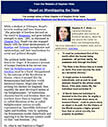
Hegel on Worshipping the State) (Jan 06, 2017)While a student at Tübingen, Hegel’s favorite reading had been Rousseau.
“The principle of freedom dawned on the world in Rousseau, and gave infinite strength to man.” [88] As discussed in
Chapter Two, Hegel was also engaged deeply with the latest developments of Kantian and Fichtean metaphysics and epistemology
and their implications for social and political thought.
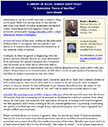
A Subversive Theory of Sacrifice (David Weddle) (Jan 02, 2017)Sometimes it can be a useful exercise to stand a thing
on its head. What was on top sinks to the bottom—and what was nearly invisible dominates the field of vision. Something
like that happens when the surrealist philosopher Georges Bataille (1897–1962) reflects on “theory of religion.” In
his brief work of that title, written in the aftermath of World War II, he argues that the sacred is not above us in
transcendent isolation but beneath us in the intimate order of nature.
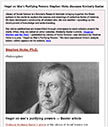
Hegel on War's Purifying Powers (Baxter & Hicks) (Jan 02, 2017)Library of Social Science is a Scholarly Research
Institute bringing together the finest authors in the world to explore the sources and meanings of collective forms
of violence. We have developed a community of scholars who cite one another—speeding up the development of knowledge
and understanding. Our online publications are transmitted through cyberspace to reach scholars around the world. Often,
they are noted on other websites. Kimberly Baxter’s article, “Hegel on Warfare and the State”—published by Library of
Social Science—was discussed by Stephen Hicks in a post, “Hegel on War's Purifying Powers.”
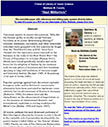
Nazi Militarism (Matthew Caverly) (Dec 22, 2016)This essay aspires to answer the question, “Why did the German polity
so readily accept National Socialism as its power-determining ideology?” Scholars, statesmen, journalists, and other
interested onlookers have grappled with this question far longer than the Third Reich’s rise and fall. Some have claimed
that the repressive peace imposed on the Germans in the wake of the First World War—the Treaty of Versailles—is to blame.
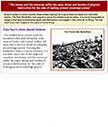
Making present sovereign power (Dec 21, 2016)Does it matter to which country these bodies belong? As long as there
are dead and mutilated bodies. The First World War was waged to prove the existence of countries. It is nearly impossible
to imagine that such monumental death and destruction was waged in the name of no thing. The war must have been waged
in the name of some thing.
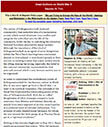
Part III: Ideology & Motivation on the Eastern Front (Stephen Fritz) (Dec 21, 2016)This is Part III of Stephen Fritz's
paper—“We are Trying to Change the Face of the World:” Ideology and Motivation in the Wehrmacht on the Eastern Front.
The notion of Volksgemeinschaft (national community), that seductive idea of a harmonious society which would eliminate
class conflict and integrate the individual into the life of the community, holds the key to unlocking the attraction
National Socialism asserted for many Landser.
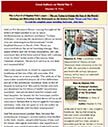
Ideology & Motivation on the Eastern Front (Part II of Stephen Fritz's paper) (Dec 21, 2016)This is Part II of Stephen
Fritz's paper—“We are Trying to Change the Face of the World:” Ideology and Motivation in the Wehrmacht on the Eastern
Front. And yet the dominant theme running throughout the letters of these Landser is not so much disillusionment as
stubborn resiliency. “In deep darkness, I sit among the vacationers (those on leave) who are returning from the homeland,”
wrote Siegfried Roemer in March 1944.
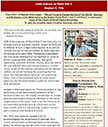
Great Authors on World War II: Stephen Fritz (Dec 20, 2016)This is Part I of Stephen Fritz's paper—
“We are Trying to Change the Face of the World”: Ideology and Motivation in the Wehrmacht on the Eastern
Front
—Parts II and III will follow in subsequent issues of the Library of Social Science Newsletter. ONE of the enigmas
of World War II has been why the average German Landser (soldier) fought so furiously in defense of such a deplorable
regime.
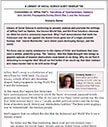
Totalitarianism & Anti-Semitic Propaganda (Dec 20, 2016)Library of Social Science is continuing to present, analyze
and promote the writings of Jeffrey Herf on Nazism, the Second World War, and the Final Solution—because we think his
work is extremely important. Why? Herf demonstrates that both the Holocaust and the war against the Soviet Union grew
out of a single paranoid fantasy: that “Jewish-Bolsheviks” were intent upon destroying Europe, and the world.
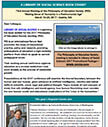
Book Exhibit: Book Exhibit: Philosophy of Education Society meeting (Dec 16, 2016)LIBRARY OF SOCIAL SCIENCE is organizing
the book exhibit for the 2017 Philosophy of Education Society meeting (PES). PES is an international forum that promotes
the study of educational practice, policy and research, providing philosophers of education a high-visibility platform
from which to speak to current pedagogical issues. Their exciting annual conference explores education as a societal
institution—and more broadly as the process of existential growth.
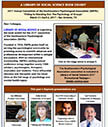
Book Exhibit: Southwestern Psychological Association convention (Dec 16, 2016)LIBRARY OF SOCIAL SCIENCE is organizing
the book exhibit for the 2017 convention of the Southwestern Psychological Association (SWPA). Founded in 1954, SWPA
prides itself on serving the psychological community by providing access to scientific advances and professional development
within a collegial atmosphere. With an international membership, SWPA’s exciting annual conference brings together nearly
1500 scholars, psychologists, therapists, counselors and students
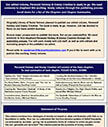
Book Proposal (Dec 16, 2016) Several months ago we sent out a call for book proposals for Cambridge Scholars Publishing
(see below). According to our records, you clicked through to download the proposal form. We are in close contact with
Cambridge Scholars Publishing and may be able to assist you: Have you sent a proposal to Cambridge Scholars Publishing?
Have you received any feedback from Cambridge Scholars Publishing?
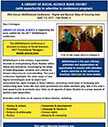
Book Exhibit: ASIANetwork conference (Dec 16, 2016)ASIANetwork is the primary organization devoted to strengthening
Asian Studies within liberal arts education, encouraging the study of Asian languages, societies and cultures to deepen
intercultural understanding. This year’s conference highlights the wide range of new digital technologies used
to depict and understand the rapid changes in Asian culture—providing novel ways of analyzing and constructing Asia.
Given the ever more prominent role Asian societies play, this is the year’s best opportunity to promote your titles
on all aspects of Asian Studies to a prime market of teachers and researchers.

Help us to publish "Paranoid Fantasy & Enemy Creation" (Dec 13, 2016)Originally Library of Social Science planned
to publish our edited volume, Paranoid Fantasy and Enemy Creation. The book is ready to go. However, LSS has decided
to focus on our book exhibit business. Several major presses wish to publish this book. But we are understaffed. We
need someone to help shepherd Paranoid Fantasy & Enemy Creation through the publishing process. You will work closely
with LSS staff, as well as with editors and marketing people at the publisher we select.
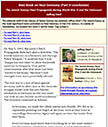
Nazi Propaganda during WW-II & the Holocaust (Dec 12, 2016)On May 5, 1943, the party's Reich Propaganda Directory
sent a directive, “The Jewish Question as a Domestic and Foreign Policy Weapon.” It asserted that it was “dangerous
and false” to allow the Jewish question to disappear from public consciousness after that issue had been “solved in
Germany,” because it had emerged even more powerfully abroad. “For this war is a war of Jews against Germany and its
allies. Just as the domestic struggle ended with the anti-Semitic revolution in Germany so this war must end with an
anti-Semitic world revolution.”
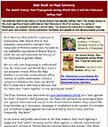
"The Jewish Enemy" (Herf) (Dec 12, 2016)Hitler’s equation of Bolshevism and Judaism is well known. Less attention
has been paid to how Hitler viewed the United States—and Franklin Roosevelt—as under the control of the Jewish demon.
In a speech of Dec 11, 1941, Hitler declared war on the United States to the Reichstag broadcast over German radio
and printed in full in the German press. He spoke for almost ninety minutes and reached a crescendo of hatred in his
attack on Franklin D. Roosevelt and the Jews around him.
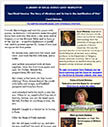
Sacrificial Heroics, Abraham & War (Carol Delaney) (Dec 12, 2016)Abraham showed his love of God by his willingness
to sacrifice his son. But what about his love for his son? The message to humans, affirmed in all three religious traditions
is that love of God must come first. Christianity takes the story a step further: it is God the Father who allows the
sacrifice of his only son. But what about his love for his son? Unlike Jesus, Isaac did not cry out: “Father, father
why have you forsaken me?” Regardless, both are portrayed as being at one with the father, a complete submission of
their will to the Father. Theological interpretations of “at-one-ment” abound; here I will focus on what I think is
behind the story and the implications of this sacred model for human behavior and morality.

Part III: Best book on Nazi Germany (Herf) (Dec 12, 2016)The term “Jewish Bolshevism” lay at the core of the ideology
that generated the Second World War. Given Nazi claims about “Jewish Bolshevism,” Herf feels that it is important to
take note of the actual role of Jews in Soviet political life. The historian Benjamin Pinkus (1988) assessed the statistical
representation of Jews within the power institutions of the party—the Central Committee, Politburo, Secretariat, and
government bureaucracies—and concludes that there was “no historical basis” for claims that the Bolshevik regime was
the work of the Jews.

Part II: Best book on Nazi Germany (Herf) (Dec 09, 2016)The editorial staff of the Library of Social Science has
selected Jeffrey Herf’s The Jewish Enemy as the most significant book published on Nazi Germany in the 21st century.
In a series of Newsletters, we present this book’s central ideas. The essence of scholarship is citation: ideas build
upon one another. Online publication facilitates and speeds up this developmental process. environments.

Best book on Nazi Germany: The Jewish Enemy (Herf) (Dec 09, 2016)The editorial staff of the Library of Social Science
has selected Jeffrey Herf’s The Jewish Enemy as the most significant book published on Nazi Germany in the 21st century.
In a series of Newsletters, we present this book’s central ideas. The essence of scholarship is citation: ideas build
upon one another. Online publication facilitates and speeds up this developmental process.
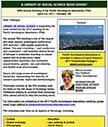
Book Exhibit: Pacific Sociological Association meeting (Dec 08, 2016)LIBRARY OF SOCIAL SCIENCE is organizing the
book exhibit for the 2017 meeting of the Pacific Sociological Association (PSA). The annual PSA meeting is one of the
largest and most popular sociological conferences, with well over 1,000 people expected to attend. This year’s meeting—“part
conference, part movement”—will examine various forms of betrayal in academia, touching on sexual assault and its prosecution,
equal opportunities questions, non-normative sexual identity, gender, race and ethnicity, and hostile work environments.
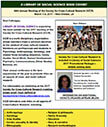
Book Exhibit: Society for Cross-Cultural Research (SCCR) (Dec 07, 2016)LIBRARY OF SOCIAL SCIENCE is organizing the
book exhibit for the 2017 meeting of the Society for Cross-Cultural Research (SCCR). SCCR is a multi-disciplinary organization
whose members share a common devotion to the conduct of cross-cultural research. Members are professionals and students
in Psychology, Anthropology, Sociology, and related fields including Education, Family Studies, Social Work, Human Development,
Psychiatry, Communications, Ethnic Studies, Business, etc.
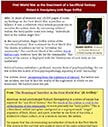
First World War as Enactment of a Sacrificial Fantasy (Dec 07, 2016)After 26 years of research and 10,000 pages
of notes, my findings on the First World War crystallize as follows: It was a collective ritual whose purpose was to
sacralize the nation-state. By consuming soldiers’ bodies, the body politic came into being: “Individuals died so the
nation might live.” In the excerpt below, Roger Griffin writes of the “sacrificial fantasy” that sustained the First
World War.
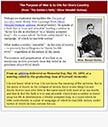
The Purpose of War (is to die for one's country) (Dec 06, 2016)Perhaps no statement exemplifies the The Law of Sacrifice
more clearly than a passage from Oliver Wendell Holmes’ address (excerpt below). He speaks of a faith that is “true
and adorable” leading a soldier to “throw his life in obedience” to a “blindly accepted duty”—for a cause which “he
little understands” in a campaign “of which he has little notion.” What makes a soldier “adorable”—in the eyes of society—is
precisely his willingness to “throw his life away”—regardless of the nature of the cause.
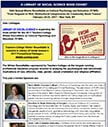
Book Exhibit: Teachers College Winter Roundtable (Dec 06, 2016)LIBRARY OF SOCIAL SCIENCE is organizing the book
exhibit for the 2017 Teachers College Winter Roundtable on Cultural Psychology and Education (TCWR). The Winter Roundtable—sponsored
by Teachers College—is the longest-running professional education program devoted to studying the psychological and
educational implications of race, ethnicity, class, gender, sexual orientation and religious affiliation. Teachers College
Winter Roundtable is included in Library of Social Science's 2017 Promotional Package—details coming soon.
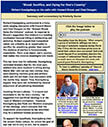
Blood, Sacrifice, & Dying for One's Country (Koenigsberg on the radio) (Dec 02, 2016)Richard Koenigsberg participated
in a lively, wide-ranging discussion with Howard Bloom and Chad Dougatz on the “Howard Bloom Saves the Universe” podcast.
In response to Bloom’s suggestion that violence is a bonding mechanism because killing is exhilarating and addictive,
Richard argued that humankind values war primarily as an opportunity to sacrifice for something greater than oneself.
The violence of warfare is fundamentally masochistic. There is an object, one’s country, that makes the violence meaningful
and moral.
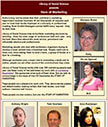
Stars of Marketing (Dec 01, 2016)Library of Social Science works with over 300 marketing people each year (we listed
many of the publishers we work with in a previous Newsletter). We appreciate what each of them does. But we wish to
acknowledge in this issue of the LSS Newsletter the STARS OF MARKETING. These people are a pleasure to work with. They
demonstrate passion and determination making certain that their books—and their authors—become well known.
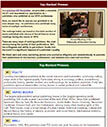
Top-Ranked Presses (Dec 01, 2016)In a previous LSS Newsletter, we provided a complete list of—and expressed our
appreciation to—publishers who exhibited at our 2016 conferences. Here, we would like to express our gratitude in an
even deeper way—to publishers who exhibited many books at multiple conferences. The rankings below are based on the
total number of books exhibited with Library of Social Science at our meetings during the course of 2016.
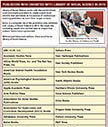
Publishers who exhibited with LSS in 2016 (Nov 30, 2016)Library of Social Science works with the world’s finest,
most prominent publishers to create superb book exhibits that contribute to the success of conferences— enabling publishers
to reach their target markets. Below is a complete list of the publishers who exhibited with Library of Social Science
in 2016. We thank the marketing people who worked hard to ensure that authors’ books were represented.
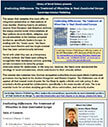
Eradicating Differences (Cambridge Scholars Publishing) (Nov 30, 2016)The essays that comprise this book offer an
integrated perspective on Nazi policies of mass murder. Drawing heavily on primary sources from European and American
archives, the essays provide novel interpretations of Nazi policies vis-à-vis ethnic, religious, and sexual minorities
in the German-occupied territories, specifically Eastern Europe. In dealing with the “lesser races,” the Nazis proved
more flexible and less single-minded than has been conventionally believed.
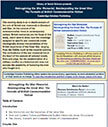
Reimagining the War Memorial (Cambridge Scholars Publishing) (Nov 28, 2016)This exciting study is an in-depth analysis
of the role of British war memorials in literature and film—in the context of the commemorative trend in contemporary
culture. British memorials are the focus of this study, which aims to show how the meanings assigned to specific war
memorials create ideologically diverse interpretations of the British experience of the Great War, ranging from the
futility myth to the imperial sublime.
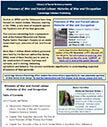
Prisoners of War and Forced Labour (Cambridge Scholars Publishing) (Nov 28, 2016)Studies on WW2 and the Holocaust
have long focused on Jewish victims. However, starting in the 1990s, a new wave of research opened the Pandora’s box
of the Nazi genocide. This volume—stemming from a symposium held at the Falstad Memorial and Human Rights Centre (Norway)—focuses
on an under-researched topic: prisoners of war and forced labor.
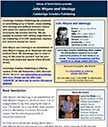
Black and White Masculinity (Cambridge Scholars Publishing) (Nov 28, 2016)Building on the rich historiography of
gender and culture undertaken in recent years, this volume highlights the important role Southern conceptions of masculinity
have played in the lives of Southern men, and to reflect on how masculinity has intersected with class, race and power
to structure the social relationships between blacks and whites throughout the history of the South.

John Wayne and Ideology (Cambridge Scholars Publishing) (Nov 28, 2016)Cambridge Scholars Publishing has produced
an astonishing array of books—many dealing with ideology and political violence—topics with which the Library of Social
Science community has become familiar. We are pleased to present their cutting edge titles to our readership of 34,000
researchers, teachers and students around the world. John Wayne and Ideology is an examination of John Wayne’s legacy
as an American icon and political force. We encourage you to order a copy of this book for yourself, and for your library.
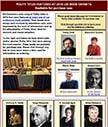
Featured titles from Polity (Nov 28, 2016)We featured a wide array of Polity titles in 2016 that were featured at
every one of our conference book exhibits. Their books were always well-received by attendees—who were impressed by
the level of scholarship—and by the affordability of Polity titles: ideal for research and course adoption. To the right
and below we have listed (with author photos) Polity titles that were among the most popular. These books are available
for purchase now. Please click through any link to learn more about a title—and for information on ordering.
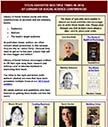
Frequently exhibited titles (Nov 23, 2016)Library of Social Science works with three constituencies to promote and
sell scholarly books: Publishers, Authors, The book’s target audience. As publishers know, authors are often reticent
about promotion. Is this because they are shy or—more likely—because they want to get on to the next: a book that will
be even bigger and better? Library of Social Science encourages authors to lift their eyes away from research and writing—and
to become involved in marketing their book.
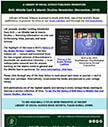
New titles in Middle East & Islamic Studies (Brill) (Nov 22, 2016)LSS presents another exciting Newsletter from
Brill — on Middle East & Islamic Studies — featuring information on new and forthcoming titles, journals, and book reviews.The
highlight of this issue is Brill's History of the Arabic Written Tradition. This two-volume set — revised and translated
from the two original volumes of Brockelmann’s
Geschichte der arabischen Litteratur — is an indispensable research tool for anyone working on the Islamic world
in general and the Middle East in particular.
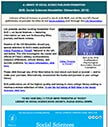
New titles in Social Science (Brill) (Nov 22, 2016)LSS presents another exciting Newsletter from Brill — on Social
Sciences — featuring information on new and forthcoming titles, journals, and book reviews. Readers of the LSS Newsletter
should pay special attention to Brill's newly published China: Promise or Threat?, featured to the left, and below.
This title investigates the causes and effects of China's military confrontations, religious differences, cultural history,
and societal problems. For more information, click here.
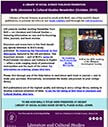
New titles on Literature & Cultural Studies (Brill) (Nov 21, 2016)LSS presents another exciting Newsletter from
Brill — on Literature and Cultural Studies — featuring information on new and forthcoming titles, journals, and book
reviews. Educators and researchers in this field should pay special attention to Brill's newly published Re-Inventing
the Postcolonial (in the) Metropolis, featured to the left and below. This important volume — part of Brill's series
on Post/Colonial Literatures and Cultures in English — offers a wide-ranging study of postcolonial metropolises and
the topic of the urban.
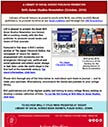
New titles on Asian Studies (Brill) (Nov 21, 2016)LSS is pleased to present the latest Brill Asian Studies Newsletter
(see below). We’re working closely with this fine publisher to promote recent books and issues of their journals. Featured
in this issue is Brill's online edition of The Japan Chronicle Online, the newspaper of record for Japan’s engagement
with modernity and its emergence—through war, political and social upheaval and seismic social change in East Asia—onto
the world stage in the first half of the twentieth century.
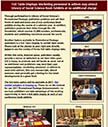
Full Table Displays (Nov 21, 2016)Through participation in Library of Social Science’s Promotional Package, publishers
publicize and sell their books at each and every one of our conference book exhibits during the course of a calendar
year. In addition, publishers promote their titles through the LSS Newsletter, which reaches 35,000 scholars, professionals,
students and publishing executives around the world. Another feature available to Promotional Package publishers is
a Full Table Display to exhibit their books. Please look at the photos to your right and directly below to see the variety
of forms full-table displays take.
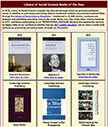
Books of the Year: Library of Social Science (Nov 18, 2016)In 2016, Library of Social Science increased the channels
through which we promote publishers’ books. In addition to publicizing and selling titles at conference exhibits, we
promoted selected titles through the Library of Social Science Newsletter—distributed to 35,000 scholars, professionals,
students and publishing executives around the world
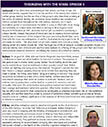
Episode III: Theorizing with the Stars (Nov 16, 2016)It has often been acknowledged that nations are born of war.
Yet recent scholarship suggests that it is not the sacrifice of the enemy that creates a unified group identity, but
the sacrifice of the group’s own. Described as being at the centre of national identity, the Australian Anzac tradition
has remained an intrinsic cultural facet throughout the 20th century.
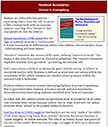
National Boundaries (Nov 15, 2016)Nations are defined by boundaries— separating others from the self. A nation is
like a human body with an immune system: repelling alien “invaders” that may penetrate into the interior. Ronnie Lipschutz
(1998) states that the logic of national security is “exclusionist.” It draws boundaries to differentiate within from
without. Secure borders mean “differentiating self from others.”
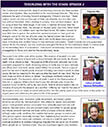
Theorizing With the Stars: Episode 2 (Nov 15, 2016)The Communists enshrined the ideal of revolutionary heroism into
their wartime culture of martyrdom. Mao expounded on the revolutionary heroism: “This army embraces the spirit of moving
forward unstoppably. If there is one man ” These martyrs would not only sacrifice part of their own interests, but also
their own lives without hesitation. Mao’s strategy in proving “man can beat weapon” lay in his using
at least four times larger, if not more, in number of troops than the enemy’s to eliminate them.
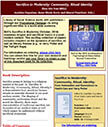
New title on sacrifice (Brill) (Nov 15, 2016)Library of Social Science works with publishers—through our Promotional
Package—to bring significant titles to a world-wide audience. Brill's Sacrifice in Modernity (Oct, 2016) examines
religion and sacrificial topics in a post-modern context. This exciting collection of papers includes chapters on the
dynamics of sacrifice, as well as literary themes (e.g., in Harry Potter and the Twilight Saga).
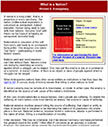
What is a Nation? (Nov 14, 2016)A nation is a body politic, that is, a projection of one’s own body. The nation
(unlike actual organisms) is conceived as omnipotent, indeed immortal. Human being seek to fuse with their nations—become
“one” with them—in the hope of achieving an omnipotent, immortal body. Nationalism is relocation of the self: from one’s
own body to an omnipotent body politic. One imagines one exists “out there”—participating in world historic events.
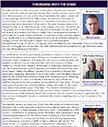
Theorizing With the Stars (Nov 14, 2016)The Father to the Son—the young men of the nation—the pure and innocent
youth—allow the nation to transcend through their stainless sacrifice, which is the force that vanquishes evil, just
as their blood replenishes the nation’s sacred soil, mingling perhaps with that of the fallen leader: The immortal community
of “honored dead.”
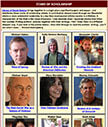
Stars of Scholarship (Nov 14, 2016)Library of Social Science brings together in a single place significant papers
and essays—and distributes these works of scholarship widely. A contribution disseminated through our Newsletter attains
a more substantial readership in a day than most journal articles receive in a lifetime. A characteristic of the Web
is the visual dimension. I was shocked when I explored photos that Orion had curated. Putting authors’ pictures together
with their writings, I felt I knew them in a different (deeper) way.
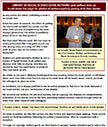
We love authors (and authors love us) (Nov 10, 2016)Authors are understandably thrilled to visit a Library of Social
Science book exhibit and discover their title on display. And they are excited to have the opportunity to promote their
own book on-site. We conceive our exhibits not just as a business, but as a service: our displays are comprehensive
collections of the newest titles in the field, providing authors another channel through which to share their latest
research with colleagues.
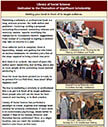
Dedicated to the promotion of significant scholarship (Nov 09, 2016)The mission of Library of Social Science is
to develop—at each of the conferences for which we organize a book exhibit—a comprehensive collection of new and significant
titles from the major publishers. We view exhibits as a service to attendees—conveying the “state of the art” in the
field, enabling scholars, researchers, teachers, practitioners and students to keep up with the latest developments.
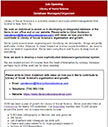
Job Opening: Database Manager/Organizer (Nov 07, 2016)Library of Social Science is a scholarly research and book
exhibit management firm located in New York City. We seek an individual to assist us in developing an integrated database
of the items in our office and on our website. Please write to Orion Anderson (oanderson@libraryofsocialscience.com)
with ideas on how you'd like to contribute to Library of Social Science's organization and growth.
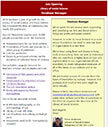
Job Opening: Library of Social Science (Nov 05, 2016) We've spent several years organizing and classifying our documents—things
are pretty well under control. However, to move forward on a more secure foundation, we need to raise our level of organization.
We've been using Excel and Access to keep track of everything. Now, we want to develop a more sophisticated database/organizational
system. We are located around 20 minutes from the heart of Manhattan by subway. However, perhaps much of this work can
be done remotely.
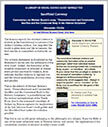
Sacrificial Currency (Alexander Chirila) (Nov 04, 2016)The correlation between violence and community formation
relies on another paradigm: belief that individual human bodies can be amalgamated into a communal Body as part—or members—of
a whole. Bryson states that this paradigm is related to the concept of centralized authority, “a dangerous anthropomorphizing
of community which suggests that—though it might be painful—some ‘members’ of the Body may be sacrificed for the good
of the whole Body.”
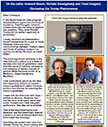
On the radio: discussing the Trump phenomenon (Nov 03, 2016) A wonderful Internet radio program, Howard Bloom Saves
the Universe, is hosted by Chad Dougatz. Howard invited me to join the show to explore the question, “Why does Donald
Trump stir us (either negatively or positively).” Readers of the LSS Newsletter have become familiar with my “voice”
through the written word. Now you have the opportunity to hear me speak. I hope you will click through and enjoy this
program—and that it generates some valuable insights.
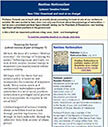
New title on nationalism! Free download! (Nov 02, 2016)Professor Frckoski was in touch with us recently about promoting
his book at one of our conference exhibits. We were excited to learn that—not only was his book about the psychology
of nationalism —but he was a prominent political figure himself, having run for President of Macedonia—and holding significant
political positions in the government. Is this a first? An important politician citing Lacan, Zizek—and Koenigsberg?
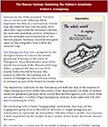
Deportation to restore the nation's greatness (Oct 24, 2016)Germans in the 1930s declared, “The Jews are our
misfortune.” Although Hitler expressed this idea in a more radical, vitriolic way, the essential idea was the
same. Jews were held responsible for Germany’s decline: her economic problems, political dilemmas—and the weakness
and vulnerability of the German people. Germany could become great again by removing Jews from within the national body.
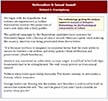
Nationalism & Sexual Assault (Oct 24, 2016)We begin with the hypothesis that nations are experienced as bodies.
Nationalism involves the projection of one’s own body into a body politic. The political campaign by the Republican
candidate (now nominee for President) began with a fantasy of sexual assault: Mexican rapists were entering the country.
America was being penetrated from down below.
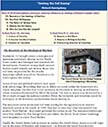
Destroy the Evil Enemy (Oct 20, 2016)Sep 11 brought about a resurgence of American patriotism. Attacks on
the World Trade Center and Pentagon had wounded the United States. President George Bush insisted that he would identify
and destroy those who had been responsible for the attacks. Americans rallied around the President to do battle against
the enemy.
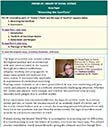
Mourning the Sacrifices (Part III) (Oct 20, 2016)The logic of sacrifice was created within the highest political
and ecclesiastical elite and communicated to the masses through educational institutions, religious teaching and propaganda.
In many cases people did embrace it to some extent; it was especially applicable to expressions of condolence mourning.
Finding reason in death, or on a more general level, in war, was comforting and gave words and phrases to people in
a delicate, emotionally challenging situation.
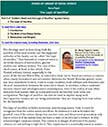
The Logic of Sacrifice (Part II) (Oct 19, 2016)The ideology used in describing both the sacrifice of the dead soldier
and the supposed attitudes of his family can be called “the logic of sacrifice.” This theoretical construct
owes a lot to the classics of nationalism, gender studies and military history. The core of this ideal comes, at least
in this article, from Finnish military history, especially in the years of the Second World War, in which this ideal
can be found on various occasions, often clearly formulated and articulated.
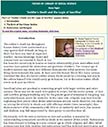
Soldier's Death and the Logic of Sacrifice (Oct 19, 2016)The soldier’s death has throughout human history
been understood as a very special kind of death. As long as there has been any kind of organized warfare, various meanings,
hopes and dreams have surrounded it. Death in war has been the surest way to heaven or similar otherworldly place; most
often dead warriors have gained the admiration and gratitude of others. The rational age of modern nations may seem
very different from ancient tribal societies, but some things have remained the same.
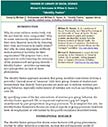
Identity fusion (Oct 19, 2016)Why do some soldiers instinctively risk life and limb for their compatriots? Why do
some community members sacrifice their own financial security by donating their time and treasure to needy others? And
why do some employees selflessly endure personal hardship for their organization? We propose that a new approach to
understanding the interplay of the personal self and group identity—identity fusion—provides a promising new perspective
on each of these phenomena.
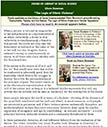
The Logic of Ethnic Violence (Glenn Bowman) (Oct 18, 2016)When a person is induced to imagine his or her self primarily
as a representative of an ethnic collectivity, a threat to that collectivity is simultaneously a threat to that person.
He or she not only sees the threatened co-national as ‘the same as’ his or her self, but also imagines that
co-national’s enemy as simultaneously an enemy to all those who share identity with the threatened one.
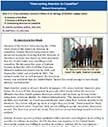
Overcoming Aversion to Casualties (Oct 18, 2016)Enemies of the United States during the 1990s were aware of the
American aversion to casualties. Colonel Richard Lacquement cites numerous examples showing that the behavior of America’s
enemies was based on their awareness that the United States was unwilling to risk casualties. He discusses the cases
of Saddam Hussein before the 1991 Gulf War, Slobodan Milosevic before the Kosovo war in 1999, and Osama Bin Laden and
al-Qaeda in 2001.
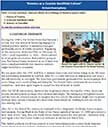
America as a Counter-Sacrificial Culture (Oct 18, 2016)During the 1990’s, the United States had become a society
that was averse to becoming engaged in violent political conflict. A mentality emerged profoundly averse to battle casualties.
Beginning at the conclusion of the Gulf War on February 28, 1991—until Sep 11, 2001—there seemed to be no political
situation that justified going to war. The United States hesitated to act if there was even a small probability that
America soldiers might be killed or wounded.
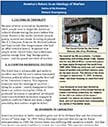
America's Return to an Ideology of Warfare (Oct 17, 2016)For most of my life as a scholar, I’ve been researching
and writing about Hitler, Nazism and the two World Wars. I presented papers on these topics throughout the world from
1990-2000. While my work was well-received, issues of warfare and political violence were on the back-burner. The climate
of the times changed on Sep 11, 2001. Suddenly, ideas I had been focusing on were front and center.
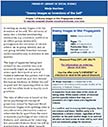
Enemy Images as Inversions of the Self (Marja Vuorinen) (Oct 17, 2016)A researcher must steer clear of the allure
of taking sides. While events unfold, all involved parties typically believe that they are in possession of a right
cause and a legitimate interest. In a conflict, and its ensuing historiography, there are winners and losers. Neither
party is in themselves a reliable witness, regardless of their position on the post-conflict stage. In an optimal situation
we have access to tales told by each side and can eventually judge for ourselves.
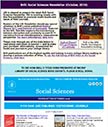
Brill Social Sciences Newsletter (Oct, 2016) (Oct 17, 2016)LSS is pleased to present the latest Brill Social
Sciences Newsletter. We’re working closely with this fine publisher to promote recent books and issues of their journals.
Readers of the LSS Newsletter should pay special attention to Brill's newly published Radical Planes? 9/11 and Patterns
of Continuity, featured to the left. This title explores the intersections between disruption and continuity in post-9/11
narratives from an interdisciplinary, transnational perspective.
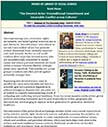
The Global Jihadi Archipelago (Scott Atran) (Oct 12, 2016)Jihadis span the population’s normal distribution: there
are a few psychopaths and sociopaths and some brilliant thinkers and strategists. Unlike the founding members of al-Qaeda,
today’s jihadi wannabes are mostly self-seeking young adults in transitional stages in their lives—immigrants, students,
people between jobs or mates or having left their native homes and looking for new families of friends and fellow travelers.
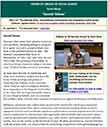
Identity Fusion and Group Dynamics (Scott Atran) (Oct 12, 2016)Our fieldwork with captured and would-be suicide
terrorists and political and militant leaders and supporters in violent conflict situations suggests that some behaviors
that punctuate the history of human intergroup conflict do indeed go beyond instrumental concerns. Historical examples
include the self-sacrifice of Spartans at Thermopylae, the Jewish Zealots in revolt against Rome, defenders of the Alamo,
the Waffen SS “volunteer death squads” during the Soviet siege of Budapest, some cohorts of Japanese Kamikaze, and the
jihadi pilot bombers of 9/11.
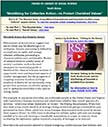
Mobilizing to Protect Cherished Values (Scott Atran) (Oct 12, 2016)Philosophers of moral virtue suggest that moral
values may be deontological or utilitarian. Deontic processing is defined by an emphasis on rights and wrongs, whereas
utilitarian processing is characterized by costs and benefits. Models of rational behavior predict many of society’s
patterns, such as favored strategies for maximizing profit or likelihood for criminal behavior in terms of opportunity
costs and important aspects of conflict management.

Sacred Values (Scott Atran) (Oct 11, 2016)Humans often make their greatest exertions and sacrifices, including killing
or dying for ill or good, not just to preserve their own lives or kin and kith but for an idea—the abstract conception
they form of themselves, of “who I am” and “who we are.” This is the “the privilege of
absurdity; to which no living creature is subject, but man only” of which Hobbes wrote in
Leviathan.

The Devoted Actor (Scott Atran) (Oct 11, 2016)Uncompromising wars, revolution, rights movements, and today’s
global terrorism are in part driven by “devoted actors” who adhere to sacred, transcendent values that generate
actions dissociated from rationally expected risks and rewards. Studies in real-world conflicts show ways that devoted
actors, who are unconditionally committed to sacred causes and whose personal identities are fused within a unique collective
identity, willingly make costly sacrifices. This enables low-power groups to endure and often prevail against materially
stronger foes.
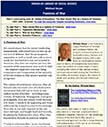
Passions of War (Michael Geyer) (Oct 11, 2016)We noted above that the Soviet leadership immediately radicalized
the war into an all-out war of defense, that the propaganda apparatus as well as hard-core cadres were ready for this
kind of a war and enacted it. However, this does not explain yet how the majority of the population was made to fight
– the regime’s approach was one thing; compliance and cooperation of the majority of Soviet citizens in this project
another one altogether.
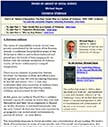
Extreme violence (Michael Geyer) (Oct 11, 2016)The sense of vulnerability even in victory was greatly exacerbated
by the nature of the Russian retreat. It confirmed the prejudices many of the Wehrmacht officers and soldiers harbored
and played into the hands of Nazi propaganda. As before with the German escalation of violence, reality (of Soviet ruthlessness)
trumped imagination.
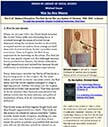
War by Any Means (Michael Geyer) (Oct 10, 2016)When, on 22 Jun 1941, the Third Reich invaded the Soviet Union with
overwhelming force, it crushed through the mass of Soviet forces deployed along the western border in the newly occupied
territories and in three prongs pushed deep into Soviet territory. Soviet casualties were enormous. Time and again,
the Red Army appeared to be teetering on the abyss. The Red Air Force was nearly wiped out. But although German forces
pushed ever deeper, the Soviet defenders fought tenaciously and slowed the German thrust sufficiently to overthrow German
expectations.
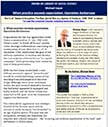
Operation Barbarossa (Michael Geyer) (Oct 10, 2016)Preparations for the war against the Soviet Union commenced on
31 Jul 1940 with Hitler’s order “to finish off Russia” amidst wider strategic deliberations concerning
the continuation of war. Directive 21, of 18 Dec 1940, established the goal of the military operation: to envelop
and destroy the vast majority of Soviet forces “in a quick campaign” while preventing their retreat by way
of deep penetration.
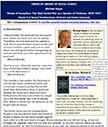
Nazi-Soviet War as a System of Violence (Michael Geyer) (Oct 10, 2016)Humans define the groups to which they belong
in abstract terms. Often they strive for lasting intellectual and emotional bonding with anonymous others, and make
their greatest exertions in killing and dying not to preserve their own lives or to defend their families and friends,
but for the sake of an idea—the transcendent moral conception they form of themselves, of “who we are.”
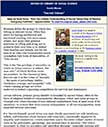
Sacred Values (Scott Atran) (Oct 10, 2016)Humans define the groups to which they belong in abstract terms. Often
they strive for lasting intellectual and emotional bonding with anonymous others, and make their greatest exertions
in killing and dying not to preserve their own lives or to defend their families and friends, but for the sake of an
idea—the transcendent moral conception they form of themselves, of “who we are.”
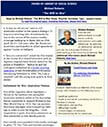
The Will to War (Michael Roberts) (Oct 07, 2016)“It was an adventure,” said an old Australian soldier to the camera
during a TV sequence retelling tales of enlistment for war in the course of the massive media coverage leading up to
Anzac day on 25th Apr 2015—100 years after the disastrous Australian participation in Allied operations against Turkey
at Gallipoli. “Are you a terrorist?” asked the film-maker in the course of a relaxed interview with an Algerian migrant
from Britain netted by the police in Frankfurt—before he and his colleagues embarked on a bomb-planting operation at
the Christkindelsmärik beside Strasbourg Cathedral in 2000. “No, I am a mujahid” said the young man quietly in firm
denial.
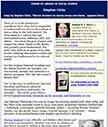
Heroes vs. Merchants (Stephen Hicks on Werner Sombart) (Oct 06, 2016)Those of us in the democratic-republican West
often find it impossible to understand how the world could go to war so often in the 20th century. We were raised in
a culture that had internalized Locke, Jefferson, Mill, and others — for whom the goal of peace and respect for others’
rights to life, liberty, and property were fundamental. We (still) have little-to-no grasp of an alien modern ideology
that makes conflict and waging war fundamental to its cultural health.
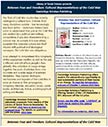
Between Fear and Freedom: Cultural Representations of the Cold War (Oct 04, 2016)The field of Cold War studies has
recently undergone a cultural turn. Scholars from many disciplines outside – but increasingly also from within – diplomatic
history have come to understand that, just as the Cold War was marked by a political and military competition, it was
also characterised by a cultural one. As a result, it is now widely accepted that everyday culture was itself infused
with political and ideological messages. The Cold War was ubiquitous.
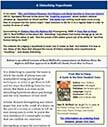
A Disturbing Hypothesis (Oct 04, 2016)Commenting on Nations Have the Right to Kill (Koenigsberg, 2009) in From War
to Peace (2011), Kent Shifferd writes about the “disturbing” hypothesis that human beings go to war to “prove that the
nation is real;” that the power of the nation grows out of its ability to “sacrifice human beings to itself.” The criterion
for judging a hypothesis is never how it makes us feel—but whether it is true or not. Many of the ideas that changed
the course of history originally were experienced as “troubling”—and deeply disturbing.
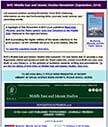
Brill Newsletter: Middle East and Islamic Studies (Oct 03, 2016)LSS presents another exciting Newsletter from Brill—featuring
information on new and forthcoming titles, journals, book reviews, and upcoming events. A highlight of this Newsletter
is Brill's just-published Modernity, Minority, and the Public Sphere: Jews and Christians in the Middle East—featured
to the right and below. Brill is providing the digital edition of this book—identical to the print version—at NO CHARGE
(list price for print edition, $66.00). Brill’s Middle East and Islamic Studies lists comprise 130 new books and 25
journals a year.
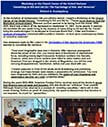
Something to Kill and Die For (Oct 03, 2016)At the invitation of Ambassador DeLuca (photos below), I taught a Workshop
at the Church Center of the United Nations, “Something to Kill and Die for.” Please scroll down to read the Workshop
announcement. Whereas warfare seemed to be fading from the scene, 1992-2000, there was a return of the repressed on
Sep 11, 2001. Some people, it seemed, did not think life was worth living in the absence of some thing to kill
and die for. Could I bring the methodologies I’d developed to illuminate World War I, Hitler and Nazism—analysis of
metaphor contained within political rhetoric—to bear upon contemporary forms of collective violence?
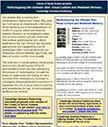
Mythologizing the Vietnam War: Visual Culture and Mediated Memory (Oct 03, 2016)The Vietnam War is evolving from
contemporary memory into history. Fifty years on, it still serves as a benchmark in the history of war reporting and
in the representation of conflict in popular culture and historical memory. However, as contemporary culture tries to
come to terms with the events and their political, psychological and cultural implications, the ‘real’ Vietnam War has
been appropriated and changed into a set of mythologies which implicate American and Vietnamese national identities
specifically, and ideas of modern conflict more broadly.
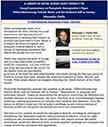
Suicide Music in Nazi Germany (Oct 01, 2016)Music accompanies many of us throughout our lives, scoring our peak
experiences and opening layered dimensions of meaning that connect us in subtle and provocative ways. Music is a catalyst
for states of rapture and transport, a social adhesive, and a means of expressing sentiment that affects the psyche
on every level. Music may capture the spirit of an age, and in some cases evoke powerfully symbolic resonances.
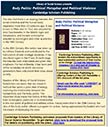
Body Politic: Political Metaphor and Political Violence (Sep 30, 2016)Readers of the Library of Social Science Newsletters
are aware that our research institute has spent a great deal of energy exploring the relationship between the human
body and the body politic. This important study traces the history of this idea from its inception, particular in its
relationship to the real world of political and military action. Harvey notes that in the 20th Century, the idea of
the body politic offered a program for action—being appropriated by leaders who had the means of destroying the state.

Book Publishing Opportunity (Sep 28, 2016)CSP is terrific at promoting their books. They’ve participated in nearly
every LSS book exhibit for the past six years. Please scroll down the page for photos of CSP titles on display at recent
exhibits. What’s more, Library of Social Science will aggressively promote titles developed as a result of this call.
Indeed, we will be happy to work with authors to create multiple promotions that will be distributed to our database
of 35,000 scholars, professionals, publishing executives and students around the world.
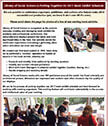
Looking forward to 2017... (Sep 23, 2016)We are grateful to conference organizers, publishers, and authors who helped
make 2016 successful and productive (yes, we know it ain't over till it's over). Please scroll down the page for photos
of a few of our exciting book exhibits. Library of Social Science is recognized as the premier company creating and
managing book exhibits for scholarly and professional conferences. Our comprehensive displays present the latest and
most significant titles in the field. Our exhibits enrich the conference experience—becoming a gathering place where
attendees can meet and mingle.
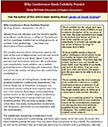
Why Conference Book Exhibits Persist (Sep 23, 2016)Book exhibits are the single best way to see the current state
of affairs in any academic discipline, all in one place at one time. Because publishers are eager to show their new
wares, an hour or two at the exhibit can pay off remarkably. A scholar can quickly get the sense of where the edge of
discourse is in a field. A book exhibit can be a place to gather intelligence about which books are having an impact
and which are attracting attention.
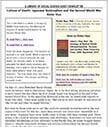
Culture of Death (Japanese Nationalism & the 2nd World War) (Sep 21, 2016)This is the third in a series of essays
by Walter Skya exploring the ideological sources of Japan’s participation in the Second World War. From the book Hagakure:
“The essence of bushidō is to seek death. When a warrior is faced with a choice between life and death, he chooses death.
If, by being prepared for death every morning and evening, one is able to live as though his body were already dead,
one gains freedom.” The true bushi does not think of victory of defeat. “He plunges recklessly towards death”.
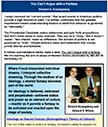
You can't argue with a fantasy (Koenigsberg) (Sep 20, 2016)I rarely comment on “current events.” But recent events
in American politics provide a high theoretical yield. I’ve written continually that the greatest impediment toward
understanding Nazism is belief that behavior is governed by “rationality.” The Presidential Candidate makes statements
and puts forth propositions that don’t make sense to many analysts. They say he is “lying.” But it doesn’t matter: “fact
checks” make no difference. The domain of politics is not governed by “truth.” People embrace ideas and statements that
convey primal desires and fantasies.
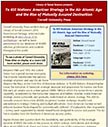
To Kill Nations (Cornell U. Press) (Sep 19, 2016)Cornell University Press exhibits through Library of Social Science’s
2016 Promotional Package, which includes exhibiting at each of our 2016 conferences—as well as book promotions to our
database of 40,000 scholars, professionals and students throughout the world. In To Kill Nations, Edward Kaplan traces
the evolution of American strategic airpower and preparation for nuclear war from this early air-atomic era to a later
period (1950–1965)
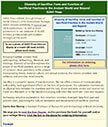
Diversity of Sacrifice (SUNY Press) (Sep 19, 2016)SUNY Press exhibits through Library of Social Science’s 2016 Promotional
Package, which includes exhibiting at each of our 2016 conferences—as well as book promotions to our database of 40,000
scholars, professionals and students throughout the world. Bringing together scholars from anthropology, archaeology,
literature, and theology, Diversity of Sacrifice explores the power of sacrificial practices across a range of contexts—from
prehistory to the present.
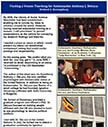
Teaching for Ambassador DeLuca of the UN (Sep 15, 2016)By 2006, the Library of Social Science Newsletter had been
established— enabling me to convey my ideas to scholars around the world. However, having received substantial training
as a lecturer, I still prioritized “in person” presentations as the vehicle for conveying my research findings and theories.
I needed a place or venue at which I could present my ideas—an established institutional setting that could confer prestige
and respectability.

Pathology of First World War (Pathology of Historians) (Sep 14, 2016)The First World War was an extraordinary, profoundly
destructive and pathological event—yet historians fail to discuss the war in these terms, pretending that the mass-murder
and dismemberment of young men is “normal.”Equally extraordinary and pathological are the interpretations of some historians.
One claims that the war persisted—that men fought—because “fighting was fun.”
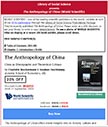
The Anthropology of China (World Scientific) (Sep 14, 2016)WORLD SCIENTIFIC—one of the leading scientific publishers
in the world—exhibits at each of our 2016 conferences through the Library of Social Science Promotional Package. They’ve
recently published The Anthropology of China. Please order at a 20% discount, or ask your library to order a copy (details
below). To see a photo of WORLD SCIENTIFIC titles on display at a recent LSS book exhibit, please scroll down.
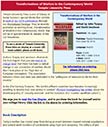
Transformations of Warfare (Temple University Press) (Sep 13, 2016)Temple University Press is one of Library of
Social Science’s special clients that exhibits at each of our 2016 conferences through our Promotional Package. They’ve
recently published an exciting book, Transformation of Warfare in the Contemporary World, that will be of special interest
to readers of the LSS Newsletter. Authors Torpey and Jacobson observe (in the first chapter that you can read at no
charge here) that there has been a radical change in our conception of warfare.

Research on War as Sacrifice (Sep 12, 2016)Library of Social Science is the hub for scholarship on the dynamics
of warfare and its relationship to sacrifice (see the recent article in The New York Times). Our objective is to generate
research and interaction among the most creative and dynamic scholars writing on this topic. We scanned our Ideologies
of War and Book Review websites, selected the best and most relevant writings—and created a new Website, War as Sacrifice.
We have reproduced this website directly below.
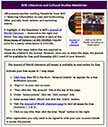
Read at no charge: Journal of World Literature (Brill) (Sep 12, 2016)LSS presents another exciting Newsletter from
Brill — featuring information on new and forthcoming titles, journals, book reviews, and upcoming events. A highlight
of the Newsletter is Brill's Journal of World Literature — featured to the right and below. You may read every article
in each of the three issues of Volume I at NO CHARGE (regular price for a yearly subscription is $153.00).
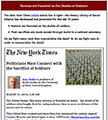
Nations are founded on the deaths of soldiers (New York Times) (Sep 9, 2016)The New York Times article below has
it right—the theory Library of Social Science has developed and promoted for the last 10 years: Nations are founded
on the deaths of soldiers. Their sacrifices are made sacred through burial in a national cemetery. Do we fight wars—and
then memorialize the dead? Or do we fight wars in order to memorialize the dead?
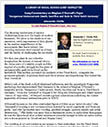
Death, sacrifice & ruin (Essay by Alexander Chirila) (Sep 6, 2016)Hitler’s cult of the dead, volkish ideational
influences, and the apocalyptic Wagnerian mythology that characterized Nazi Germany is the subject of Meghan O’Donnell’s
insightful article, “Dangerous Undercurrent: Death, Sacrifice and Ruin in Third Reich Germany.” From the Totenkult to
Wagner’s Der Ring des Nibelungen and Albert Speer’s “theory of ‘ruin value,’” O’Donnell reveals a potent substratum
underlying the violent pageantry of German nationalism prior to WWII.
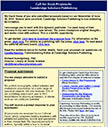
Call for book proposals (Aug 31, 2016)We thank those of you who submitted proposals based on our Newsletter of Jun
30, 2016. Several were excellent. Cambridge Scholars Publishing is now extending its invitation. I encourage you to
work with this dynamic publisher. I’ve used many of their volumes in my own research (see below). The press champions
original thought—and works close with authors. This is a terrific opportunity. To get started, click here to download
the proposal form.
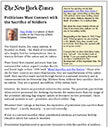
Nations depend on the death of soldiers (Aug 31, 2016)Here is the exciting article that appeared in
The New York Times a few days ago, presenting an idea that LSS authors have been writing about for ten years: Nations
depend on the death of soldiers. It’s a radical idea. But when the mass-media mirrors an idea, it becomes less
radical—on its way to becoming reality. If people find an idea disturbing today, they “opt out”—the modern
form of denial. If you are reading this email, you have contributed to the development of this important idea. We thank
you.
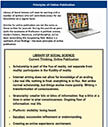
Principles of online publication (Aug 31, 2016)Library of Social Science will soon be working with a number of authors
who will contribute essays for our Newsletter on a regular basis. Articles for online publication are not the same as
those written for journals. During the past three years (with the assistance of Professors in political science, modern
history, literature, and philosophy), we’ve been researching this burgeoning field. Below is a synthesis of our
findings—the basic principles of online publication.
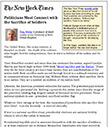
New York Times/Library of Social Science (Aug 29, 2016)The New York Times recently wrote about an idea that Library
of Social Science has been promoting for years: That countries are sustained by the deaths of soldiers: “Without their
sacrifice, there is no nation.” Cultural change occurs when an idea developed by a dedicated group of people drifts
outward: from core to periphery. Everyone receiving the LSS Newsletter is part of this revolution in thought—responsible
for developing this idea. As if by magic, suddenly the idea is no longer radical: the real work begins.
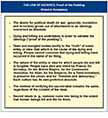
The Law of Sacrifice (Koenigsberg) (Aug 29, 2016)The desire for political death (in war, genocide, revolution and
terrorism) grows out of attachment to an ideology conceived as absolute. Dying and killing are undertaken in order to
validate the ideology (“proof of the pudding”). Dead and mangled bodies testify to the “truth” of some entity or idea:
that which is the cause of the dying and killing. People cannot conceive that dying and killing have occurred in the
name of no thing.
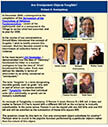
Are omnipotent objects fungible? (Aug 25, 2016)The term “fungible” is a term designating movable goods, such as
grain “any unit or part of which can replace another part.” Fungibility implies that individual units (of a commodity
or good) can be mutually substituted. The question raised by this term is: Can one omnipotent object substitute for
another? Perhaps what is crucial is the psychic function performed by a particular object—rather than the nature of
this object.
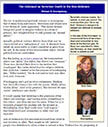
The Holocaust as Terrorism: Death to the Non-Believers (Aug 24, 2016)The ideologies of both Islamic terrorism and
Nazism rest upon absolute faith in an object or entity conceived as all-powerful. Followers are expected to submit unconditionally
to the object that is worshipped. Violence is directed toward human beings who do not share the faith; do not acknowledge
the obligation to submit to the object or entity that is worshipped.
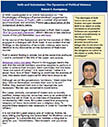
Faith and Submission: The Dynamics of Political Violence (Aug 23, 2016)The ideologies of both Islamic terrorism
and Nazism rest upon absolute faith in an object or entity conceived as all-powerful. Followers are expected to submit
unconditionally to the object that is worshipped. Violence is directed toward human beings who do not share the faith;
do not acknowledge the obligation to submit to the object or entity that is worshipped.
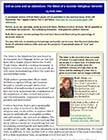
Masochistic Love for the Father (Aug 22, 2016)The terrorists enact a return to the father, refusing the rebellious
“killing” of tyrannical authority. By this capitulation, the terrorist becomes the instrument of the father’s
authority. This process of constructing a father into an all-devouring entity, by transforming self-hate and fear into
masochistic love, is done within the framework of a whole group.

Evil as love and as liberation (Aug 22, 2016)A condensed version of Ruth Stein's paper will be published in the
next two issues of the LSS Newsletter. Part I appears below. Part II will follow. Click here for the complete paper
with references. Politics, as we can see today, exists as a kind of chaos. Warfare is a form of chaos. Yet it's possible
to understand the dynamics—the underlying templates—that generate political violence. Ruth Stein's paper remains perhaps
the most lucid document illuminating the psychology of terroristic violence.
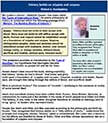
History builds on cripples and corpses (Aug 19, 2016)Stalin, Hitler and Mao operated according to Azzam’s
philosophy. They recognized that “history” (that which is remembered) builds on slaughter—a “lofty
edifice of skulls.” The terror Bin Laden created is dwarfed by the efforts of Stalin, Hitler and Mao—whose reputations
rest on a foundation of cripples and corpses.
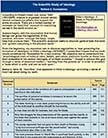
The Scientific Study of Ideology (Aug 18, 2016) From the beginning, my aspiration was to discover regularities or
laws governing the formation of ideologies. In Hitler’s Ideology (1975/2007), I stated that I hoped that my book would
constitute the “foundation for a new science.” My objective was to understand the “psychological roots of cultural ideas,
beliefs, and values, particular insofar as these have been embodied in the central ideologies of civilized societies.”
I hoped to achieve this goal through a series of empirical studies—“working from the ground up” in order to establish
a “base which is solid, and can be built upon.”
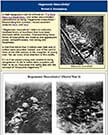
Hegemonic Masculinity? (Aug 17, 2016) “Hegemonic masculinity” refers to culturally idealized forms of
manhood that have been dominant within societies. Characterizing these forms of masculinity are violence and aggression,
power, competitiveness, risk taking and toughness. In the First World War, 9 million men died and 21 million were wounded.
Indeed, one of the central facts of the 20th century is the slaughter of young men. Yet, we rarely draw attention to
this reality. It’s as if we expect young men accede to being slaughtered: to die in battle when societies ask them to
do so. How does this reality jibe with the concept of “masculine hegemony”?
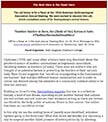
The Best Hero is the Dead Hero (Aug 16, 2016) You are invited to pull this fantasy apart in an effort to examine
the potentialities for, using Koenigsberg’s terms, “awakening from the nightmare of history.” In other
words, what can be potentially revealed when we understand how the fantasy operates? Are there ways, spaces, and potentialities
for a collective knowing and abandoning of this collective bad dream? What is the body politic of the nation onto which
we are mapping our individual human bodies, sacrificing those of soldiers?
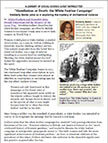
Humiliation or Death (Aug 15, 2016)In “White Feathers and Wounded Men: Female Patriotism and the Memory of the Great
War,” Nicoletta Gullace describes the white feather campaign, an effort by British women to encourage young men to serve
their country in World War I. Women would place a white feather, a symbol of cowardice, on a man in civilian clothing
to humiliate him for shirking military service. This symbol originated from the belief that a white tail feather was
a sign of inferior breeding in a rooster bred for cockfighting. Showing the white feather meant the bird lacked the
aggression necessary to succeed in the sport.
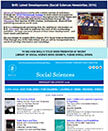
Keeping up with Brill (Aug 15, 2016)Library of Social Science works with a select number of publishers through our
2016 Promotional Package to both exhibit and publicize their titles at cutting-edge conferences throughout the United
States and Canada—and to promote their books and journals through the LSS Newsletter that reaches 40,000 scholars, professionals,
students and publishing executives world-wide.
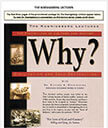
"The Koenigsberg Lectures" (Aug 2, 2016)The title of the package is WHY? There is a tendency for historians—and
others—to “take for granted” the extraordinary political events that characterized the 20th century. By posing the question
“Why,” I’m bracketing these events, taking them out of the realm of the self-evident. Just because a certain form of
behavior occurs with great frequency throughout history, doesn’t mean that we understand it. Actually, we don’t understand
what war is—even though we imagine we do.
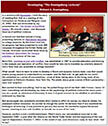
Development of "The Koenigsberg Lectures" (Aug 1, 2016)In a previous LSS Newsletter, I told the story
of meeting Bob Hall at a meeting of the Colloquium on Violence and Religion (Jun 22, 2002). Bob was stimulated by my
presentation on “The Soldier as Sacrificial Victim.” We shared a pizza—and discussed theories of political violence.
In turned out that Bob earned a living presenting lectures on Nonviolent Sexuality to college students. By the time
I met him, his program had been presented to over 800 campuses throughout the United States and Canada. He’d been nominated
three times by the National Association for Campus activities—as lecturer of the year.
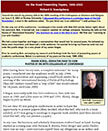
On the road, 1988-1992 (Aug 1, 2016)Toward the end of my plenary talk at the 2002 meeting of the Colloquium on Violence
and Religion on Jun 5-8, 2002 at Purdue University (I discussed this conference in a previous issue of the LSS Newsletter),
a man in the audience asked, “Do you think war is an addiction?” I said perhaps it is. On the way out of the auditorium,
I exchanged a few words with Bob Hall (photo below right) about his comment. Bob, it turned out, was a popular speaker
on college campuses, focusing his talks on the theme of “Nonviolent Sexuality” (the brochure he used at the time is
here). His firm was “Learning to Live with Conflict.”
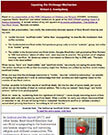
Exposing the Victimage Mechanism (Jul 29, 2016)War as a unifier of works best when people are able to avert their
eyes from the sight of the victims; when we don’t have to look closely at what happens to the bodies of soldiers. People
enjoy the idea of war, but would prefer to participate at a distance. Sight of a soldier’s maimed body drains warfare
of its glory. The son of Douglas Haig, British Commander-in-Chief responsible for the disastrous Battle of the Somme,
reports that the General "felt that it was his duty to refrain from visiting the casualty stations because these
visits made him physically ill."
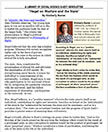
Hegel on Warfare and the State (Jul 28, 2016)According to Hegel, war is a “positive moment” wherein the state asserts
itself as an individual, establishing its rights and interests. Sacrifice on behalf of the ‘individuality’ of the state
is the “substantial tie between the state and its members—and so is a universal duty.” Hegel alludes to Kant’s when
he writes that, “Just as the blowing of the winds preserves the sea from the foulness which would be the result of a
prolonged calm, so also corruption in nations would be the product of prolonged, let alone ‘perpetual’ peace.” Warfare
constitutes a form of purification.
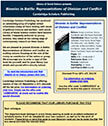
Binaries in Battle (Cambridge Scholars Publishing) (Jul 28, 2016)Cambridge Scholars Publishing has produced an astonishing
array of original edited collections—many of them dealing with issues of political violence and warfare—with which Library
of Social Science readers have become familiar. Frequently authored by young scholars, they stand at the cutting edge
of contemporary research on these topics. We are pleased to present Binaries in Battle: Representations of Division
and Conflict, an exciting volume focusing on the role of the enemy as constitutive of the nation or group. We encourage
you to order a copy of this book for yourself, and for your library (see details and special offers directly below).
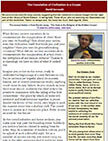
The foundation of civilization is a corpse (Jul 27, 2016)Don't be blinded by our modern sensibilities. These gods
still exist. They're called Germany, France, United States, Japan, and so on: nation-states. And we've devised myths
to justify feeding them more sacrificial victims. Our greatest vestige of sacrifice—our need to feed our collective
bodies with the shed blood of one of our own—is the warfare state. Richard Koenigsberg has been helpful in collecting
the sentiments of moderns celebrating the sacred necessity of war for national preservation.
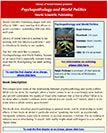
Presenting "Psychopathology and World Politics" (World Scientific Publishing) (Jul 26, 2016)World Scientific
Publishing began with one office in 1981—and now has 450 offices in seven countries—publishing 600 new titles each year.
Library of Social Science is excited to be working with this fabulous publisher—and to introduce its books to our readers.
The first title we’d like to present, Psychopathology and World Politics, focuses on an issue that is especially relevant
today (one that Dr. Koenigsberg has been writing about).
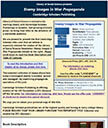
Presenting "Enemy Images in War Propaganda" (Cambridge Scholars Publishing) (Jul 26, 2016)Library of Social
Science is excited to be working closely with Cambridge Scholars Publishing—a dynamic, fast-growing scholarly press—to
bring their titles to the attention of a worldwide audience. We are pleased to present the first Cambridge Scholars
title—one that we believe is especially relevant for readers of the Library of Social Science Newsletter: Enemy Images
in War Propaganda (details to the right). Please scroll down to read the Book Description and Table of Contents.
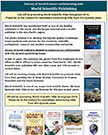
LSS collaborating with World Scientific Publishing (Jul 26, 2016)World Scientific has established itself as one
of the leading publishers in the world, and the largest international scientific publisher in the Asia-Pacific region.
The press’s mission is to develop the highest quality knowledge-based products and services for the academic, scientific,
professional, research and student communities worldwide. Library of Social Science is pleased to announce our collaboration
with this dynamic publishing house.
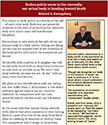
Bodies politic seem to live eternally (Jul 25, 2016)Inherent within attachment to a body politic is the aspiration
to fuse with a body that seems to go on eternally. On the other hand, one’s actual body is the place where death occurs.
Though we recognize our body as the location of death, we seek to embrace it. It is the place where sexual excitement
and physical pleasure occurs—not to mention love. The experience of existence inspires us to abandon identification
with “omnipotent” bodies politic.
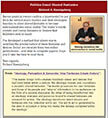
Politics enact shared fantasies (Jul 22, 2016)Recent political events confirm a hypothesis I’ve put forth for several
years: leaders and their ideologies function to allow shared fantasies to become externalized into social reality. The
leader's words contain and convey fantasies or desires that followers seek to enact. I’ve developed a method that allows
one to ascertain the precise nature of these fantasies and desires. Below are excerpts from two online publications—and
links to complete papers. Hope you’ll take the time to read them.
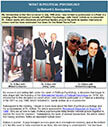
What is Political Psychology? (Jul 22, 2016)My introduction to this field occurred in Jul 1988 when I was invited
to participated in a Panel at a meeting of the International Society of Political Psychology—with Vamik Volkan as co-presenter.
Dr. Volkan works with diplomats and political leaders around the world to resolve international crises—and has been
nominated four times for the Nobel Peace Prize.
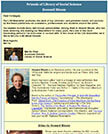
Howard Bloom (Friend of Library of Social Science) (Jul 20, 2016)Our LSS Newsletter publishes the work of top scholars—and
promotes books and journals by the finest publishers—to academics, professionals and students around the world. Our
readers include many well-known personalities. Among them is Howard Bloom, who has been receiving and reading our Newsletters
for many years. He’s one of the most fascinating persons I’ve ever come in contact with. In this issue of the LSS Newsletter,
we’d like to tell you a bit about Howard.
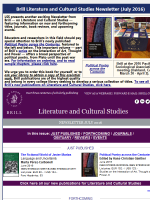
Brill Literature and Cultural Studies Newsletter (Jul 2016) (Jul 18, 2016)LSS presents another exciting Newsletter
from Brill — on Literature and Cultural Studies — featuring information on new and forthcoming titles, journals, book
reviews, and upcoming events. Educators and researchers in this field should pay special attention to Brill's newly
published Political Poetry across the Centuries, featured to the left and below. This important volume — part of Brill's
series on the Interaction of Art, Thought and Power — offers a broad perspective of political poetry, from Plato until
the post-war era.
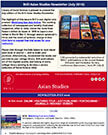
Brill Asian Studies Newsletter (Jul 16, 2016)Library of Social Science is pleased to present the Jul edition of
the Brill Asian Studies Newsletter. The highlight of this issue is Brill's new digital-only product: Mobilizing East
Asia Online. This exciting collection of newspapers and lavishly illustrated magazines, often in color, shows the route
from Russia's defeat by Japan in 1905 to Japan’s own defeat in World War II, through seismic upheaval in China and the
onset of systemic change in Asia. Click here to request free trial access for your institution.
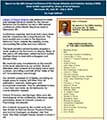
Human Behavior & Evolution Society Book Exhibit: report, with photos (Jul 15, 2016)Library of Social Science was
pleased to create and manage the book exhibit for the Human Behavior and Evolution Society’s 28th annual conference
at the Westin Bayshore hotel in Vancouver, BC. Conference organizer and local host Laura Dane and her volunteers did
a magnificent job. The book exhibit was located in the Bayshore Ballroom Foyer, outside the meeting rooms, surrounding
the coffee and food stations. The book exhibit's central location ensured a ready audience for the books on display.
Many of this year's 600 attendees visited the book exhibit multiple times to meet with colleagues and discuss titles.
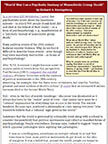
World War I as a Psychotic Fantasy of Masochistic Group Death (Jul 14, 2016)Suicidal terrorism opened a vast can
of worms. For if we can conceive of suicide bombings as irrational, self-destructive and pathological—what about the
major political events of the 20th century—that were characterized by massive destruction and self-destruction? What
about World War I when nations asked young men—for four years—to get out of trenches and to run into machine-gun fire?
Why do we hesitate to characterize the behavior of nations, leaders and soldiers in the First World War as suicidal
and pathological? Why do people have no problem saying that what occurred at Jonestown represented a “psychotic fantasy
of group death”—yet hesitate to describe the First World War in these terms?
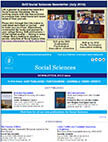
Brill Social Sciences Newsletter (Jul 2016) (Jul 14, 2016)LSS is pleased to present the latest Brill Social Sciences
Newsletter. We’re working closely with this fine publisher to promote their latest books and recent issues of their
journals. Please click through the links below to read about each book or journal — and to make your purchase. Alternatively,
recommend the books and journals to your college library. Brill publications — of the highest quality — belong in every
college library seeking to develop a serious collection of Social Science titles. For more information on Brill, click
here.
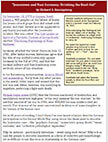
Jonestown and Nazi Germany: Drinking the Kool-Aid (Jul 13, 2016)Joseph Goebbels delivered his most famous speech
at the Sportpalast before a packed crowd on February 18, 1943. Acknowledging that Stalingrad had been an “alarm call
of destiny,” he incited the audience to a high pitch of excitement, challenging Germans to carry on. He asked the hysterical
crowd whether they believed in their Fuehrer and total victory. An ear-splitting “Ja!”—“Yes!”—was the reply. Goebbels
screamed, “Do you want total war? Do you want it more total and more radical than we could ever imagine today?” Whereupon
pandemonium broke out. “Now, Volk,” Goebbels screamed, “arise and storm, break loose.” Goebbels had asked the German
people to drink the Kool-Aid, and they did.
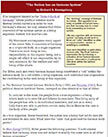
The Nation has an Immune System (Jul 12, 2016)The “thrilling” message of National Socialism—that appealed to so
many scientists and physicians—was that Germany was an actual body possessing an immune system. Like any organism with
an immune system, Germany would work to ferret out “cells” identified as alien or non-productive—unable or unwilling
to contribute. Jews were identified as particularly virulent cells. The Final Solution represented the functioning or
activation of the German immune system—elimination of pathogenic cells from within the German organism.
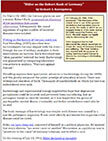
Hitler as the Robert Koch of Germany (Jul 11, 2016)On February 22, 1942, Hitler explained: “The discovery
of the Jewish virus is one of the greatest revolutions that has taken place in the world. The battle in which we are
engaged today is of the same sort as the battle waged by Pasteur and Koch. We shall regain our health only be eliminating
the Jew.” Hitler imagined that he had discovered the Jewish bacterium (or virus): the cause of Germany disease
and suffering. The Final Solution was enacted with the purpose of curing Germany’s (and Europe’s) disease
by removing or eliminating its cause.
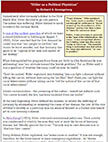
Hitler as a Political Physician (Jul 11, 2016)“Every distress,” Hitler explained, has “some cause or another.” It
was not enough for politicians to “doctor around on the circumference of the distress,” and try from time to time to
“lance the cancerous ulcer.” Rather, it was necessary to penetrate to the “seat of the inflammation—the cause.” It was
unimportant whether the irritating cause was discovered “today or tomorrow.” The essential thing to understand was that
unless the cause was addressed, “no cure is possible.”
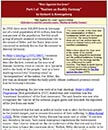
The Gas Chambers (Conclusion of "Nazism as Bodily Fantasy") (Jul 5, 2016)“Jews symbolized the wish to lead
one's own life, apart from the community. What was annihilated when the Jew was annihilated was the Nazi's split off
desire to be free of the society that had dominated his existence. Terrified by his desire to separate from Germany,
Hitler felt compelled to ‘kill off’ this wish.”
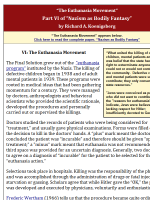
The Euthanasia Movement (Genocide as Bodily Fantasy) (Jul 5, 2016)“What united the killing of defective children,
mental patients and Jews was belief that the state had the right to exterminate anyone who could not or would not contribute
to the community. Defective children and mental patients were unable to contribute; they only consumed state resources.
Jews were conceived as people who
did not want to contribute. As the "reasons for euthanasia" indicate, Jews were believed to be lacking
respect for Hitler; insufficiently devoted to Germany."
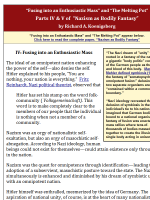
Fusing into an enthusiastic mass (Nazism as Bodily Fantasy) (Jul 5, 2016)“The Nazi dream of "unity" was
rooted in a fantasy of the nation as a gigantic "body politic" consisting of the German people as the flesh
and blood of this body. Margaret Mahler defined symbiosis (1969) as the fantasy of "somatopsychic omnipotent fusion:"
delusion that two separate organisms are “contained within a common boundary. Nazi ideology recreated the delusion of
symbiosis in the individual's tie to his nation.
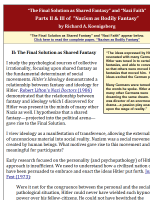
The Final Solution as shared fantasy (Jul 2, 2016)“The ideas expressed by Hitler resonated with many Germans.
Hitler was tuned in to certain fantasies, and able to convey these so that others were moved by the fantasies that moved
him. Hitler's ideas excited the German people. Many Germans were turned on by the words he spoke. Hitler and many other
Germans were dreaming the same dream. Hitler was director of an enormous drama—a passion play enacted upon the stage
of reality.”

War against the Jews (Nazism as bodily fantasy) (Jul 1, 2016)In 1933 there were 550,000 Jews in Germany out of a
total population of 66 million, less than one percent of the population. Yet this small group of people assumed a tremendous
role in the minds of Hitler and the Nazis. Jews were conceived to embody forces that threatened to destroy Germany.
In Hitler's Ideology (1975/2007), I examine metaphors and images used by Hitler to describe the Jew, viewed as the source
of disease, bacteria, virus or cancer; as a "parasite within the body of the people;" and as a force working
toward the "disintegration" or "decomposition" of the nation.
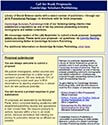
Call for book proposals (Jun 30, 2016)We are pleased to announce that Library of Social Science is providing its
readers with the opportunity to publish with—submit proposals to—some of the world’s top scholarly presses. The call-for-proposal
below is from one our fastest growing clients—Cambridge Scholars Publishing—that has established a reputation as one
of the top presses presenting scholarly monographs and edited collections. We’ve found Cambridge Scholars Publishing
to be wonderful to work with. The press champions original thought—putting authors at the heart of everything they do.
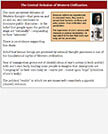
The central delusion of Western civilization (Jun 27, 2016)The most persistent delusion of Western thought—that
goes on and on and on, and continues to dominate public discourse—is the belief that people upon the political stage
act “rationally”—responding to their “interests.” There is no evidence supporting this claim.
Belief that human beings are governed by rational thought processes is one of the foundational myths of Western civilization.
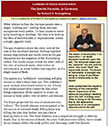
The Jewish parasite...is Germany (Jun 21, 2016)The dream of immortality=no separation=no death becomes symbiotic
upon the self. The immortal object and the “parasite” are one and the same. One must “feed”
the impossible dream. The dream of immortality is brought into being by virtue of sacrifices made in relationship to
the object. Jews symbolized the negative meaning of the omnipotent object: experience of the object as parasitical—feeding
upon the self. In killing Jews, Hitler is trying to kill Germany, that is, the destructive experience of an omnipotent
object bound to the self.
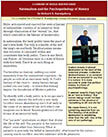
Nationalism & the psychopathology of history (Jun 20, 2016)Nazism reveals irrational destruction at the heart
of the historical process. Collective destructiveness is so common that we are tempted to say that it is normal. It
is more accurate to state that political history is a form of psychopathology. It seemed recently there might be an
“end to history.” But human beings could not bear existence in the absence of “something to kill and die for.” We create
history. It is not something separate from us. This fantasy—that political destruction is something other than the self—lies
at the core of our pathology.

New book on Malcolm X (BRILL) (Jun 16, 2016)New book on Malcolm X (BRILL) Malcolm X: From Political Eschatology
to Religious Revolutionary (New title from BRILL) Dustin J. Byrd and Seyed Javad Miri (Eds.) Brill at the 2016 Southwestern
Psychological Association Annual Convention To read more about BRILL, click here. Library of Social Science works with
our publish
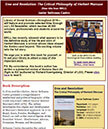
Definitive book on Herbert Marcuse (BRILL) (Jun 15, 2016)Library of Social Science—throughout 2016—will feature
and promote selected titles through our LSS Newsletter, which reaches 40,000 scholars, professionals and students around
the world. BRILL has recently released what appears to be the definitive study of the life and work of Herbert Marcuse,
a scholar whose ideas shaped the Sixties—and beyond. This exciting volume tells the full story. We urge you to order
this book for yourself, or to ask your library to obtain a copy of this important work.
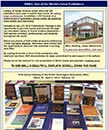
Brill: one of the world's great publishers (Jun 14, 2016)Library of Social Science works with over 250 publishers
each year to exhibit their books at cutting-edge conferences. In addition, LSS focuses on a select group of publishers
whose books we publicize more widely and intensively. Included in the LSS 2016 Promotional Package is the opportunity
to promote books and journals through our renowned Library of Social Science Newsletter—that reaches scholars, professionals
and students throughout the world. Below are photos of Brill’s titles at recent conferences—their full-table displays.
Attendees were thrilled with the opportunity to discover this publisher’s exciting new titles.
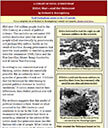
Hitler, War—and the Holocaust (Jun 13, 2016)Hitler created the Holocaust based on his understanding of warfare as
the occasion when nations sacrifice their soldiers. "If I don't mind sending the pick of the German people into the
hell of war without the slightest regret for the spilling of precious German blood,” he declared, “then
I naturally also have the right to eliminate millions of an inferior race that breeds like vermin." The Holocaust grew
out of Hitler’s insight into the meaning of warfare. If he as a national leader had the right to order German
soldiers to die, he reasoned, why did he not also have the right to require Jews—mortal enemies of the German people—to
die?
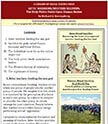
Aztec Warriors/Western Soldiers (Jun 9, 2016) The First World War was undertaken and perpetuated under the assumption
that the “lives” of nations were more significant than the lives of human beings. Germany, France and Great
Britain were fed with the bodies and blood of soldiers—sacrificial victims—in order to keep these entities alive. “The
individual must die so that the nation might live” is a phrase that has been uttered throughout the history of
warfare. What does this mean? The First World War represented an enactment of this proposition: the nation was imagined
to come alive insofar as individuals died—was fed with the bodies and blood of sacrificed soldiers.
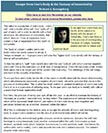
Escape from one's body & the fantasy of immortality (Jun 3, 2016) To escape from one’s body into the life
of the nation is identification with the dream of immortality, which simultaneously represents a negation of one’s
body: refusal to perceive that one is in the process of disintegration. This is what the death instinct is: gradual
breakdown of one’s own body. Each of us is in a process of withering away. To escape one’s own body is to
identify with culture: a realm that forever replenishes itself.
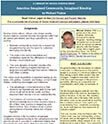
America: Imagined Community, Imagined Kinship (Michael Vlahos) (Jun 2, 2016)Imagined kinship is the foundation of
national community. Imagined kinship is the cultural process that permits people in a society to collectively believe
that they belong to each other—that they are part of the same kinship construct—even though they are most likely strangers
to each other. Imagined community also makes the state the trusted manager of this process—powerfully affirming our
connection and commitment to each other, for example, in war—so that the collective kinship construct is essential to
the very idea of a modern nation state.
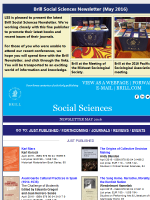
Brill Social Sciences Newsletter (May 27, 2016)LSS is pleased to present the latest Brill Social Sciences Newsletter.
We’re working closely with this fine publisher to promote their latest books and recent issues of their journals. For
those of you who were unable to attend our recent conferences, we hope you will spend time with the Brill Newsletter,
and click through the links. You will be transported to an exciting world of information and knowledge.
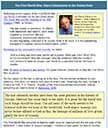
Abject submission to the nation-state (May 23, 2016)"The last sixteenth months have been the most glorious
in the history of Europe. Heroism has come back to the earth. It is good for the world that such things should be done.
The old heart of the earth needed to be warmed with the red wine of the battlefield. Such Aug homage was never before
offered to God as this, the homage of millions of lives given gladly for love of country."
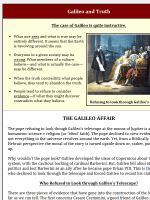
Galileo and Truth (May 12, 2016)Galileo and Truth Galileo and Truth The case of Galileo is quite instructive. •
What one sees and what is true may be entirely different. It seems that the Earth is revolving around the sun. Refusing
to look through Galileo's telescope • Everyone in a given society may be wrong. What members of a culture believe—and
what is actually the case—may be different. • When the truth contradicts what people believe, they tend to a
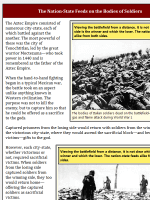
The Nation-State Feeds on the Bodies of Soldiers (May 12, 2016) Viewing the battlefield from a distance, it is not
clear which side is the winner and which the loser. The nation-state feeds alike from both sides. The bodies of Italian
soldiers dead on the battlefield—victims of a gas and flame attack during World War I. The Aztec Empire consisted of
numerous city-state, each of which battled against the another.
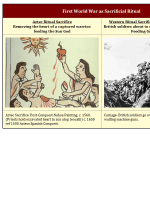
First World War as Sacrificial Ritual (May 10, 2016)First World War as Sacrificial Ritual Aztec Ritual Sacrifice
Removing the heart of a captured warrior: feeding the Sun God Western Ritual Sacrifice: Battle of the Somme British
soldiers about to run into machine gun fire: Feeding Great Britain Aztec Sacrifice. Post-Conquest Nahua Painting, c.
1560. (Priests hold excavated heart to sun atop teocalli) c. 1650 ref 1500 Aztecs Spanish Conquest. Carnage: British
soldiers go over the top towards the waiting machine guns
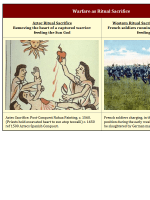
Warfare as ritual sacrifice (May 10, 2016)Warfare as Ritual Sacrifice Aztec Ritual Sacrifice Removing the heart
of a captured warrior: feeding the Sun God Western Ritual Sacrifice, First World War French soldiers running into machine
gun fire: feeding France Aztec Sacrifice. Post-Conquest Nahua Painting, c. 1560. (Priests hold excavated heart to sun
atop teocalli) c. 1650 ref 1500 Aztecs Spanish Conquest. French soldiers charging, in the open, toward a German position
during the early weeks of WWI.
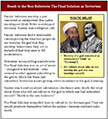
Death to the Non-Believers: The Final Solution as Terrorism (May 03, 2016)Fanatic believers worship a god, conceived
as omnipotent. Bin Laden worshipped Allah. Hitler worshipped Germany. Nazism was a religious cult. Fanatic believers
find it intolerable contemplating the idea that people do not worship the god that they worship. Sometimes, they are
so disturbed that they seek to
kill nonbelievers.

Writers: Reach a wider audience by attending the Paris Writers Workshop (May 02, 2016)Wendy Goldman Rohm (Margaret@RohmLiterary.com)
heads the Rohm Literary Agency and is a NY Times best-selling author. Writers worldwide join her each year to participate
in her acclaimed Paris Writers Retreat (scroll to the bottom of the page for a photo)—to help you develop a work in
progress—or start new work. Wendy is a fan of LSS and is providing a 10% discount to LSS authors and readers who wish
to participate in this exciting opportunity.
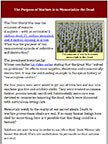
Warfare exists to memorialize the dead (Apr 28, 2016)The First World War was the occasion of massive slaughter—with
an estimated 9 million dead, 21 million wounded, and 8 million missing in action. What was the purpose of this monumental
episode of collective self-destruction? The prominent historian Jay Winter concludes his video series stating that the
Great War “solved no problems.” Its effects were negative, disastrous and economically destructive. It was the outstanding
example in European history of “meaningless conflict.”
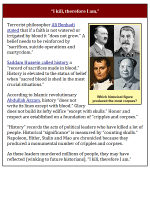
"I kill, therefore I am" (Apr 27, 2016)“I kill, therefore I am.” “I kill, therefore I am.”
Which historical figure produced the most corpses? Terrorist philosopher Ali Benhadj stated that if a faith is not watered
or irrigated by blood it “does not grow.” A belief needs to be reinforced by “sacrifices, suicide
operations and martyrdom.” Saddam Hussein called history a “record of sacrifices made in blood.” History
is elevated to the st
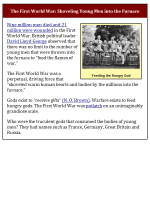
Shoveling men into the furnace of war (Apr 27, 2016)Nations are experienced as bodies The First World War: Shoveling
Young Men into the Furnace Feeding the Hungry God Nine million men died and 21 million were wounded in the First World
War. British political leader David Lloyd George observed that there was no limit to the number of young men that were
thrown into the furnace to “feed the flames of war.” The First World War was a perpetual, driving force
that “s
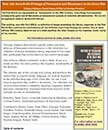
Writings on the First World War (new title from BRILL) (Apr 25, 2016)The First World war represented an “Introduction
to the 20th Century.” Everything that happened subsequently grew out of this event—a monumental episode of collective
self-destruction. We are still struggling to come to terms with this war. This exciting, new title from BRILL—a collection
of essays examining the literary responses to the First World War—reflects the confrontation of two different ways of
portraying the conflict. One of these reflects 19th century ideals of war as a noble sacrifice; the other focuses on
the hopeless, brutal reality of the trenches.
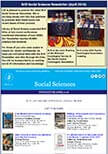
Brill Social Sciences Newsletter (Apr 2016) (Apr 25, 2016)Brill Social Sciences Newsletter (Apr 2016) Brill
at the Joint Meeting of the Midwest Sociological Sociaty & the North Central Sociological Association. Brill at
the 2016 Pacific Sociological Association meeting. LSS is pleased to present the latest Brill Social Sciences Newsletter.
We’re working closely with this fine publisher to promote their latest
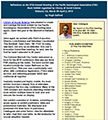
Book Exhibit of the Pacific Sociological Association—report with photos (Apr 15, 2016) Library of Social Science
was pleased to create and manage the book exhibit for the Pacific Sociological Association (PSA) meeting once again—back
this year at the Marriott in Oakland, CA. Once again we worked with PSA’s Executive Director Lora Bristow and Volunteer
Coordinator Tina Burdsall. Dean Dorn, “Mr. PSA” to many, was back, but only as an attendee: this year’s Executive Committee
meeting, he said, was the first he hadn’t attended in 26 years!
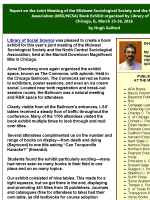
Report on MSS/NCSA book exhibit—with photos (Apr 13, 2016)Report on the Joint Meeting of the Midwest Sociological
Society and the North Central Sociological Association (MSS/NCSA) Book Exhibit organized by Library of Social Science
Chicago, IL, March 23-26, 2016 by Hugh Galford Dear Colleague, My report on the MSS/NCSA meeting is to your left. TO
VIEW PHOTOS, PLEASE SCROLL DOWN.
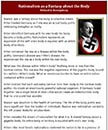
Nationalism as a Fantasy about the Body (Apr 11, 2016)Nazism was a fantasy about the body: a collective dream. Hitler
treated Germany as if she was an actual body politic, embracing metaphor as reality. Hitler identified Germany with
his own body: his body became a body politic. Nationalism represents an expansion of the self: one’s body is equated
with an entire body of territory.
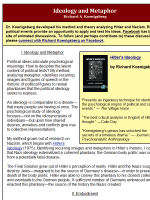
Ideology and metaphor (Apr 07, 2016)Dr. Koenigsberg developed his method and theory analyzing Hitler and Nazism.
Recent political events provide an opportunity to apply and test his ideas. Facebook has been the site of animated discussions.
To follow (and perhaps contribute to) these discussions, please connect with Richard Koenigsberg on Facebook.
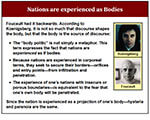
Nations are experienced as bodies (Apr 04, 2016) Foucault had it backwards. According to Koenigsberg, it is not
so much that discourse shapes the body, but that the body is the source of discourse: The “body politic”
is not simply a metaphor. This term expresses the fact that nations are experienced as if bodies.
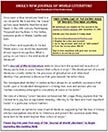
"Journal of World Literature"—Free download! (Mar 25, 2016)Brill’s Journal of World Literature seeks to document
the spread and reception of literary works that circulate “beyond their culture of origin.” The development of a world
literature—closely related to the processes of globalization and networked identity—has generated a discourse that goes
beyond the nation state.
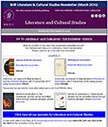
Brill Literature and Cultural Studies Newsletter (Mar 25, 2016)All of Brill’s books are published simultaneously
in print and electronic formats. Libraries can order individual ebooks from the platform, please go to booksandjournals.brillonline.com/help#titleselect
for more information. Brill also offers Brill EBook Collections and Brill Patron Select (PDA) options. Please contact
our Sales department
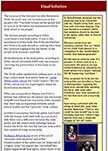
Final Solution (Mar 23, 2016)Final Solution Dr. Rudolf Ramm declared that the physician was to be concerned with
the “health of the Volk” more than with individual disease. This was Nazism in a nutshell: belief that existence
should be devoted to the nation rather than to lives of individuals. Whereas human lives are transitory, nations “live
on.” What do our trivial lives amount to in comparison to the “world historic events” that nations
generate? Nazism was
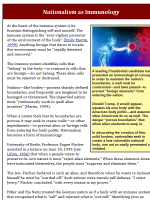
Nationalism as Immunology (Mar 22, 2016)A leading Presidential candidate has presented an immunological concept.
In order to maintain the nation’s boundaries, a wall must be constructed—and laws passed—to prevent “foreign
elements” from entering the nation. Donald Trump equates his own body with the American body politic—and assumes
other Americans do so as well. The danger is that “porous boundaries” will allo
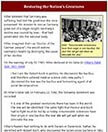
Restoring the Nation's Greatness (Mar 22, 2016)Immigrants Invading the Body Restoring the Nation’s Greatness
Hitler: “Innumerable sicknesses have their origin in one bacillus: the Jew! We will get well when we eliminate
the Jew.” Hitler believed that Germany was suffering; had lost the greatness she once possessed. His mission to
rescue Germany grew out of a single insight: Germany’s decline was caused by Jews—that had penetrated into
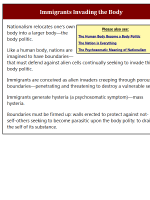
Immigrants invading the body (Mar 21, 2016)Immigrants Invading the Body Immigrants Invading the Body Please also
see: The Human Body Become a Body Politic The Nation is Everything The Psychosomatic Meaning of Nationalism Nationalism
relocates one’s own body into a larger body—the body politic. Like a human body, nations are imagined to have
boundaries—that must defend against alien cells continually seeking to invade this body politic. Immigrants are conceived
as
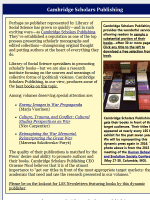
Cambridge Scholars Publishing (free downloads) (Mar 21, 2016)Cambridge Scholars Publishing provides the wonderful
service of allowing readers to sample a substantial portion of their books—often 30 or more pages. Click any title to
the left to download a free selection from the book. Cambridge Scholars Publishing gets their books in front
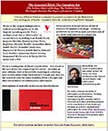
The Essential Žižek (Verso) (Mar 18, 2016)The Essential Žižek The Essential Žižek: The Complete Set (The Sublime
Object of Ideology, The Ticklish Subject, The Fragile Absolute, The Plague of Fantasies: 4 books) Library of Social
Science is pleased to present to readers of our Newsletter this exciting set of books—essential texts for understanding
Žižek’s thought. Verso is the largest independent, radical publishing house in the English speaking world. Their
authors re
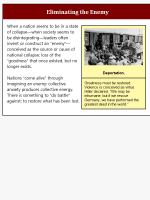
Eliminating the Enemy (Mar 17, 2016)Eliminating the Enemy Eliminating the Enemy Deportation. Greatness must be restored.
Violence is conceived as virtue. Hitler declared, “We may be inhumane, but if we rescue Germany, we have performed
the greatest deed in the world.” When a nation seems to be in a state of collapse—when society seems to be disintegrating—leaders
often invent or construct an “enemy”— conceived as the source or cause of natio
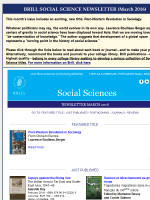
Post-Western Revolution in Sociology (Brill) (Mar 14, 2016)BRILL SOCIAL SCIENCE NEWSLETTER (March 2016) This month's
issue includes an exciting, new title: Post-Western Revolution in Sociology. Whatever politicians may say, the world
evolves in its own way. Laurence Roulleau-Berger argues that centers of gravity in social science have been displaced
toward Asia; that we are moving toward a "de-westernization of knowledge." The author suggests that development of a
glob
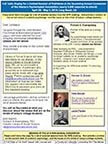
The current state of psychology (WPA book exhibit) (Mar 09, 2016)I've gone through the 2016 Western Psychological
Association program (193 pages) and have selected the most intriguing, provocative presentations (please see list below).
They provide a window on the current state of psychology. Library of Social Science will have nine tables for our display—in
the classic Library of Social Science style. We can accommodate a limited number of publishers who would like us to
represent your press and its books with a full-table display.
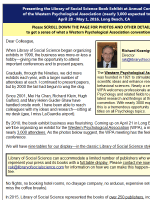
Western Psychological Assocation—LSS Book Exhibit (Mar 08, 2016)Presenting the Library of Social Science Book Exhibit
at Annual Convention of the Western Psychological Association (nearly 3,000 expected to attend) Apr 28 - May 1, 2016,
Long Beach, CA Please SCROLL DOWN THE PAGE FOR PHOTOS AND OTHER DETAILS— to get a sense of what a Western Psychological
Association convention is like. Richard Koenigsberg, PhD Director rak@libraryofsocialscience.com The Western Psychological
Association (WPA) was founded i
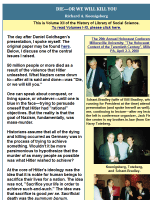
Die—or we will kill you (Mar 08, 2016)DIE—OR WE WILL KILL YOU Richard A. Koenigsberg This is Volume XII of the History
of Library of Social Science. To read Volumes I-XI, please click here. The 20th Annual Holocaust Conference at Millersville
University: "The Holocaust in the Context of the Twentieth Century", Millersville, PA, Apr 2-3, 2000 Ernestine Schant-Bradley
(wife of Bill Bradley, who
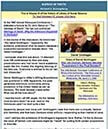
Hatred of Truth (Mar 07, 2016)At the 1997 Annual Holocaust Conference, I attended a lecture by Dr. John Weiss on
“The Ideology of Death” (he had just published
Ideology of Death: Why the Holocaust Happened in Germany). In the course of the discussion, he mentioned “the
hated Goldhagen.” Apparently, the audience understood what he meant—because a substantial conversation ensued
about “the hated Goldhagen.”
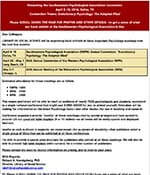
Reach 7,000 book exhibit attendees: extraordinary opportunity (Mar 07, 2016)Presenting the Southwestern Psychological
Association Convention Apr 8-10, 2016, Dallas, TX Convention Theme: Evolutionary Psychology: The Adapted Mind Please
SCROLL DOWN THE PAGE FOR PHOTOS AND OTHER DETAILS—to get a sense of what our book exhibit at the Southwestern Psychological
Association is like. Dear Colleague, LIBRARY OF SOCIAL SCIENCE will be organizing book exhibits at three important Psychology
meetings over the next few months:
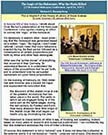
The Logic of the Holocaust (Mar 03, 2016)The Logic of the Holocaust: Why the Nazis Killed (17th Annual Holocaust
Conference, Apr 14, 1997) Richard A. Koenigsberg This is Volume X of the History of Library of Social Science. To
read Volumes I-IX, please click here. LSS Book Exhibit at the Holocaust Conference The 17th Annual Holocaust Conference
at Millersville University: "The Origins of
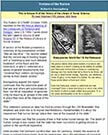
Victims of the Nation (Mar 01, 2016)The Bulletin of COV&R (Oct 1999) reported on the 8th Annual Meeting
of the Colloquium on Violence and Religion, Jun 2-6, 1999. I wrote about the talk I gave in Volume VI and Volume VII
of the History of Library of Social Science. A section of the Bulletin presented a summary of my presentation entitled
“War as Sacrifice.” The reporter stated that the second day of meeting began with a “challenging and much debated treatment”
of the Nazis and the Holocaust
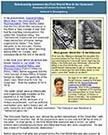
First World War & the Holocaust (Omer Bartov) (Feb 29, 2016)What was the difference between the slaughter that
occurred during the First World War and that which occurred during the Holocaust? Some might say the killing in the
Holocaust was intentional, whereas the killing of the First World War was—what— unintentional? Asking men to get out
of trenches and run into machine gun fire and artillery shells for four years—were their deaths an accident?
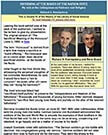
Suffering at the hands of the nation-state (Feb 29, 2016) My talk at the Colloquium on Violence and Religion Richard
A. Koenigsberg This is Volume VII of the History of the Library of Social Science. To read Volumes I-VI, please click
here. Richard A. Koenigsberg and Rene Girard At the conclusion of my lecture, I waited for questions. There was silence.
A young lady in the back of the auditorium tentatively raised her hand. But the audiee
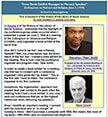
From Book Exhibit Manager to Plenary Speaker (Part VI of the History of LSS) (Feb 26, 2016)“From Book Exhibit
Manager to Plenary Speaker” (Colloquium on Violence and Religion, Jun 3, 1999) Richard A. Koenigsberg This is
Volume VI of the History of the Library of Social Science. To read Volumes I-V, please click here. Theophus "Thee" Smith
Program of the 8th Annual Meeting of the Colloquium on Violence and Religion (COV&R) at Emory University (Atlanta),
Jun
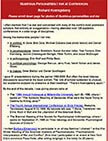
Illustrious personalities I met (Feb 22, 2016)Please scroll down page for photos of illustrious personalities and
me I often mention that I’ve met and conversed with many of the world’s most prominent scholars. Not entirely
an exaggeration—having attended over 125 academic conferences in a wide range of disciplines. Among the memorable people
I ran into: In politics: Al Gore, Bob Dole, Michael Dukakis (see
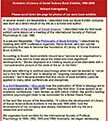
Evolution of Library of Social Science, 1990-2000 (Feb 19, 2016)In several recent LSS Newsletters, I described how
our Book Exhibit company was born as a direct result of my life as a scholar and author. In “The Birth of the Library
of Social Science,” I described how my first book exhibit came about—at a meeting of the International Society of Political
Psychology in Jul 1988. In a second Newsletter, “The Philosophy of Book Exhibits,” I described
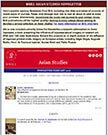
Brill Asian Studies/New Title on Japanese Sexual Imagery & Western Art (Feb 18, 2016)Here’s another exciting
Newsletter from Brill, including new titles and tables of contents of recent issues of journals. Please click through
each link to read all about it—and to make your purchase. Alternatively, recommend the books and journals to your college
library. Brill publications—of the highest quality—belong in every college library seeking to develop a serious collection
on Asian studies.
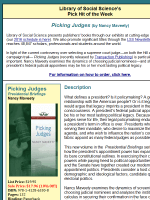
Selecting a supreme court judge (LSS's pick hit of the week) (Feb 18, 2016)Library of Social Science’s Pick Hit
of the Week Picking Judges (by Nancy Maveety) Library of Social Science presents publishers' books through our exhibits
at cutting-edge conferences (our 2016 schedule is here). We also promote significant titles through the LSS Newsletter,
which reaches 48,847 scholars, professionals and students around the world. In light of the current controversy over
selecting a supreme court judge—on both the Hill and the campaign trail— Picking Judges
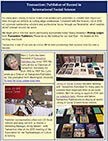
Transaction: Publisher of record in international social science (Feb 18, 2016)For many years Library of Social
Science has worked with publishers to present their important titles through our exhibits at cutting-edge conferences.
Consistent with this mission, LSS in 2016 will promote outstanding scholarly and professional books through our Newsletter,
which reaches 48,847 scholars around the world. We begin with a title that seems particularly appropriate today: Nancy
Maveety’s Picking Judges from Transaction Publishers. Please be on the lookout for our next flyer—for details on this
exciting, new book.
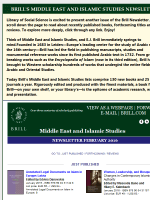
Brill Newsletter: Middle East and Islamic Studies (Feb 11, 2016)Library of Social Science is excited to present
another issue of the Brill Newsletter. Please scroll down the page to read about recently published books, forthcoming
titles and book reviews. To explore more deeply, click through any link. Enjoy! Think of Middle East and Islamic Studies,
and E.J. Brill immediately springs to mind.Founded in 1683 in Leiden—Europe’s leading center for the study of Arabic
since the 16th century—Brill has led the field in publishing manuscripts, studies and monumental reference works since
its first published Arabic text in 1732.
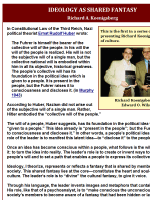
Ideology as Shared Fantasy (Koenigsberg's Theory of Culture) (Feb 8, 2016)This is the first in a series of Newsletters
presenting Richard Koenigsberg's theory of culture. Richard Koenigsberg and Edward O. Wilson In Constitutional Law of
the Third Reich, Nazi political theorist Ernst Rudolf Huber wrote: The Fuhrer is himself the bearer of the collective
will of the people. In his will the will of the people is realized.
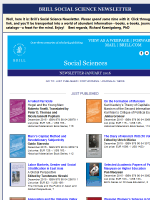
Brill Social Science Newsletter (Feb 4, 2016)Well, here it is: Brill’s Social Science Newsletter. Please spend
some time with it. Click through any link, and you’ll be transported into a world of abundant information—books,
e-books, journals & catalogs—a feast for the mind. Enjoy! Best regards, Richard Koenigsberg, PhD
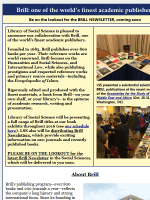
Brill: one of the world's finest academic publishers (Feb 3, 2016) Library of Social Science is pleased to announce
our collaboration with Brill, one of the world’s finest academic publishers. Founded in 1683, Brill publishes
over 800 books per year. Their reference works are world renowned. Brill focuses on the Humanities and Social Sciences,
and International Law, while also publishing prestigious and respected reference works and primary source materials—including
the
Encyclopedia of Islam.
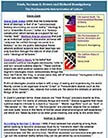
Zizek, Norman O. Brown & Richard Koenigsberg (Feb 2, 2016)Slavoj Zizek states (2009) that the fundamental level
of ideology is that of an “(unconscious) fantasy structuring our social reality.” Ideology is not a “dreamlike illusion,”
rather is a “fantasy-construction which serves as a support for our ‘reality’ itself.” Matthew Sharpe observes that
just as an individual subject’s discursive
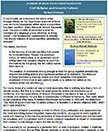
Civil Religion and Security Culture (Michael McKinley) (Feb 1, 2016) If traditionally we understand the nation-state,
through Weber, as the “legitimized exercise of force over territorial boundaries within which a population has
been pacified,” then—because nations frequently lack “the commonality of sentiment shared by members of
a language group, ethnicity, or living space”—the fundamental commonality is actually “the shared memory
of blood sacrifice, periodically renewed.”
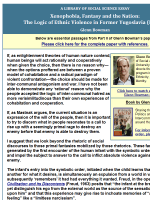
Xenophobia, Fantasy & the Nation (Glenn Bowman, Part II) (Jan 30, 2016)Xenophobia, Fantasy and the Nation: The
Logic of Ethnic Violence in Former Yugoslavia (Part II) Glenn Bowman Below are essential passages from Part II of Glenn
Bowman’s paper. Please click here for the complete paper with references. Glenn Bowman is Professor of Social
Anthropology at the University of Kent where he directs the postgraduate program in the Anthropology of Ethnicit
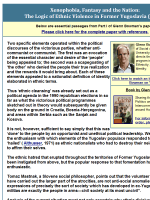
Xenophobia, Fantasy & the Nation (Part I) (Jan 29, 2016)Xenophobia, Fantasy and the Nation: The Logic of Ethnic
Violence in Former Yugoslavia (Part I) Glenn Bowman Below are essential passages from Part I of Glenn Bowman’s
paper. Please click here for the complete paper with references. Glenn Bowman is Professor of Social Anthropology at
the University of Kent where he directs the postgraduate program in the Anthropology of Ethnicity, Nationalism,
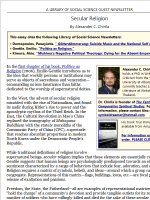
Secular Religion (Alexander Chirila) (Jan 27, 2016)Secular Religion By Alexander C. Chirila This essay cites the
following Library of Social Science Newsletters: • Demopoulos, Panayiotis. “ Götterdämmerung: Suicide Music and
the National Self as Enemy.” • Gentile, Emilio. “Politics as Religion.” • Kimura, Akio. “Mishima’s
Negative
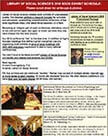
2016 conference schedule (Jan 22, 2016)Library of Social Science creates book exhibits of unsurpassed quality. Our
displays perform a
research function for scholars and educators—presenting comprehensive collections of the most significant titles—the
latest developments—in a field. Becoming an integral part of each conference, attendees return to the LSS exhibit again
and again to check out titles they may have missed the first time around.
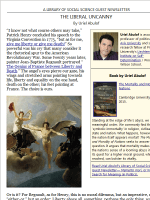
The Liberal Uncanny (Uriel Abulof) (Jan 19, 2016)“I know not what course others may take,” Patrick Henry concluded
his speech to the Virginia Convention in 1775, “but as for me, give me liberty or give me death!” So powerful was his
cry that many consider it the rhetorical spur to the American Revolutionary War. Some twenty years later, painter Jean-Baptiste
Regnault portrayed “The Genius of France between Liberty and Death.” The angel’s eyes pierce our gaze, his wings and
stretched arms pointing towards life, liberty and equality on the one hand, death on the other; his feet pointing at
France. The choice is ours.

What is Library of Social Science's 2016 Promotional Package? (Jan 19, 2016)Exhibiting through our 2016 PROMOTIONAL
PACKAGE means that you simply agree to receive a Request for Booklist before each conference book exhibit (sample form
to the right). THAT'S ALL THERE IS TO IT. Publishers who exhibit through the LSS PROMOTIONAL PACKAGE are never required
to participate in any particular book exhibit.
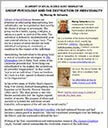
Destruction of the Individual (Murray Schwartz) (Jan 19, 2016)Group Psychology and the Destruction of Individuality
(Murray Schwartz) A LIBRARY OF SOCIAL SCIENCE GUEST NEWSLETTER GROUP PSYCHOLOGY AND THE DESTRUCTION OF INDIVIDUALITY
By Murray M. Schwartz Murray Schwartz teaches Shakespeare, Holocaust Literature, and Literature and Psychoanalysis at
Emerson College in Boston. He is a memb

The Joy and Peril of Obedience (Jan 18, 2016)Commentary by Professor David L. Weddle - It may be worth recalling
a point about this image made by Timothy Beal in Religion and Its Monsters (Routledge, 2002) that the tiny individuals
who comprise the body of the supreme authority, by relinquishing their wills to it, all face inward. That is, they have
no independent view of the landscape over which the religio-political leader rules.
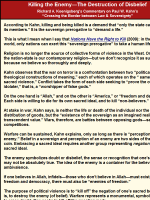
Killing the Enemy—The Destruction of Disbelief (Jan 15, 2016)National Unity as the Willingness to Ask Soldiers to
Die Killing the Enemy—The Destruction of Disbelief Richard A. Koenigsberg's Commentary on Paul W. Kahn’s “Crossing
the Border between Law & Sovereignty” According to Kahn, killing and being killed is a demand that “only
the state can make on its members.” It is the sovereign prerogative to “demand a life.” This is what
I mean when I say that Nations Have the Right to Kill (2009): in the Wester
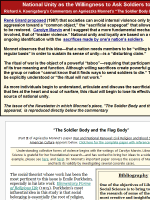
National unity as willingness to ask soldiers to die (Jan 15, 2016)National Unity as the Willingness to Ask Soldiers
to Die Richard A. Koenigsberg's Commentary on Agnieszka Monnet’s “The Soldier Body & the Flag Body”
René Girard proposed (1987) that societies can avoid internal violence only by directing their aggression toward a “common
object,” the “sacrificial scapegoat” that allows internal piece to be restored.
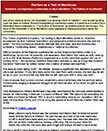
Warfare as Counter-Humiliation (Jan 14, 2016)If the war in Vietnam persisted because some American leaders wished
to avoid “national humiliation,” what can we say about—how can we understand—the American war against Iraq that began
on March 19, 2003? In State of Denial (2006), Bob Woodward recounts how Michael Gerson, Bush’s chief speechwriter, asked
Henry Kissinger why he had supported the Iraq war: “Because Afghanistan wasn’t enough,” Kissinger answered. “In the
conflict with radical Islam, they want to humiliate us. And we need to humiliate them.”
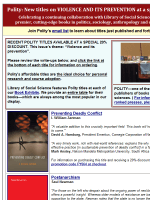
POLITY: new titles on VIOLENCE at a special discount (Jan 13, 2016)Polity: New titles on VIOLENCE AND ITS PREVENTION
at a special discount: Celebrating a continuing collaboration with Library of Social Science—promoting premier, cutting-edge
books in politics, sociology, anthropology and cultural studies. Join Polity’s email list to learn about titles
just published and forthcoming.

Warfare as a Test of Manliness (Commentary on Mendible) (Jan 13, 2016)One of the missions of the LSS Newsletter
is to develop a form of “citation”—one scholar building upon the ideas of another. Richard Koenigsberg’s
commentary seeks to crystallize and extend Myra Mendible’s theory presented in “The Politics of Humiliation”
(published several months ago). The issue of the Newsletter in which Mendible’s piece appeared is reproduced directly
below the commentary.
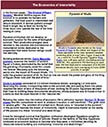
The Economics of Immortality (Jan 11, 2016)Egyptian civilization did not develop an economic surplus for the sake
of biological survival. Their productive energies were devoted to the creation and maintenance of monumental tombs dedicated
to the proposition that some human beings could live eternally.
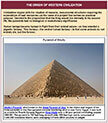
Origin of Western Civilization (Jan 11, 2016) Civilization begins with the creation of massive, monumental structures
requiring the expenditure of vast resources—in the name of a project that serves no practical purpose. Devoted to the
proposition that the King would live eternally in his second life, the pyramids had no biological or evolutionary significance.
Human beings became human in flight from their animal nature—as they enacted a gigantic fantas

The Psychosomatic Root of Politics (Jan 06, 2016)The famous frontispiece to Thomas Hobbes’ Leviathan depicts
the head and torso of a long-haired, mustachioed man. Upon close scrutiny, it becomes evident that the man’s torso
and arms are composed of tiny individual persons, crowded closely together and each looking toward the head of the composite
Leviathan.
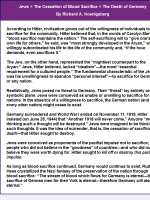
Jews=cessation of blood sacrifice (Dec 21, 2015)According to Hitler, civilization grows out of the willingness of
individuals to sacrifice for the community. Hitler believed that, in the words of Carolyn Marvin, “blood sacrifice maintains
the nation.” The self-sacrificing will to “give one’s own life for others,” he said, was “most strongly developed in
the Aryan,” who willingly subordinated his life to the life of the community and, “if the hour dema
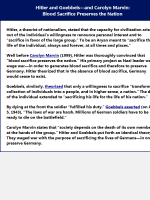
Hitler, Goebbels, and Carolyn Marvin ("Blood sacrifice preserves the nation") (Dec 21, 2015)Hitler and Goebbels—and
Carolyn Marvin: Blood Sacrifice Preserves the Nation Hitler, a theorist of nationalism, stated that the capacity for
civilization arises out of the individual’s willingness to renounce personal interest and to “sacrifice
in favor of the large group.” To be an Aryan meant to “sacrifice the life of the individual, always and
forever, at all times and places.”
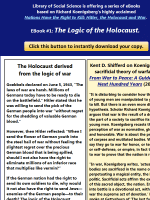
The Logic of the Holocaust: Download eBook at No Charge (Dec 17, 2015)The Logic of the Holocaust: Download eBook
at No Charge Library of Social Science is offering a series of eBooks based on Richard Koenigsberg’s highly acclaimed
Nations Have the Right to Kill: Hitler, the Holocaust and War. EBook #1: The Logic of the Holocaust. The Holocaust derived
from the logic of war Goebbels declared on Jun 5, 1943, “The laws of war are harsh. Millions of Germans today have to
be ready to die on the battlefield.”
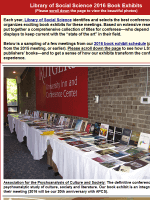
2016 Library of Social Science Book Exhibits (Dec 16, 2015)Each year, Library of Social Science identifies and selects
the best conferences—and organizes exciting book exhibits for these meetings. Based on extensive research, we put together
a comprehensive collection of titles for conferees—who depend on our displays to keep current with the “state
of the art” in their field.
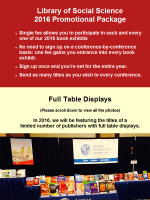
2016 Promotional Package/Full Table Displays (Dec 15, 2015)Library of Social Science 2016 Promotional Package Single
fee allows you to participate in each and every one of our 2016 book exhibits No need to sign up on a conference-by-conference
basis: one fee gains you entrance into every book exhibit. Sign up once and you’re set for the entire year. Send
as many titles as you wish to every conference. Full Table Displays
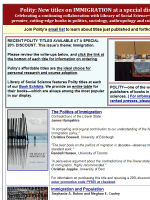
POLITY: new titles on IMMIGRATION at a special discount (Dec 14, 2015)Polity: New titles on IMMIGRATION at a special
discount: Celebrating a continuing collaboration with Library of Social Science—promoting premier, cutting-edge books
in politics, sociology, anthropology and cultural studies. Join Polity’s email list to learn about titles just
published and forthcoming.
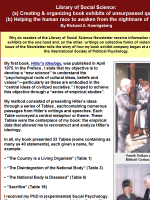
Creating book exhibits/awakening from the nightmare of history (Dec 14, 2015)Why do readers of the Library of Social
Science Newsletter receive information on book exhibits on the one hand and, on the other, writings on collective forms
of violence? This issue of the Newsletter tells the story of how my book exhibit company began at a meeting of the International
Society of Political Psychology.
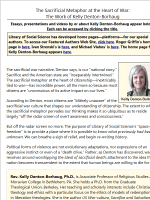
The Sacrificial Metaphor at the Heart of War (Denton-Borhaug) (Dec 09, 2015)The sacrificial war narrative, Denton
says, is our “national story.” Sacrifice and the American state are “inseparably intertwined.”
The sacrificial metaphor at the heart of citizenship—inextricably tied to war—has incredible power, all the more so
because most citizens are “unconscious of its active impact on our lives.”
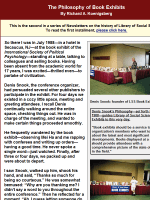
Philosophy of Book Exhibits (Dec 08, 2015)This is the second in a series of Newsletters on the history of Library
of Social Science. To read the first installment, please click here. Denis Snook: founder of LSS Book Exhibits. Denis
Snook’s Philosophy—set forth in 1988—guides Library of Social Science Book Exhibits to this very day: “Book
exhibits should be a
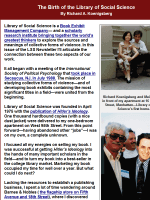
The Birth of the Library of Social Science (Dec 07, 2015)Library of Social Science is a Book Exhibit Management
Company— and a scholarly research institute bringing together the world’s greatest thinkers to explore the sources
and meanings of collective forms of violence. In this issue of the LSS Newsletter I’ll articulate the connection
between these two aspects of our work.
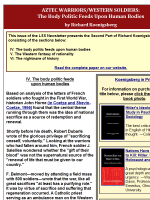
The Body Politic Feeds Upon Human Bodies (Dec 04, 2015)This issue of the LSS Newsletter presents the Second Part
of Richard Koenigsberg's paper, consisting of the sections below: IV. The body politic feeds upon human bodies V. The
Western fantasy of rationality VI. The nightmare of history
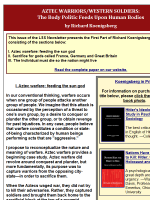
Aztec Warriors/Western Soldiers (Dec 03, 2015)This issue of the LSS Newsletter presents the First Part of Richard
Koenigsberg's paper, consisting of the sections below: I. Aztec warefare: feeding the sun god II. Sacrifice for gods
called France, Germany and Great Britain III. The Individual must die so the nation might live
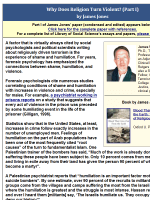
Why does religion turn violent? (Part III) (Dec 02, 2015)A factor that is virtually always cited by social psychologists
and political scientists writing about religiously driven terrorism is the experience of shame and humiliation. For
years, forensic psychology has emphasized the connections between shame, humiliation, and violence.

Why does religion turn violent? (Part II) (Dec 02, 2015)A factor that is virtually always cited by social psychologists
and political scientists writing about religiously driven terrorism is the experience of shame and humiliation. For
years, forensic psychology has emphasized the connections between shame, humiliation, and violence.

Why does religion turn violent? (Part I) (Dec 02, 2015)A factor that is virtually always cited by social psychologists
and political scientists writing about religiously driven terrorism is the experience of shame and humiliation. For
years, forensic psychology has emphasized the connections between shame, humiliation, and violence.
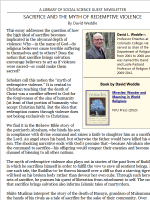
Sacrifice & the Myth of Redemptive Violence (David Weddle) (Dec 02, 2015)This essay addresses the question of how
the high ideal of sacrifice becomes implicated in the abysmal depth of violence: Why—in the name of God—do religious
believers cause terrible suffering to themselves and to others? Does the notion that sacrifice brings salvation encourage
believers to act as if violence were sacred—or could make them sacred?
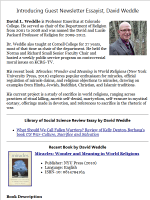
David Weddle: Guest Newsletter Essayist (Dec 01, 2015)David L. Weddle is Professor Emeritus at Colorado College.
He served as chair of the Department of Religion from 2001 to 2008 and was named the David and Lucile Packard Professor
of Religion for 2009-2012. Dr. Weddle also taught at Cornell College for 27 years, most of that time as chair of the
department.
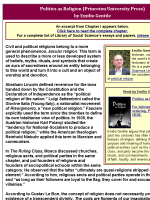
Politics as Religion (Emilio Gentile) (Dec 1, 2015)Civil and political religions belong to a more general phenomenon,
secular religion. This term is used to describe a more or less developed system of beliefs, myths, rituals, and
symbols that create an aura of sacredness around an entity belonging to this world and turn it into a cult and an object
of worship and devotion.
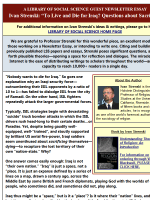
To Live & Die for Iraq (Ivan Strenski) (Nov 30, 2015)We are grateful to Professor Strenski for this wonderful
piece, an excellent model for those working on a Newsletter Essay, or intending to write one. Citing and building upon
previously published LSS papers and essays, Strenski poses significant questions, and puts forth plausible theories—opening
a space for reflection and dialogue. The miracle of the Internet is the ease of distributing writings to scholars throughout
the world—and the capacity to reach 10,000+ readers in a single day.
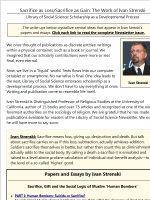
Sacrifice as Loss/Sacrifice as Gain (Ivan Strenski) (Nov 18, 2015) Sacrifice as Loss/Sacrifice as Gain: The Work
of Ivan Strenski Sacrifice as Loss/Sacrifice as Gain: The Work of Ivan Strenski Library of Social Science: Scholarship
as a Developmental Process The write-ups below crystallize central ideas that appear in Ivan Strenki’s papers
and essays. Click each link to read the complete Newsletter issue. Ivan Strenski We once thought of publications as
discrete entities: wr
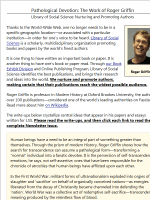
Pathological Devotion (Roger Griffin) (Nov 18, 2015) Pathological Devotion: The Work of Roger Griffin Pathological
Devotion: The Work of Roger Griffin Library of Social Science: Nurturing and Promoting Authors Roger Griffin Thanks
to the World-Wide Web, one no longer needs to be in a specific geographic location—or associated with a particular institution—in
order for one’s voice to be heard. Library of Social Science is a scholarly, multidisciplinary organization promoting
bo
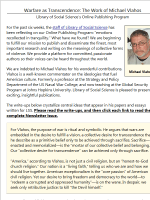
Warfare as Transcendence: Michael Vlahos (Nov 17, 2015) Warfare as Transcendence: The Work of Michael Vlahos Warfare
as Transcendence: The Work of Michael Vlahos Library of Social Science’s Online Publishing Program Michael Vlahos For
the past six weeks, the staff of Library of Social Science has been reflecting on our Online Publishing Program: “emotions
recollected in tranquility.” What have we found? We are beginning to fulfill our mission to publish and disseminat
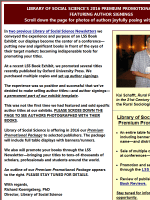
Premium promotional package—with author signings (Oct 2015) LIBRARY OF SOCIAL SCIENCE’S 2016 PREMIUM PROMOTIONAL
PACKAGE: FEATURING AUTHOR SIGNINGS Scroll down the page for photos of authors joyfully posing with their books. Kai
Schafft, Rural People & Communities in the 21st Century (Polity), exhibited at the Rural Sociological Society meeting.
Library of Social Science’s 2016 Premium Promotional Package An entire table for your books—including banner/runner
with publisher name—and distribution of you
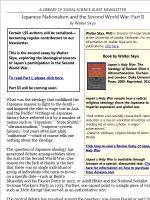
Japanese Nationalism & the Second World War (Part II) (Oct 2015) Japanese Nationalism and the Second World War:
Part II A LIBRARY OF SOCIAL SCIENCE GUEST NEWSLETTER Japanese Nationalism and the Second World War: Part II By Walter
Skya Walter Skya, PhD is Director of Asian Studies at the University of Alaska, Fairbanks. For more information on Walter
Skya and his publications, click here. Book by Walter Skya Japan’s Holy War: The Ideology of Radical Shint o Ultranationalism.
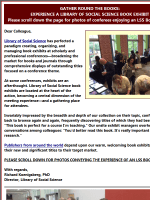
Gather round the books: experience an LSS Book Exhibit (Oct 2015) GATHER ROUND THE BOOKS: EXPERIENCE A LIBRARY OF
SOCIAL SCIENCE BOOK EXHIBIT Please scroll down the page for photos of conferees enjoying an LSS Book Exhibit. Dear Colleague,
Library of Social Science has perfected a paradigm creating, organizing, and managing book exhibits at scholarly and
professional conferences—broadening the market for books and journals through comprehensive displays of outstanding
titles fo
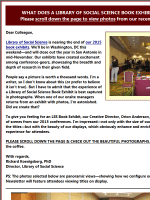
Photos of recent LSS Book Exhibits (Oct 2015) WHAT DOES A LIBRARY OF SOCIAL SCIENCE BOOK EXHIBIT LOOK LIKE? Please
scroll down the page to view photos from our recent conferences. Dear Colleague, Library of Social Science is nearing
the end of our 2015 book exhibits. We’ll be in Washington, DC this weekend—and will close out the year in San Antonio
in mid-Nov. Our
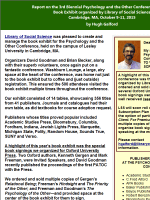
Psychology and the Other Conference Book Exhibit report, with photos (Oct 2015) Psychology and the Other Conference
Book Exhibit report, with photos Report on the 3rd Biennial Psychology and the Other Conference (PATOC) Book Exhibit
organized by Library of Social Science Cambridge, MA, Oct 9-11, 2015 by Hugh Galford Dear Colleague, My report on
the Psychology and the Other Conference is to your left. TO VIEW PHOTOS, PLEASE SCROLL DOWN. A highlight of this year’s
PATOC conference was t
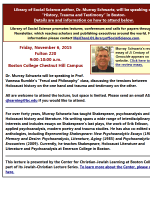
Lecture by LSS author Murray Schwartz: “History, Trauma and Testimony” (Oct 2015) Library of Social
Science author, Dr. Murray Schwartz, will be speaking on “History, Trauma and Testimony” in Boston. Details are and
information on how to attend below. Library of Social Science promotes lectures, conferences and calls for papers through
its Newsletter, which reaches scholars and publishing executives around the world. For information please contact MeiChan1@LibraryofSocialScience.com.
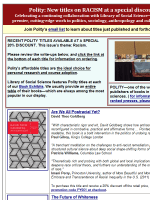
POLITY: new titles on RACISM at a special discount (Oct 2015) POLITY: new titles on RACISM at a special discount
Polity: New titles on RACISM at a special discount: Celebrating a continuing collaboration with Library of Social Science—promoting
premier, cutting-edge work in politics, sociology, anthropology and cultural studies. Join Polity’s email list to learn
about titles just published and forthcoming. RECENT POLITY TITLES AVAILABLE AT A
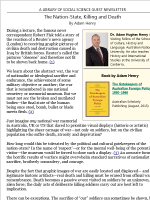
The Nation-State, Killing and Death (Adam Henry) (Oct 2015) A LIBRARY OF SOCIAL SCIENCE GUEST NEWSLETTER The Nation-State,
Killing and Death By Adam Henry Dr. Adam Hughes Henry is a Visiting Fellow of the School of Culture, History and Language,
Australian National University. He also teaches History and International Studies at the University of Canberra. Book
by Adam Henry The Gatekeepers
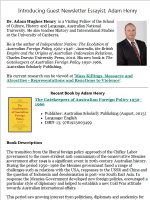
Adam Henry: Guest Newsletter Essayist (Oct 2015) Introducing Guest Newsletter Essayist, Uriel Abulof Introducing
Guest Newsletter Essayist, Adam Henry Dr. Adam Hughes Henry is a Visiting Fellow of the School of Culture, History and
Language, Australian National University. He also teaches History and International Studies at the University of Canberra.
He is the author of Independent Nation: The Evolution of Australian Foreign Policy 1901-1946 - Australia, the
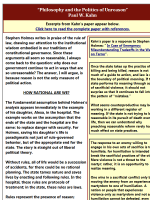
The nation remains a hungry god (Oct 02, 2015) “The Nation Remains a Hungry God” extracted from Chapter
5 Out of Eden: Adam and Eve and the Problem of Evil (Paul W. Kahn) We present here the third and final LSS Newsletter
based on Chapter 5 of Paul Kahn’s Out of Eden. When we no longer understand the sacred character of the political,
Kahn explains, we see in warfare only the “maimed bodies of victims.” Or, he says, this is what we might
begin to see—“but still not quite ye

Sacred Sovereign/Sacred War (Oct 02, 2015) Sacred Sovereign/Sacred War “Sacred Sovereign/Sacred War”
extracted from Chapter 5 Out of Eden: Adam and Eve and the Problem of Evil (Paul W. Kahn) We present here the second
in a series of (three) Library of Social Science Newsletters based on Chapter 5 of Paul Kahn’s book Out of Eden.
Kahn argues that the sacred quality of sovereignty demands “war without compromise” even if it means the
“consumption of the entire polity.” Warfare has nothi

Democratic Suffering (Oct 01, 2015) “Democratic Suffering” extracted from Chapter 5 Out of Eden: Adam
and Eve and the Problem of Evil (Paul W. Kahn) We conclude our presentation of Paul Kahn’s ideas with a series
of (three) Library of Social Science Newsletters based on Chapter 5 of his book Out of Eden. This chapter contains profound
insights on the relationship between nationalism, warfare—and our willingness to suffer—in the name of preserving
the state.

The Politics of Unreason (Oct 2015) The Politics of Unreason “Philosophy and the Politics of Unreason” Paul W. Kahn
Excerpts from Kahn’s paper appear below. Click here to read the complete paper with references. Kahn’s paper is a response
to Stephen Holmes: “ In Case of Emergency: Misunderstanding Tradeoffs in the War on Terror”.
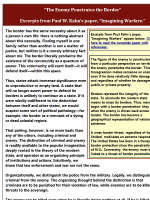
War between Corporate Subjects (Paul W. Kahn) (Sep 2015) “War Between Corporate Subjects” Excerpts from Paul W.
Kahn’s paper, “Imagining Warfare.” Excerpts from Paul Kahn’s paper, “Imagining Warfare” appear to the left, and below.
Click here to read the complete paper with references. Just as the combatant’s acts cannot be grasped as his alone,
the actions of the head of state are not his alone. Warfare is a conflict

"Political Theology" (Paul W. Kahn) (Sep 2015) Review Essay of Paul W. Kahn’s Political Theology REVIEW ESSAY of
Paul W. Kahn’s Political Theology: Four New Chapters on the Concept of Sovereignty by John Wolfe Ackerman Excerpts from
John Ackerman"s essay appear below. To read the entire essay on our website, click here.

“The enemy penetrates the border” (Paul W. Kahn) (Sep 2015) “The enemy is someone who penetrates the
border ” “The Enemy Penetrates the Border” Excerpts from Paul W. Kahn’s paper, “Imagining Warfare.” Excerpts from Paul
Kahn’s paper, “Imagining Warfare” appear below. Click here to read the complete paper with references. The figure of
the enemy is constructed from a particular perspective on territory: the enemy penetrates the border. This transgression
makes someone an
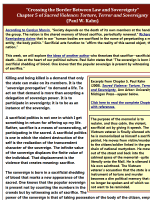
The sovereign is born of the sacrificial shedding of blood (Paul W. Kahn) (Sep 2015) The sovereign is born of the
sacrificial shedding of blood (Paul W. Kahn) “Crossing the Border Between Law and Sovereignty” Chapter 5 of Sacred Violence:
Torture, Terror and Sovereignty (Paul W. Kahn) According to Carolyn Marvin, “Society depends on the death of its own
members at the hands of the group. The nation is the shared memory of blood sacrifice, periodically renewed.” Richard
Koenigsberg cla
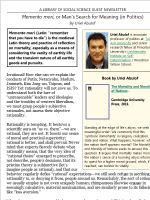
"Remember that you have to die" (Uriel Abulof) (Sep 29, 2015) Japanese Nationalism and the Second World War A LIBRARY
OF SOCIAL SCIENCE GUEST NEWSLETTER Memento mori, or Man’s Search for Meaning (in Politics) By Uriel Abulof Uriel Abulof
is associate professor of politics at Tel Aviv University and senior research fellow at Princeton University’s Liechtenstein
Institute on Self-Determination / Woodrow Wilson School. Book by Uriel Abulof The Mortality a
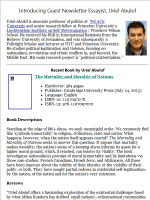
Uriel Abulof: Guest Newsletter Essayist (Sep 28, 2015) Introducing Guest Newsletter Essayist, Uriel Abulof Introducing
Guest Newsletter Essayist, Uriel Abulof Uriel Abulof is associate professor of politics at Tel Aviv University and senior
research fellow at Princeton University’s Liechtenstein Institute on Self-Determination / Woodrow Wilson School. He
received his PhD in International Relations from the Hebrew University of Jerusalem, and was subsequently a Fulbright
Scholar and lecturer at NYU and Princeton
Sep 15, 2015
Nations Have the Right to Kill
Richard A. Koenigsberg
“All the capacity of industrial society—straining at the bit for destruction. Extermination. I call it routinized,
mechanized genocide.” —Professor Robert Weiner, Lafayette College (on the First World War).
Sep 14, 2015
The Goal of War is Death
Richard A. Koenigsberg
Once having read the multitudinous “histories” of the First World War—and posited possible causes—one turns
to the empirical data (9 million killed and 21 million wounded). The future of historical research on the First World
War is to seek to understand the outcome: to identify the precise nature of the intentions that led to this result.
Sep 14, 2015
Why do we know nothing?
Richard A. Koenigsberg
Is it “natural” for men to acquiesce to being slaughtered in battle? Isn’t it astonishing that human
beings know so much about so many things that barely touch us (e.g., that there are 225 billion galaxies in the universe).
Yet we know virtually nothing about this fundamental thing—which lies at the heart of the human condition.
Sep 12, 2015
The Purpose of war is to sacrifice one’s life
Richard A. Koenigsberg
The purpose of war is not to achieve some definable goal, but precisely to sacrifice one’s life for one’s
country. People wage war in order to demonstrate that they are devoted to their society’s sacred ideals. Warfare
is undertaken to prove that one is faithful to a beloved object.
Sep 11, 2015
For Book Authors: Online Book Development Course
Wendy Goldman Rohm
Join a live, online classroom and develop your book with New York Times best-selling author and literary agent, Wendy
Goldman Rohm. We encourage you to join her acclaimed, weekly online course. Her digital classroom features document
sharing, live audio and video, screen sharing, and chat.
Sep 11, 2015
Killing & Dying for Freedom & Democracy
Richard A. Koenigsberg
The intensity and scope of the American government’s reaction to Sep 11—its determination to wage war ferociously
and persist in fighting—represented a response to the gauntlet thrown down by Bin Laden. “Do not think that Muslims
are the only people who have sacred ideals. We Americans too possess sacred values. As you die and kill for Allah,
so we will die and kill in the name of freedom and democracy.”
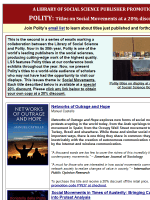
Exciting new titles from Polity/Publishing opportunities with Polity (Sep 11, 2015) New titles from Polity at a
special discount/Publishing with Polity. Join Polity’s email list to learn about titles just published and forthcoming.
RECENT POLITY TITLES AVAILABLE: SPECIAL 20% DISCOUNT. Please review the write-ups below, and click the link at the bottom
of each title for information on ordering. POLITY BOOKS ARE AFFORDABLE: An ideal choice for personal research and course
adoption. At LSS Book Exhibits, Polity titles are always among the most popular.
Sep 11, 2015
The Character of a Nation depends on its Willingness to take casualties
Richard A. Koenigsberg
Bin Laden initiated acts of terror in the name of Allah, feeling he had no choice. “Our life on this planet,”
he said, “would be meaningless if we did not worship the God of the Ancient House.” In a similar vein,
George Bush proclaimed on Aug 21, 2006: “We will complete the mission in Iraq. If we ever give up the desire
to help people to live in freedom, we will have lost our soul as a nation.”
Sep 10, 2015
We’re not in Mogadishu anymore, Toto: American’s Return to an Ideology of Warfare
Richard A. Koenigsberg
After Sep 11, the U. S. abandoned its policy of casualty aversion—reaffirming the ideology of warfare. Attacking
Afghanistan and Iraq, President Bush insisted that America would return to her true character—that of a courageous,
heroic people willing to wage war in the name of a just cause. Just as Middle Eastern warriors were killing and dying
for Allah, so young Americans would sacrifice their lives in the name of freedom and democracy.
Sep 9, 2015
Nation Is a Deity That Worships Itself
Tuomas Tepora
When Finnish society went to war in 1939 against the Soviet Union, considerations of right and wrong lost their relevance.
Every means of fighting and sacrificing for the fatherland and its sacred values became cherished. The war that ended
in defeat retains a sacred position in Finnish collective memory. It can be seen as a motor or a generator of celebrative
nationalism.
Sep 9, 2015
U. S. Foreign Policy, Oct 1993-Sep 2001: Evolution of a Counter-Sacrificial Culture
Richard A. Koenigsberg
By the mid-1990s, the United States had evolved into a “counter-sacrificial culture.” The U.S. was unwilling
to send troops into battle if there was a possibility that even a few soldiers might be killed. Americans no longer
believed there was anything worth dying for. Bin Laden felt his people were superior to Americans—because while his
young followers were willing to sacrifice their lives for a cause, young Americans were weak—unwilling to die for a
cause.
Sep 8, 2015
The Pleasure of Killing One’s Own People
Richard A. Koenigsberg
When UN Secretary General Javier Cuellar realized that Saddam Hussein would not withdraw troops from Kuwait, he declared:
"I cannot imagine someone wants war for the pleasure of killing his own people." National leaders send soldiers
to die in battle, but this way of putting it makes us uncomfortable. However, if we say that it gave Hussein pleasure
to discover that his people did not shirk their duty to sacrifice their lives for their country—our discomfort disappears.
Sep 8, 2015
POLITY: Exciting new titles at a 20% discount
Library of Social Science
We present Polity titles on Social Movements. Please scroll down the page for information on each title, then click
the link at the bottom of the write-up for information on obtaining your own copy at a special 20% discount.
Sep 8, 2015
Death as Proof of Devotion
Richard A. Koenigsberg
People claim to be astonished by contemporary terrorists who blow themselves up in the process of attempting to kill
their enemies. Yet Westerners barely reflect upon their own suicidal political rituals, for example the First World
War. The vast casualties that occurred during that war were the result of millions of men acting precisely like terrorists:
allowing their bodies to be blown to bits as they attempted to blow up the bodies of their enemies.
Sep 4, 2015
Hitler orchestrated the Holocaust: “Do unto others as has been done unto you”
Library of Social Science
“After the stint at base, the railway took German soldiers toward the front line (in WW-I). To a generation with
visual memories of the railway lines running into Hitler’s death camps, tense faces peering from cattle trucks,
there is something disconcerting about the imagery of this journey. Soldiers went in waggons of the same type, 40 of
them in each. Death was a high probability for both.”
Sep 3, 2015
The Ritual of War and National Solidarity (Part IV)
Agnieszka Monnet
Exploring Carolyn Marvin’s theory presented in
Blood Sacrifice and the Nation, Monnet observes that wars are often associated with a rhetoric of renewal or new
beginnings. Monnet discuss the issue of why some wars “work” as national rituals of renewal and some do
not.
Sep 1, 2015
Iwo Jima and Sept. 11: American Sacrifice as a Ritual of National Regeneration (Part II)
Agnieszka Monnet
Monnet says that World War II remains the most effective paradigm for interpreting large-scale death in a national narrative.
After the Sept. 11 attacks, the comparison made was with Pearl Harbor. However, the image that dominated the media
after the attacks was Thomas Franklin’s photo of firefighters raising a flag, drawing comparisons with a very
different World War II event: the planting of the flag on Iwo Jima.
Sep 1, 2015
The Soldier Body and the Flag Body
Agnieszka Monnet
“When we think of the omnipresence of the American flag at official ceremonies, government offices, public buildings,
schools and sports events, as well as the elaborate rules that govern its fabrication, handling and disposal, it is
impossible to deny that there is an element of the sacred attached to this object. More striking still is the way in
which the bodies of dead soldiers are ritualistically covered by flags, and how flags are given to families in lieu
of the body of the slain soldier. There is a physical continuity between the flag-body and the soldier-body.”
Aug 31, 2015
National Identity is Strengthened by Lives that are Lost
Agnieszka Monnet
Monnet explains how wars are often associated with a rhetoric of renewal or “new beginnings”—and function
as the occasion for creating a shared sense of national identity. She examines the notion of sacrifice in the context
of US military history, media treatment of the Sep 11 attacks, the sacred status of the flag, and the ambivalent
position of the soldier
Aug 28, 2015
If the Blood Keeps Flowing, the Nation will Live Forever
Library of Social Science
Based on her study of American history, Carolyn Marvin concludes (1999) that “Blood sacrifice preserves the nation.”
Society depends on the death of its own members at the hands of the group. War is a ritual in which the “lifeblood”
of the members of a nation are shed. The clearest statement of the German ideology of sacrifice appears in the following
statement made by Rudolf Hess: “The stream of blood which for Germany is eternal—the sacrifice of German men for their
Volk is eternal—therefore Germany will also be eternal.”
Aug 28, 2015
Proof
Library of Social Science
Charles Whitehair, a prominent YMCA worker in a French war (convalescent) camp, tells of his encounter during the First
World War—in his book,
Out There (1918, 2002)—with a wounded Canadian solder. As he looked into the soldier’s face—and saw the look of
“personal victory over physical pain,” he took him by the hand and said: “My good man, when you go back to Canada,
back to your home, you need not tell them that you love your country, that you love your home, that you love your God—just
show them your scars.”
Aug 28, 2015
The Holocaust Victim: Obedience Unto Death
Library of Social Science
The German soldier swore an oath to Adolf Hitler vowing, “I shall at all times be prepared to give my life.”
The SS-man, similarly, vowed “absolute allegiance unto death.” Hitler generated the Holocaust according
to the following logic: “If—as leader of the German nation—I am allowed to send the best, finest people to die—why
can’t I also require the enemy of the German people to be obedient unto death?”
Aug 26, 2015
Call for a Reviewer,
Sacred Violence: Torture, Terror, and Sovereignty (Paul W. Kahn)
Library of Social Science
“The destruction of bodies in modern warfare moves toward a generalized practice of torture. We have not so much
abandoned the practice of torture as shifted the locus of an act of violent sacrifice. The battlefield is strewn with
the disemboweled and beheaded, with severed limbs and broken bodies. All have died a terrible death in a display of
sovereign power. To view the battlefield is to witness the awesome power of the sovereign to occupy and destroy the
finite body.”
Aug 25, 2015
Transcendence through War
Alexander Chirila
Chirila responds to Michael Vlahos’s paper, “Rites of Spring:” The myth of transcendence through sacrifice,
bloodshed, and battle is an enduring expression of a desire to bridge Nature and the Divine through Death. Vlahos points
out that we cannot entirely escape our collective desire for transcendence, or the primitive belief that this can be
achieved only through sacrifice.
Aug 24, 2015
The Battlefield as Torture: Speaking the Name of the Sovereign
Paul W. Kahn
In modern times, Kahn says, the locus of the practice of torture and execution has shifted from the scaffold to the
battlefield. The battlefield is strewn with the “disembodied and beheaded, with severed limbs and broken bodies;”
men who have died a terrible death in a “display of sovereign power.” To view the battlefield is to witness
the “awesome power of the sovereign to occupy and destroy the finite body.”
Aug 20, 2015
Japanese Nationalism & the Second World War
Walter Skya
The author explores the relationship between the ideologies of Nazi Germany and Japan, a topic neglected in the historiography
on the Second World War. Skya proposes a systematic analysis of the origins, development, and triumph of the ideology
that inspired the Japanese elite to embark on conquest in Asia and the Pacific, and that mobilized the Japanese masses
to fight to the death.
Aug 17, 2015
Human Beings Created Airplanes—and War—and Genocide
Library of Social Science
Why was the airplane created? Flight represented a human creation, growing out of a human desire or fantasy. The airline
industry exists—because human beings continue to bring it into existence. We keep this institution alive through our
continued attachment to it. The same is true for any element of culture, including warfare and genocide.
Aug 17, 2015
D-Day (Jun 6, 1944), the Invasion of Normandy: “A moment of unique American sacrifice”
Michael Vlahos
Michael Vlahos podcast on the John Batchelor radio show: “We had to create—not just a mythic moment—but a moment
of unique American sacrifice. We managed to do that. As we look back, it is the great liturgy of the American experience—not
just in World War II—but of the America that was born on that day. It’s a kind of high mass of the nation—of
the American ethos.”
Aug 11, 2015
The ideology of sacrifice is hemorrhaging
Michael Vlahos
In his essay, “The Rites of Spring,” Michael Vlahos stated that War in Modernity was an “extended
ritual demanding mass sacrifice in which the literal ‘body and blood’ of millions at once renewed and re-fertilized
the nation.” However, this national theology “no longer rules America as it once did.” The fervent
faith of a whole nation—leading to sacrifice on the high altar—has been “emptied of belief.”
Aug 10, 2015
The Primary Purpose of War is Ritual and Symbolic
Michael Vlahos
If the primary purpose of war is ritual and symbolic, it means that war is instrumental of itself. It also means that
the creation of ritual and symbol through war is intended to create a feeling in us, to make us feel good. Good about
what exactly is the crucial question?
Aug 6, 2015
Political Violence: The Other must die for our ideal
Richard A. Koenigsberg
In terrorism and war, it is not a question of “one side” versus “the other side.” There is always
a “third”: the sacred ideal that allows everything to happen. Individuals sacrifice their lives for their
society’s sacred ideal—and compel Others to do the same. Suicide bombers die for Allah, and ask Others to do
so. Americans sacrifice their lives for freedom and democracy—and ask Others to do the same.
Aug 5, 2015
Love of War = Idealization of the Nation
Richard A. Koenigsberg
Hitler was a fanatic nationalist. Everything he did begins and ends with attachment to Germany. Describing the behavior
of his regiment during the First World War, he stated that his comrades went into battle “as to a dance;”
precious blood “sacrificed itself joyfully;” the young men ran to their deaths “with gleaming eyes.”
How are we to understand the power of the hold that “Germany” had upon Hitler—the hold that “countries”
have upon us to this very day?
Aug 3, 2015
Winning Armageddon: Dietrich Eckart and the Religious Origins of the Holocaust
David Redles
Dietrich Eckart and leading Nazi ideologues believed that they were a chosen elect whose divinely inspired mission was
to save the world by defeating the satanic Jewish-Bolshevik conspiracy. The realization of the Third and Final Reich
could only be accomplished through an
Endkrieg (Final War) between Aryans and Jews. This Armageddon of competing races, one of God and the other born
of Satan, could only be won with the utter annihilation of one or the other.
Aug 3, 2015
Why do the best men lose their lives, while the worst survive?
Richard A. Koenigsberg
Neither Hitler nor Hoche and Binding were willing to engage the question: “Why does the state authorize the deaths
of its best human beings?” Rather, they proposed: “If the state authorizes the killing of its best human
beings, why should the state spare the lives of its worst human beings?” The Nazi project of mass murder began
with the killing of defective children and mental patients.
Jul 31, 2015
If the state kills its soldiers, it can kill mental patients
Richard A. Koenigsberg
Nazi mass-murder begins with the syllogism: “If the state has the authority to sacrifice (kill) its best people
(soldiers), why does it not also have the right to kill its worst people (mental patients)?” The conclusion follows
from a premise, but the premise has not been analyzed. Why does the state have the authority to ask soldiers to die?
Jul 30, 2015
To Promote Life, Life Must be Sacrificed
Library of Social Science
The ideology or utopian fantasy that generated the Holocaust was identical to the ideology or utopian fantasy that generated
the First World War: In order to promote life, life itself had to be sacrificed.
Jul 30, 2015
The State Must Own Death
Library of Social Science
Chapter II of James Tyner’s,
Genocide and the Geographical Imagination, entitled, “The State Must Own Death” provides a synthesis
of current research—articulating the origins and development of the Nazi’s “Euthanasia Movement”—and
how medical killing led directly to the Holocaust. If the state is willing to kill its own soldiers, why can’t
it kill human beings who are “worthless? Beginning with this syllogism, we can understand the origins of mass-murder
in Germany.
Jul 30, 2015
Civil Religion & the Cult of the Dead
Judy Hemming and Michael McKinley
Political collectivities are founded on violence and are inherently brutal. Nationalism is “a community of blood”.
Government is impossible without religion. National security is a ritual, pursued and achieved through requiring its
citizens to fight, kill, and to die.
Jul 30, 2015
The Cult of the Dead in Australia
Judy Hemming and Michael McKinley
Australia and New Zealand, in the pursuit of “security,” have committed excesses, repeatedly, from generation
to generation. From the countless inscriptions proclaiming the country's gratitude to those who "gave their lives"—to
the gates of the British memorial at Thiepval, the Somme, where 73,000 soldiers of the Great War are classified as
"missing", the deceased did not
give their lives voluntaristically; they had it taken from them arbitrarily and violently.
Jul 29, 2015
Australian Nationalism & the Ideology of Sacrificial Death
Michael Roberts
The Gallipoli battlefield of 1915 in World War One served as an emblem of nationhood: the Australian nation, came into
being “on the foundations provided by the slaughter of its young men.” Australian men enlisted in the fighting
services in droves. Australians were addressing Britain more than anyone else: they would prove their mettle. It was
going to be “a baptism of fire,” and thereby a passage to nationhood.
Jul 28, 2015
Nation State, Civil Religion, and Blood Sacrifice
Judy Hemming and Michael McKinley
Traditionally we understand the nation-state as the legitimized exercise of force over territorial boundaries within
which a population has been pacified. Because nations frequently lack the commonality of sentiment shared by members
of a language group, ethnicity, or living space—the fundamental commonality is actually the shared memory of blood
sacrifice, periodically renewed.
Jul 20, 2015
Principles of Online Publication (Part III): Authorship and Readership as a Developmental Process
Library of Social Science
Publications were once thought of as fixed objects. The Internet facilitates the process of change. One idea grows out
of another; one idea grows into another. Publication leads to deeper understanding. An author produces his or her version
of truth—so that the reader may develop his or her own version of the truth.
Jul 17, 2015
Principles of Online Publication (Part II): Dynamic Relationship Between Author and Reader
Library of Social Science
The most significant characteristic of online publication is the speed with which ideas can be presented. Co-extensive
with instant publication is the fluid nature of writing. When one writes on the Internet, there is a close connection
between the author and audience. Writing an essay for the LSS Newsletter, one expects the email will be opened by 10,000
readers.
Jul 16, 2015
Principles of Online Publication (Part I): Overcoming Insularity
Library of Social Science
Before the Internet, it was difficult for researchers to communicate, even with people in their field. One had to wait
for the appearance of one’s article in a journal. Today, the Web facilitates the exchange of information and
allows building relationships, quickening the pace of change. Scholars are able to break free of boundaries, allowing
significant ideas to circulate around the world.
Jul 8, 2015
POLITY: Titles on Social Movements at a 20% discount
Library of Social Science
This is the second in a series of emails marking a collaboration between the Library of Social Science and Polity. Now
in its 30th year, Polity is one of the world’s leading publishers in the social sciences, producing cutting-edge
work of the highest quality. We present Polity’s titles to a world-wide audience of scholars. This issues’
theme is: “Social Movements.” Each title below is available at a
special 20% discount. Please click any link to obtain your own copy at a 20% discount.
Jul 7, 2015
Retribution: Counterterrorism, American Exceptionalism, and Retributive Justice (Part III)
Michael Vlahos
Moving American exceptionalism away from Universalist visions of redemption and back to retributive justice is itself
an admission of weakness and fear—and the impending end of its own Universalist claim. Terrorism has come to dominate
our religion in unconquerable antithesis. In today’s American civil-religious thought, terrorism is the Devil
himself—and the Devil drives.
Jul 7, 2015
American Exceptionalism: Counterterrorism, American Exceptionalism, and Retributive Justice (Part I)
Michael Vlahos
American exceptionalism should be understood as the core passion of American civil religion, envisioning a nation rooted
in a savage yet pure wilderness—“God’s American Israel”. The act of taming one’s own world
is in itself an act of purification—and of tempering and strengthening those who might one day redeem a corrupted and
oppressed humanity.
Jul 7, 2015
Three Kinds of Terrorist (Part II)
Michael Vlahos
The terrorist is the terrorist “against the body,” or the
heretic. Society may condemn him, yet if he recants there is hope for return to the body politic. The second terrorist
is the apostate, who has renounced the American idea wholesale and seeks its overthrow. The third type is the stranger,
alien to the sacred body.
Jul 6, 2015
Why See America as a Religion?
Michael Vlahos
Why see America as a religion? How can we hold to our true faith if we see it as just another sacred construct in humanity’s
long search for meaning? Communities of belief perform best when belief is unshaken. Yet there are urgent reasons why
we need to see ourselves for what we are. We are entering a time of crisis in America’s relationship with the
world, and in American identity.
Jul 3, 2015
America is a Religion: Our High-Church Politics and Sacred War
Michael Vlahos
America is not just civil religion—it is honest-to-God church religion. Our nation tells us who we are, and how we should
live together. Religions are living faiths. The word is from the Latin religare—to bind together—and that is what religion
is for: To frame how we belong to each other, what is meaningful in life, and how together we should cherish each other.
Jul 2, 2015
Terrorism’s Sacred Heart: The Sacrifice
Michael Vlahos
What makes terrorism so powerful is that it leverages the most powerful of human actions: the sacrifice. For thousands
of years, human sacrifice has represented a sacred rite, with many layers of explicit ritual and symbol—in which our
most precious loss transforms into our most precious gift. Think of the sacrifice—enacted and memorialized—as the mortar
of our collective belief and belonging.
Jun 27, 2015
20th Century Pharaohs: Pyramids and the Origin of Western Civilization (Part III)
Richard A. Koenigsberg
The psychic mechanism that compels us to link ourselves with political leaders today is the same mechanism that generated
attachment to Pharaohs during the time of the Pyramids. In each instance, some extraordinary force or power is imagined
to emanate from a place in society outside the self.
Jun 26, 2015
The Wish for a Tyrannical Leader (Part II)
Richard A. Koenigsberg
Lewis Mumford on the pyramids: “It is doubtful that these heroic public works—that demanded an almost superhuman
effort and purpose—would have undertaken for any purely mundane purpose. Only prostration before the
mysterium tremendum, some manifestation of godhead in its awful power and luminous glory, could call forth such
excessive, collective effort.”
Jun 26, 2015
The Power of the Pharaoh: Pyramids and the Origin of Western Civilization (Part I)
Richard A. Koenigsberg
The great projects brought forth by the Ancient Egyptians grew out of the following dynamic: First, belief that the
king was the embodiment of a god. Secondly that—because of the king’s divine status—absolute obedience was required.
The capacity of the Pharaoh to command obedience allowed him to produce a colossal labor force—to undertake gigantic
building projects.
Jun 25, 2015
Reading Death and Sacrifice in the Berlin Völkischer Beobachter, February 1942–March 1943 (Part I)
Robert Terrell
Terrell probes the work of propagandists in the Berlin
Völkischer Beobachter, the official paper of the National Socialist German Workers Party as they constructed and
reconstructed subjective meanings of war, death and sacrifice. The chronology spans from Operation Barbarossa, the
German invasion of the Soviet Union, to Heroes Memorial Day (March 1943).
Jun 25, 2015
Silent Thunder: War Memorials and the Break Up of the Collectivistic Motive to Sacrifice
David W. Seitz
“Christianity portrayed Christ’s sacrificial death as the perfect model of righteous action. Representation
of this notion of sacrifice is seen in American war memorials. Visitors discover an overwhelming sea of white marble
headstones in the shape of the Latin cross, familiar allusion to Christ’s sacrifice. It becomes hard to deny
the swelling sense of sacrifice that permeates from the numerous, harmonized rows of white crosses.”
Jun 24, 2015
War and Nationalism: Part II (Daniele Conversi)
Daniele Conversi
“Key to the nation-state’s war effort has been its capacity to secure the willingness of its able-bodied
citizens to die for a ‘higher’ ideal. Such power of life and death over most of its population, previously
unthinkable, could only occur when nationalism allowed ordinary citizens to visualize the nation as a unified, organic
body, the defense of which demanded individual sacrifice.”
Jun 24, 2015
War and Nationalism: Part I (Daniele Conversi)
Daniele Conversi
Jacobin propaganda seized Valmy as a foundational myth, unleashing waves of enthusiasm and belief that fighting in the
name of ‘freedom’ would grant soldiers immortality. This was the ‘first total war,’ a concept
usually associated with the ‘human wave attacks’ of World War I. At Valmy, for the first time, the sheer
number of men ready to sacrifice themselves in the name of nationhood and patriotism—became decisive.
Jun 18, 2015
Nations Kill a Lot of People
Richard A. Koenigsberg
Reviewing the history of the 20th century, nation-states have something in common: they killed millions upon millions
of human beings. Do we wish to say that each event—each instance of death by government—had a unique, idiosyncratic
cause? Discussing his theory on the Democide, Rummel concludes that the “preeminent fact about government”
is that “some murder millions in cold blood”
Jun 16, 2015
Death by Government
Richard A. Koenigsberg
According to Rummel’s concept of democide, intentionality (premeditation) is crucial. Democide is meant to “define
the killing by states as the concept of murder does individual killing in domestic society.” Democide, in short,
is murder by government. The idea that the primary function of the state is to provide “security” would
appear to be a fantasy, a dream—or delusion.
Jun 12, 2015
The Quest for ”National Security” requires an Enemy (source of insecurity)
Richard A. Koenigsberg
Security is contingent upon insecurity. Security discourses are an integral part of the state’s construction of
identity, portraying certain dangers as threatening the “Us inside the state borders,” specifying “what
we are not and what we have to fear”—what the state should defend us from. Security discourses are not, fundamentally,
a
response to danger, but rather function to
reproduce danger: as long as there are dangers that generate insecurity—then the state can perform its security
functions.
Jun 11, 2015
What is “National Security”?
Richard A. Koenigsberg
Security, according to classic IR theory, concerns the “fate of human collectivities”. The standard unit
of security is the “sovereign territorial state.” Koenigsberg’s critique of security studies—based
on his study of history—is that national security may be
entirely unrelated to the personal safety and security of individuals residing within a nation-state. In Nazi
Germany, security for the nation meant insecurity for individuals. Millions of actual Germans died in the name of securing
the idea of the German nation.
Jun 10, 2015
POLITY: Titles on America’s Future as a World Power at a 20% discount
Library of Social Science
Extending its work bringing Polity titles to scholars and customers at conferences, LSS emails will now promote a thematic
selection of Polity books at special discounts. This issue’s theme:
America’s Future as a World Power. Please click any link on the titles below to obtain your own copy at
a 20% discount.
Jun 8, 2015
Writing Security: United States Foreign Policy and the Politics of Identity (David Campbell)
Lida Bteddini
Analyzing the relationship between the nation and state is vital to understanding the critical security approach to
international relations. Boundaries define “an ‘inside’ from an ‘outside,’ a ‘self’
from an ‘other,’ and ‘domestic’ from ‘foreign.” It is evident that the state’s
identity is secured primarily through a ‘representation of danger’. The ability of the state to define
its boundaries in relation to those defined as foreign is a measure of its capacity to exist as a state.
Jun 6, 2015
‘Postmodernising’ Security
Andreas Behnke
Critical Security Studies, Andreas Behnke: “Only if the identity authorized from a sovereign position remains
undisputed can it remain sovereign. The “other” would unravel the sovereign’s self-certainty and
capacity for collective mobilization if it established its legitimacy. The very mode of being different is a threat,
an enemy to sovereignty.”
Jun 4, 2015
Re-thinking (in)security discourses from a critical perspective
Josefina Alvarez
Josefina Alvarez: “Presenting dangers to the population by means of its authorizing role, the state offers itself
as the solution to deal with them. Representations of danger turn into a tool to maintain the state’s legitimacy
and justify its existence. Security discourses are an integral part of the state’s construction of its own identity—the
state’s constant reproduction of danger rather than the state’s response to danger.”
Jun 1, 2015
Scott Atran on Sacred Values
Library of Social Science
Atran has developed the concept of “sacred values:” moral imperatives that drive behavior “independently
of concrete material goals.” Devoted actors willingly “make costly sacrifices, including fighting and dying.”
Sacred values differ from material or instrumental values in that they drive action in ways that seem “dissociated
from prospects for success.” Suicide bombers are willing to make sacrifices “all out of proportion to likely
prospects of success.”
Jun 1, 2015
Dying and Killing for Sacred Objects
Richard A. Koenigsberg
Scott Atran developed the concept of “sacred values” to explain terrorism and suicide bombings. Does this
concept illuminate Western forms of political violence as well? During First World War, millions of human beings died
and killed expressing fealty toward sacred objects with names like France, Germany, Great Britain, Russia, or Italy.
Hitler said: “We may be inhumane, but if we rescue Germany we have performed the greatest deed in the world.
May 29, 2015
Entries on the Ideologies of War Website (Kubrick – Stalbank)
Library of Social Science
In
Dr. Strangelove, General Jack Ripper explains the actions he has taken against the communist conspiracy, stating
that a “foreign substance” is being “introduced into our precious bodily fluids without knowledge
of the individual.”
May 29, 2015
Entries on the Ideologies of War Website (Hillgruber – Krauthammer)
Library of Social Science
People have a tendency to “argue with culture”—focusing on particular ideas within a society—then struggling
to refute these ideas; showing why they are incorrect or wrong. Why this assumption that cultural ideas—what is presented
by “society”—has anything to do with truth?
May 28, 2015
Entries on the Ideologies of War Website (Alvarez – Herf)
Library of Social Science
Understanding is not purely intellectual. New and disturbing ideas need to be assimilated—psychologically. In the next
few issues of the LSS Newsletter, we’ll slow down—to integrate what we’ve learned so far. Below are 32
entries appearing on our Ideologies of War website. Please click through any item to read the paper, book Chapter,
book excerpt or speech.
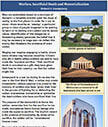
Warfare, Sacrificial Death and Memorialization (May 26, 2015) One may hypothesize that the purpose of war is to
generate death in order to create a certain kind of story or narrative. The purpose of this narrative is to give citizens
“faith” in their country. The gravestone or tomb is a reminder or remembrance of soldiers who died—rekindling
faith. The body and energy of the soldier is transformed into a tomb. A soft, vulnerable human being is transformed
into a rock.
May 25, 2015
Warfare, Gravestones, and the Megalithic Cult of the Dead
Richard A. Koenigsberg
Monuments to honor dead soldiers can be seen as megalithic structures. The soldier’s body becomes transformed
into a slab of rock that seems capable of living forever—because it is already dead. The objective of warfare (battle)
is to transform human bodies into slabs of stone. Mircea Eliade suggests that these stones constituted a “substitute
body” in which the souls of the dead were incorporated.
May 21, 2015
Political Violence as Submission to a Sacred Object
Richard A. Koenigsberg
Once warfare was thought of as forms of “aggression”—as if human beings possessed a biological drive to
harm or kill other human beings. It now seems that political violence derives from a spiritual or moral quest. Scott
Atran writes about “devoted actors” who fight and die in the name of “sacred values.” Michael
Roberts writes of “sacrificial devotion” to characterize violent political acts undertaken in the name
of a sacred mission.
May 20, 2015
Bin Laden’s Ideology: “Our Youth Love Death as you Love Life”
Richard A. Koenigsberg
Asserting the superiority of his young men to American youth, Bin Laden claimed, “These youths love death as you
love life.” Whereas the American problem was how to convince troops to fight, his problem was how to “restrain
our youth to wait their turn.” Bin Laden asserted the superiority of Moslems to Americans. Whereas his people
possessed sacred values for which they were willing to die, Americans possessed no such sacred values.
May 18, 2015
Terrorists and Nazis as “Devoted Actors” who Kill for Sacred Values
Richard A. Koenigsberg
World War I was a monumental episode undertaken by “devoted actors” who died and killed for sacred values.
Nazism was a case study in “sacrificial devotion”. Hitler said: “We may be inhumane, but if we rescue
Germany we have achieved the greatest deed in the world.” Radical Islamists rescued the ideal of Allah by killing
infidels; Hitler destroyed “non-believers” who refused to acknowledge the omnipotence of Germany.
May 1, 2015
Nation-Building, Meaning-Making and Sacrifice
Ivan Strenski
Nations, like religions, are meaning-making entities of a transcendent sort, creating an aura of sacredness about their
doings. Not only do national borders mark boundaries of a sacred precinct as ‘tabu’ (as do any temple’s
holy of holies), but also the accessories of nationalism—its flags, monuments and anthems—partake of the same religious
glow as a sacred being.
May 1, 2015
Human Bombers as Sacrificial Gifts
Ivan Strenski
Gifts are relational, not solitary actions. Who is obliged to accept them? In the case of the Israel/Palestine dispute,
besides Allah, it is the imagined community of Palestine that—in the minds of the bombers—is obliged to accept the
offering of the death of the self-immolating bomber. It is for Palestine and Palestinians that these sacrifices are
offered, who are obliged to accept them.
Apr 30, 2015
Human Bombers: Suicide or Sacrifice?
Ivan Strenski
To understand Muslim “human bombers”, we see them within the discourse of jihad, but also within that of “sacrifices”
and “gifts”. Suicide bombers act because of their social relationships—whether these are with other human beings or
with divine persons. Human bombings are not simply matters of utilitarian military tactics, but are also religious
and social—martyrdoms and sacrifices. Beyond their action in service of jihad, “human bombings” are seen as supreme
gifts given in the interests of enhancing the conditions of others.
Apr 30, 2015
Transcultural Identities
Roger Griffin
The fusion of cultures is becoming more powerful throughout the non-totalitarian world. As long as the uniqueness of
a culture is asserted in an integrative spirit as just one of an individual’s sources of belonging and the principle
of multiple identities is recognized and promoted—throughout society—then multi-culturalism can be a source of newness
and mutual enrichment. Everyone can celebrate having a hyphenated identity with plural belongings and self-descriptions.
Apr 29, 2015
Identificatory Belonging & the Desire to Destroy
Roger Griffin
Militant forms of ultranationalism exploded into orgies of slaughter and ‘sacrifice’ on behalf of organically
conceived nations in the First World War—as energies liberated from the decay of Christianity became channeled into
defending the ‘nation’ or ‘people’, and asserting its rights to exist at the expense of the
individual. The 1930s saw the rise of two ‘modernist’ states that led to the deaths of millions of people
in the pursuit of their utopias.
Apr 29, 2015
The Need to Belong
Roger Griffin
Human beings have a need to belong, to feel an integral part of something greater than themselves. The search for transcendence
can assume a pathological aspect—taking on a nihilistic form inconsistent with the demands of survival. It is the perversion
of self-transcendent emotions, not self-assertive ones, which have been largely responsible for the chronicle of atrocities
that human beings have inflicted on each other down through the ages.
Apr 28, 2015
Pride, Patriotism, & the Gulf War Redemption
Myra Mendible
In nations that have suffered military defeat, “stab in the back” myths emerge as a defense against shame:
It is not our fault, we are worthy, but we were betrayed. In the US, the Vietnam syndrome incorporates the stab-in-the
back myth as a way to secure the nation’s positive self-image.
Apr 27, 2015
The Erosion of National Self-Esteem
Myra Mendible
The more a social group overvalues pride as a sign of self-respect, the more dreaded the stigma of public humiliation.
Maintaining a positive self-image is crucial to a citizenry weaned on myths of exceptionalism, linking American identity
to Biblical stories of a “chosen people” charged with saving the world. When this high opinion is challenged,
our leaders will soothe our wounded egos by claiming that others are simply “jealous;” when such criticisms
come from within, dissenters are dismissed as “un-American.”
Apr 27, 2015
The Politics of Humiliation
Myra Mendible
The “Vietnam Syndrome” tell us that Americans had fallen victim to a debilitating “syndrome”
of passivity and weakness. Humiliation had made us “soft.” The post-Vietnam generation presumably suffered
from a “sickly inhibition against the use of military force”: a breakdown of national will, loss of confidence,
and unwillingness to engage in protracted conflicts abroad.
Apr 24, 2015
The Bliss of Completion
Roger Griffin
The third stage in the radicalization process is the mindset in which the sanctity of the mission has been so internalized
that acts of violence against society can be carried out with a sense of pride, and even cosmic self-fulfillment. Rohrmoser’s
reference to ‘salvation or perdition’ is telling, once it is understood that the psyche experiences the
nomos as holy—even if it is an entirely secular utopia.
Apr 23, 2015
Splitting and the Manichaean World-View
Roger Griffin
Splitting, a concept first developed in the discipline of child psychology, involves the projection of ‘bad feelings’
and ‘feelings of badness’ onto out-groups—to a point where the world comes to be seen as a theatre of cosmic
war. The individual becomes enlisted in a Manichaean fight to the death between opposing metaphysical, cultural or
(for racists) biological principles—on which the survival or death of humanity seems to depend.
Apr 23, 2015
How to Think About Suicide Bombers
Ivan Strenski
Can we move toward understanding the phenomenon called suicide bombing? Strenski shows how perspectives developed in
the modern study of religion help make sense of this troubling phenomenon. He proposes paying greater attention to
the ‘sacrificial’ designations of “human bombings”.
Apr 23, 2015
Terrorist Radicalization: Nomic Crisis
Roger Griffin
A fundamental psycho-social syndrome transforms a non-violent, non-militant, ‘normal’ individual—with values
too inchoate and confused to be dignified with the term ‘worldview’—into a fanatical devotee of a creed
demanding an act of destruction that sends a message of terror to a target audience.
Apr 17, 2015
Publishing with Library of Social Science
Library of Social Science
Library of Social Science publishes and publicize emerging scholars. Summaries of several exciting LSS papers appear
in this issue. We welcome others to join the Library of Social Science community—focusing on understanding and revealing
the sources and meanings of collective forms of violence.
Apr 15, 2015
Exciting Publishing Opportunities for Emerging Scholars
Library of Social Science
Library of Social Science publishes and publicize emerging scholars. Summaries of several exciting LSS papers appear
in this issue. We welcome others to join the Library of Social Science community—focusing on understanding and revealing
the sources and meanings of collective forms of violence.
Apr 14, 2015
Judaism as Disbelief in the Resurrection of the Dead
Richard A. Koenigsberg
St. Paul: “If there is no resurrection of the dead, then not even Christ has been raised. And if Christ has not
been raised, our preaching is useless and so is your faith.” The idea that one’s faith is futile may arouse
rage in the mind of the believer. What an anti-Semite seeks to kill off—when seeking to kill Jews—is disbelief, that
is, the belief that there is no such thing as the resurrection of the dead.
Apr 13, 2015
Warfare, Christ, and Sacrificial Death
Richard A. Koenigsberg
References to combat deaths as “necessary sacrifices” are drawn from centuries of Christian interpretation
of the “Death of Jesus as required for salvation.” Warfare thus is transformed into a “sacred enterprise”
devoted to saving the nation from its enemies. The death of a German soldier resembled the “free-will offering
of Christ himself, who left his life voluntarily for his brethren.”
Apr 10, 2015
Strengthening Cultural War Studies (The Ideological Model of War)
Nico Carpentier
Although each war has its own history, wars are built on remarkably similar ideological mappings. As Keen put it, “In
the beginning we create the enemy. Before the weapon comes the image. We think others to death, and then invent the
battle-axe or ballistic missiles to kill them.” The identity of the Enemy is indispensable to the construction
of the identity of the Self, as the evilness of the Enemy is a necessary condition for articulating the goodness of
the Self.
Apr 3, 2015
Sacrificial Devotion (Part II)
Michael Roberts
The LTTE (Liberation Tigers of Tamil Eelam) or Tamil Tigers was a separatist organization based in northern Sri Lanka.
It waged a violent secessionist campaign that sought to create an independent Tamil State. LTTE was defeated by the
Sri Lankan military in May 2009. In his review essay, Michael Roberts compares the sacrificial ideology of World War
I nationalism and Nazism with that of the LTTE.
Apr 3, 2015
Hitler, Nationalism, Sacrifice: Review Essay of
Nations Have the Right to Kill (Part I)
Michael Roberts
Ever since he wrote
Hitler’s Ideology (1975), Richard A. Koenigsberg has deployed his own institutional base—the Library of
Social Science in New York City—to expose themes in the Nazi ideology. In this monograph, one theme focuses on the
manner in which Hitler’s experienced the First World War—and the principle that the individual must sacrifice
self for national cause.
Apr 2, 2015
The Law of Sacrifice
Library of Social Science
Library of Social Science researchers and scholars now focus on the study of sacrificial death in comparative perspective—hypothesizing
a law of sacrifice.
March 31, 2015
Metaphors, Fantasy & the Social Construction of Reality
Richard A. Koenigsberg
The Nazis constructed reality based on a shared fantasy. This fantasy was contained within and articulated by the metaphors
they used. Metaphors within ideological rhetoric convey the fantasy that an ideology seeks to express.
March 25, 2015
How Is It Possible to Experience a Body Politic?
Richard A. Koenigsberg
The mass-rallies constituted Hitler’s method for creating and experiencing the body politic he longed for. Each
human being massed closely next to another human being—was like a cell in a gigantic body. Each of these human beings
or cells responded precisely to Hitler’s every utterance. Many Germans responded as if Hitler was their brain—and
they were his body.
March 25, 2015
The Country is a Living Organism
Richard A. Koenigsberg
Hitler claimed that the German nation was a living organism, and acted upon this conception. On January 27, 1934, he
declared: “My movement encompasses every aspect of the entire Volk. It conceives of Germany as a corporate body,
as a single organism.” Understanding Nazism and the Final Solution requires deconstructing this fantasy of Germany
as an organism.
March 23, 2015
Why the “Parasite” Metaphor?
Richard A. Koenigsberg
Andreas Musolff poses a question at the heart of the Holocaust: “How could a worldview based on the mapping of
bio-medical onto socio-political concepts become so powerful and be taken so seriously that it turned into the reality
of genocide and world war?” He concludes that Hitler’s metaphorical presentation of parasitic annihilation
was a “natural, self-evident and necessary therapy for the existential problems of the German body politic.”
March 23, 2015
Political Concepts: A Critical Lexicon: “Parasite”
Anders M. Gullestad
Anders Gullestad calls the term “parasite” an “exclusionary mechanism at the heart of modern Western
Society.” This metaphor helps to create and secure borders by separating Inside from outside, as well as by marking
that which is spatially located inside a community’s borders—but thought “not properly to belong.”
March 20, 2015
Hitler's Metaphor of Parasitic Annihilation
Richard A. Koenigsberg
Andreas Musolff write about the causal significance of the body and poses the question why did the metaphor of the parasite
becomes so common in Nazi Germany? What was the source of the power of this metaphor to shape reality? Leah Greenfield
presents Musolff argument and questioned if Hitler was a “super brain.” How did he know that the parasite
metaphor would resonate?
March 17, 2015
Fighting the “Real” Enemy: Fantasizing the Liberal “Final Solution” (Second Part)
Peter Bloom
As a normative political philosophy, Liberalism famously espouses the importance of tolerance and inclusiveness. Yet
alongside such values lies a deep sense of paranoia. Indeed, at the heart of its philosophy resides a clear rejection
and anxiety regarding ‘non-liberal’ beliefs and regimes.
March 17, 2015
Fighting the “Real” Enemy: Fantasizing the Liberal “Final Solution” (First Part)
Peter Bloom
Non-liberal enemies are central to the construction and stabilizing of the liberal democratic self. The strategy of
demonizing an enemy was present from the beginning of modern democracy. The near-eradication of North America’s
indigenous peoples was justified in the name of “American Exceptionalism.”
March 17, 2015
Love of War
Richard A. Koenigsberg
If sacrificing one’s life for a sacred ideal is good, how can war be bad? The “X factor”, the sacred
ideal acts as a “releaser”—transforming violent acts into forms of goodness. War is good because sacrificing
one’s life for one’s nation is good: a demonstration of devotion. The basic “hero” is the dead
or sacrificial soldier.
March 14, 2015
Redirecting Violence: The Finnish Flag as a Sacrificial Symbol, 1917-1945
Tuomas Tepora
Premised on the interplay between national flags, violence and sacrifice, this article sheds light on the significance
of flag culture in nation-building. It highlights the role of the Finnish flag in directing violence outwards from
Finnish society after the Civil War of 1918. The new national flag introduced after the war came to symbolize an ideal
of oneness which found its expression in a propagated willingness to make sacrifices for the collective.
March 13, 2015
Indigestible Food, Conquering Hordes, and Waste Materials: Metaphors of Immigrants and the Early Immigration Restriction
Debate in the United States
Gerald V. O'Brien
In the US, fear and denigration of immigrants was present throughout the 19th century. Immigrants were seen as polluting,
infectious and indigestible. They gathered in insular communities, posing a threat by their refusal to be assimilated
into the body politic. Organism metaphors included “digestion” and “absorption.” Just as the
food we ingest benefits us because it is distributed throughout the body, what is not digested by or absorbed within
the body is a threat to health.
March 11, 2015
Civilization and the Fantasy of Immortality
Richard A. Koenigsberg
The gods exist to “receive gifts:” to structure the need for self-sacrifice. The development of civilization
did not grow out of survival needs (Marshall Sahlins called hunters and gatherers the “original affluent society”).
Civilization begins when human beings project their existence into structures that contain the possibility of immortality.
March 11, 2015
History as the Normalization of the Fantastic
Richard A. Koenigsberg
History seems “beyond good and evil.” What is at the root of this tendency to 'normalize the fantastic and
unspeakable'—to write about horrific episodes of mass-murder as if these events are neither extraordinary nor pathological?
What lies behind this desperate struggle to maintain our belief in the 'goodness' of civilization—in spite of the vast
devastation that has been wrought in its name?
March 10, 2015
History and Mass-Murder
Richard A. Koenigsberg
The creation of “History” requires: (1) Political leaders who persuade human beings to perform acts of violence.
(2) Journalists and historians who record these acts. The actions that constitute history are not separate from recording
them. The role of journalists and historians is to “witness” violent political acts, and thus to create
“history”.
March 10, 2015
“Warfare as Blood Sacrifice” & “Honorable Death”
Richard A. Koenigsberg
Professing faith in the sacred ideals that our own society embraces, we feel that declarations of sacrificial intent
are sincere and meaningful. Sacrificial acts seem noble, heroic and beautiful. On the other hand, when people like
Saddam Hussein and Osama Bin Laden commit acts of sacrificial violence—in the name of ideals in which we do not believe—their
declarations of faith seem hollow and insincere.
March 9, 2015
“Hitler's Sacrifice of the German People” & “Rationality Versus Irrationality”
Richard A. Koenigsberg
On Sep 1, 1939, Hitler asked every German to “lay down his life” for his country. Anyone who tried
to evade the duty to lay down one life would “perish”. Hitler did not say he was embarking on a quest to
conquer the world. In his declaration of war, Hitler articulated the core of Nazi ideology: “either die for Germany,
or we will kill you."
March 9, 2015
“What was in it for Saddam Hussein” & “The Pleasure of Killing One’s Own People”
Richard A. Koenigsberg
U.N. Secretary General Javier Perez de Cuellar speaking before the first Gulf War—when Saddam Hussein refused to withdraw
from Kuwait: “I cannot imagine that someone wants war for the pleasure of killing his own people.” We are
not ready to say that a political leader wages war for the pleasure of killing his people. So let us say that Hussein
waged war for the pleasure of
sacrificing the lives of his people.
March 7, 2015
Sacrificial “Linguistic Subterfuge,” and the Times We’re In
Kelly Denton-Borhaug
Denton-Borhaug: “I suggest that thinkers and writers involved in the
Library of Social Science would be well served by our attempts to bring together as many diverse analyses of sacrificial
dynamics as possible; to reach many different audiences with a far-reaching and comprehensive investigation.”
March 6, 2015
Hitler, Lenin—and the Desire to Destroy “Parasites”
Richard A. Koenigsberg
The revolutionary objectives of Hitler and Lenin were identical: to remove or cut out or amputate the source or cause
of a deadly disease within the body politic—in order to prevent the national organism from decomposing or dissolving.
Violent political acts thus become necessary and unavoidable. If the disease within the body of the people is not eliminated
or destroyed, the nation will die.
March 5, 2015
The Nation is Everything
Richard A. Koenigsberg
Koenigsberg shows how Identification with a body politic implies escape from one’s own body. In nationalism, the
self is relocated. The idea of one’s actual body is projected into an omnipotent body politic. People become
devoted to this entity—and are willing to “sacrifice” their concrete bodies in the name of a mystical body.
March 4, 2015
Organic Metaphors and Genocidal Violence
Richard A. Koenigsberg
Studying Hitler and Lenin, Koenigsberg hypothesizes how metaphors used by revolutionary political leaders contain the
reasons for the violent actions they undertake. Certain classes of human beings are experienced as the source of pain,
suffering and disease; as if entities present within their bodies. In seeking to cure a disease within the body politic,
the genocidal leader is struggling to come to terms with a disease contained in himself.
February 20, 2015
Dismemberment and Community: Sacrifice and the Communal Body in the Hebrew Scriptures
Michael Bryson
Bryson explains how the dismemberment of a physical body in sacrifice serves to unite a communal body. Through the sacrifice
of the self, a greater Self may emerge. By anthropomorphizing the Communal Body, we devalue the individual and imply
that some members of that body may be dismembered and mutilated. One body may be sacrificed for the sake of the collective
Body.
February 18, 2015
“I Move, Therefore I Am:” Elvis Presley, Rock 'n' roll, and the Liberation of the American Body (Part II)
Richard A. Koenigsberg
Rock ‘n’ roll sought to throw off the shackles of civilization—focusing on the body and its movements. Norman
O. Brown: “Mind is at the end of its tether.” Janis Joplin insisted that her audience shake their bodies:
“I want to see you people move!” The project of liberation through bodily movement constituted an American
project for 25 years after Elvis first shook his hips.
February 18, 2015
“I Move, Therefore I Am:” Elvis Presley, Rock 'n' roll, and the Liberation of the American Body (Part I)
Richard A. Koenigsberg
Rock ‘n’ roll put forth the idea of a world of pleasure and joy laying outside of society and the reality
principle. Rock and roll sought immediate gratification: the opposite of self-control. With Elvis Presley, we witness
an effort to move and shake the body—in order to release energies that had been stuck within.
February 16, 2015
Using the Holocaust: Review Essay of
Metaphor, Nation and the Holocaust: The Concept of the Body Politic (Part III)
Liah Greenfeld
February 16, 2015
Using the Holocaust: Review Essay of
Metaphor, Nation and the Holocaust: The Concept of the Body Politic (Part II)
Liah Greenfeld
Andreas Musolff: “What makes Nazi metaphors centered on body politic particularly interesting is that they were
not ‘mere metaphors but formed a discourse that was ‘non-literal’ and at the same time ‘literal’.
For Hitler, specifically, these metaphors described reality, while other Nazis applied them in a horrifically ‘literal’
sense by trying to physically destroy and eliminate Jewish people.”
February 16, 2015
Using the Holocaust: Review Essay of
Metaphor, Nation and the Holocaust: The Concept of the Body Politic (Part I)
Liah Greenfeld
Andreas Musolff focuses on the metaphor of the body politic—reference to a political community as an organic body—with
all the health and sickness implications that follow. In Hitler’s
Mein Kampf, this metaphor was applied to Germany—attacked by Jewish parasites—Jews. “The imagery used by
the Nazis to legitimize their genocidal policies provides us with an extreme ‘test-case’ of a metaphor
that was turned into a horrendous reality of World War and Holocaust.”
February 13, 2015
The Delusion: Warfare Reflects Human Biology (An Evolutionary Adaptation)
Library of Social Science
The final scene of
Dr. Strangelove: A doomsday device—a powerful nuclear bomb—is detonated, resulting in the annihilation of all
life on Earth.
February 13, 2015
The Fundamental Delusion: One
Richard A. Koenigsberg
Examining the devastation of the First World War (based on a statistical table), Koenigsberg suggests that the fundamental
delusion is that warfare seeks gain. The actuality is that warfare produces devastating, monumental loss. Historians
collude with political leaders—to maintain and perpetuate the delusion that warfare seeks gain.
February 11, 2015
Totalitarianism as Absolute Unity
Richard A. Koenigsberg
Using Japan during WWII as a case study, Koenigsberg elaborates on totalitarianism---and how it seeks the absolute unity
of millions of people under a single will: there shall be no boundary separating the individual from his nation. The
will of the leader becomes coterminous with the will of the people. The objective of warfare is to demonstrate the
power of the national will.
February 10, 2015
Japanese Nationalism: Death in Battle = Fusion with the Emperor
Richard A. Koenigsberg
Japanese Ideology conceived of the nation as many bodies fused to create one body. Western individuality negated this
fantasy of fusion. World War II was waged by Japan as a struggle against individualism and individuality. The body
of the Emperor was imagined to encompass all human beings. The Japanese soldier died imagining he would merge into
body of the Emperor.
February 5, 2015
The German National Organism
Library of Social Science
Hitler’s idea of the “melting pot” (growing out of his experience of the Nuremberg rallies) was that
all Germans would be welded together to create one body—an absolute unity. There could be no such thing as separate
identity. Hitler raged against the idea of separation: all Germans must fuse into one.
February 4, 2015
Identity, the State & Sacrifice
Jean Bethke Elshtain
The state, Elshtain says, is the arena that calls upon and sustains the individual's commitment to universal ethical
life, satisfying expansive yearnings through the opportunity to sacrifice on behalf of the state. With the state comes
not simply the possibility—but the inevitability of war. War transcends material values. The individual reaches for
a common end. War-constituted solidarity is immanent within the state form. The state, hence the nation, comes fully
to life only with war.
February 3, 2015
Most popular performer of the 20th century: Elvis, the Beatles, and...
Library of Social Science
Viewing the first 30 seconds of this video—a Nazi mass rally at Nuremberg—the answer is clear. The best hypothesis to
understand what occurred in Germany, 1933-1945: the German people embraced the will of Adolf Hitler, and enacted his
fantasies.
February 3, 2015
Eliminating the Evil Enemy
Richard A. Koenigsberg
The ideology of nationalism is based on a binary. On the one hand is one’s own country, conceived as absolutely
good. On the other is the enemy, conceived as absolutely evil. Absolute goodness is imagined to be threatened by absolute
evil. In order to rescue goodness from evil, the source of evil (the enemy) must be destroyed. For Hitler, one’s
body belonged to the state.
February 2, 2015
The Nation as an Immortal Organism
Richard A. Koenigsberg
In Nazi Germany, the body of the individual became bound to an omnipotent body politic. The idea of nationalism is that
each citizen becomes part of a single body—that will live forever. National “immortality” is constituted
by the fantasy that human bodies will be eternally fused with a body politic.
January 31, 2015
The Human Body Becomes a Body Politic
Richard A. Koenigsberg
Totalitarianism conceives of nations as omnipotent bodies encompassing everything within them. For Hitler, the German
people were united within a gigantic body politic. Nationalism means expansion of ego boundaries: What is contained
within the nation, is imagined to be contained within the self. The individual’s sense of smallness and limitations
is overcome or denied by equating one’s ego with an entire nation. One’s body becomes a body politic.
January 30, 2015
Civilization and Sacrificial Death
Richard A. Koenigsberg
Everything Hitler did revolved around willingness to sacrifice. Without sacrifice, Germany would die. The Jew symbolize
Hitler’s wish not to sacrifice, projecting into the Jew. The soldier is the essence of virtue: willing to die
for his country. Like Christ, he dies so that we may live.
January 29, 2015
Rescuing the Nation from Death
Richard A. Koenigsberg
Koenigsberg elaborates on the link between Nation and death in Nazi Germany. What did anti-Semitism
mean to people like Hitler, Himmler and Goebbels? What is it that one wishes to “save” when one wants
to rescue the nation? The enemy is conceived as the source of death. National defense = paranoia. The enemy is the
Siamese twin of one’s nation—what must be destroyed if one’s nation is to survive.
January 27, 2015
“Uploading”: The Human Creation of Culture
Richard A. Koenigsberg
Every element of culture was “uploaded” at one time or another—by a human being. Reality is a human creation.
“Culture” is constituted by that which has gone viral. A discourse becomes an element of culture when it
resonates with a large number of people: it goes viral, and remains viral, spreading and taking hold of people within
a given society.
January 20, 2015
The Psychosomatic Meaning of Nationalism
Richard A. Koenigsberg
Nazism was an extreme form of nationalism: “You are nothing, you nation is everything”. Hitler relocated
himself into Germany, imagining that the entire nation was bound to his body. He experienced threats to the German
nation as a threat to his body. For Hitler, the political was profoundly personal.
January 16, 2015
Ideology, Perception, and Genocide: How Fantasy Generates History
Richard A. Koenigsberg
Nazi ideology grew out of a shared fantasy about the German nation as an organism containing Jews as the source of disease—that
had to be destroyed if the nation was to survive. Each German individual was conceived as a healthy “cell”
within the nation organism. The Jews were conceived as bacteria or virus, parasitic cells acting to consume the body
politic.
January 15, 2015
White Feathers and Wounded Men: Female Patriotism and the Memory of the Great War
Nicoletta Gullace
Gullace writes of a recruitment campaign calling on women to motivate “slackers” and un-enlisted men by
giving them a white feather, a symbol of cowardice and civic disloyalty. Men given the white feather were publically
shamed and humiliated, their courage and manhood called into question. What better incentive to join the war effort
and atone for their cowardice by undergoing a collective maturation rite on the battlefield?
January 13, 2015
Nationalism, Nazism—Genocide
Richard A. Koenigsberg
Nazism represented an extreme form of nationalism. Hitler imagined that cosmic forces were working toward the destruction
of Germany and Western Civilization. He conceived the Jew as a “force of disintegration,” threatening to
break Germany into pieces. Nazi ideology represented a systematic fantasy projected into reality: saving the nation
by destroying the force of destruction.
January 12, 2015
Social Justice Implications of the Organism Metaphor
Gerald V. O’Brien
Intolerance takes on an almost immunological form. Healthy anti-bodies of society violently reject what is perceived
to be a “foreign element”. Such people are conceived as penetrating into the nation, spreading throughout
the body politic, and threatening to contaminate the community.
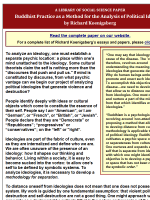
Buddhist Practice and Political Ideology (Dec 12, 2014) A LIBRARY OF SOCIAL SCIENCE PAPER Buddhist Practice as
a Method for the Analysis of Political Ideology by Richard Koenigsberg Read the complete paper on our website. For a
complete list of Richard Koenigsberg’s essays and papers, please click here. “One may say that ideology is the cause
of the disease. The "cure", therefore, revolves around understanding the meaning of political ideologies that generate
destruction. Why do human beings embrace, promote and ena
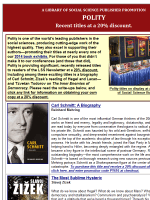
Recent titles from Polity at a 20% discount (Dec 11, 2014) A LIBRARY OF SOCIAL SCIENCE PUBLISHER PROMOTION POLITY
Recent titles at a 20% discount. Polity is one of the world’s leading publishers in the social sciences, producing cutting-edge
work of the highest quality. They also excel in supporting their authors—promoting their titles at nearly every one
of our 2014 book exhibits. For those of you that didn’t make it to our conferences (and those that did), Polity is providing
significant, recently released titles to readers of
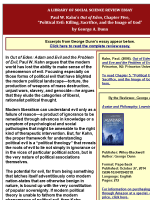
Political Evil: Review of Paul Kahn (Dec 9, 2014) A LIBRARY OF SOCIAL SCIENCE REVIEW ESSAY Paul W. Kahn’s Out of
Eden, Chapter Five, “Political Evil: Killing, Sacrifice, and the Image of God” by George A. Dunn Excerpts from George
Dunn"s essay appear below. Click here to read the complete review essay. Kahn, Paul. (2006). Out of Eden: Adam and Eve
and the Problem of Evil. Princeton, NJ: Princeton University Press. To read Chapter 5, “Political Evil: Killing, Sacrifice,
and the Image of God” click here.
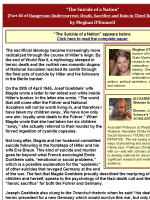
The Suicide of a Nation (Dec 9, 2014) “The ‘Ruin Value’ of Monumental Architecture” “The Suicide of a Nation” (Part
III of Dangerous Undercurrent: Death, Sacrifice and Ruin in Third Reich Germany) by Meghan O’Donnell “The Suicide of
a Nation” appears below. Click here to read the complete paper. Meghan O"Donnell is a lecturer of history at
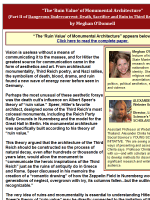
The ‘Ruin Value’ of Monumental Architecture (Dec 9, 2014) “The ‘Ruin Value’ of Monumental Architecture”
“The ‘Ruin Value’ of Monumental Architecture” (Part II of Dangerous Undercurrent: Death, Sacrifice and Ruin in Third
Reich Germany) by Meghan O’Donnell “The ‘Ruin Value’ of Monumental Architecture” appears below. Click here to read the
complete paper.
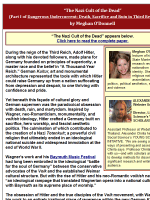
The Nazi Cult of the Dead (Dec 8, 2014) “The Nazi Cult of the Dead” “The Nazi Cult of the Dead” (Part I of Dangerous
Undercurrent: Death, Sacrifice and Ruin in Third Reich Germany) by Meghan O’Donnell “The Nazi Cult of the Dead” appears
below. Click here to read the complete paper.
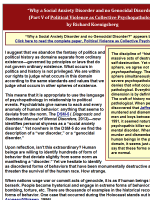
Why a Social Anxiety Disorder and no Genocidal Disorder? (Dec 4, 2014) “Why a Social Anxiety Disorder and no Genocidal
Disorder?” (Part V of Political Violence as Collective Psychopathology) by Richard Koenigsberg “Why a Social Anxiety
Disorder and no Genocidal Disorder?” appears below. Click here to read the complete paper, Political Violence as Collective
Psychopathology. The discipline of “history” records massive acts of destruction and self-destruction. Yet within this
sphere, we agree not to speak of psychopathology. The p
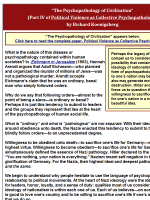
The Psychopathology of Civilization (Dec 4, 2014) “The Psychopathology of Civilization” (Part IV of Political Violence
as Collective Psychopathology) by Richard Koenigsberg “The Psychopathology of Civilization” appears below. Click here
to read the complete paper, Political Violence as Collective Psychopathology. Perhaps the legacy of Nazism is to compel
us to consider the possibility that contained within the ideology of nationalism is a severe form of psychopathology.
Devotion to one’s nation may be a vi
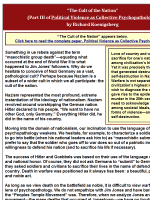
Cult of the Nation (Dec 3, 2014) “The Cult of the Nation” (Part III of Political Violence as Collective Psychopathology)
by Richard Koenigsberg “The Cult of the Nation” appears below. Click here to read the complete paper, Political Violence
as Collective Psychopathology. Love of country and willingness to sacrifice for one’s nation remain among civilization’s
highest ideals. Yet it was precisely these ideals that generated destruction and self-destruction in Nazi Germany. Warfare
is not separ
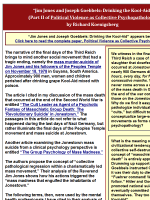
Jim Jones & Joseph Goebbels: Drinking the Kool-Aid (Dec 2, 2014) “Jim Jones and Joseph Goebbels: Drinking the Kool-Aid”
(Part II of Political Violence as Collective Psychopathology) by Richard Koenigsberg “Jim Jones and Joseph Goebbels:
Drinking the Kool-Aid” appears below. Click here to read the complete paper, Political Violence as Collective Psychopathology.
We witness in the final days of the Third Reich a case of mass slaughter that dwarfed what occurred at Jonestown. In
1945, nearly 900 Germans died every two hours, ev
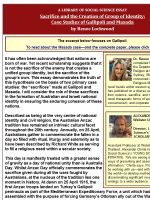
Sacrifice and the Creation of Group Identity (Dec 2, 2014) A LIBRARY OF SOCIAL SCIENCE ESSAY Sacrifice and the
Creation of Group of Identity: Case Studies of Gallipoli and Masada by Renee Lockwood The excerpt below focuses on Gallipoli.
To read about the Masada case—and the complete paper, please click here. Dr. Renee D. Lockwood completed her PhD within
the Department of Studies in Religion at the University of Sydney. She is primarily concerned with New Religious Movements
and novel trends within we
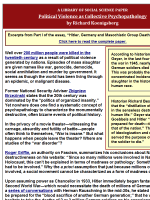
Hitler, Germany and Masochistic Group Death (Dec 1, 2014) A LIBRARY OF SOCIAL SCIENCE PAPER Political Violence
as Collective Psychopathology by Richard Koenigsberg Excerpts from Part I of the essay, “Hitler, Germany and Masochistic
Group Death” appear below. Click here to read the complete paper. According to historian Michael Geyer, in the last
four months of the war in 1945, nearly 500,000 German soldiers died per month. This was probably the most concentrated
incidence of mass-slaughter in the history of the human race
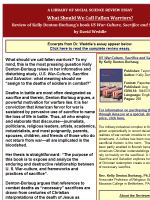
What Should We Call Fallen Warriors? (Nov 25, 2014)One of the brutal facts of war is that technologies of death
are always more advanced than methods of healing. The widespread use of cannonballs in the American Civil War caused
more mangled limbs than the overworked saws of surgeons could manage to amputate; the resulting gangrene took thousands
of lives in hospital tents. Anti-personnel mines—suddenly rising like flushed quail to propel their jagged contents
into human flesh—create nearly irreparable wounds when they do not simply end life altogether.
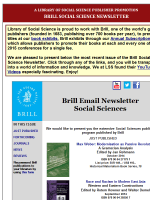
Brill Social Science Newsletter (Nov 24, 2014) A LIBRARY OF SOCIAL SCIENCE PUBLISHER PROMOTION BRILL SOCIAL SCIENCE
NEWSLETTER Library of Social Science is proud to work with Brill, one of the world s greatest publishers (founded in
1683, publishing over 700 books per year), to present its titles at our book exhibits. Brill exhibits through our Annual
Subscription Plan, which allows publishers to promote their books at each and every one of our 2015 conferences for
a single fee. We are pleased to present below the most
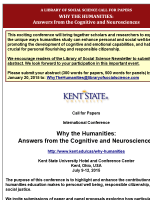
Call for Papers: Why The Humanities (Nov 20, 2014) A LIBRARY OF SOCIAL SCIENCE CALL FOR PAPERS WHY THE HUMANITIES:
Answers from the Cognitive and Neurosciences This exciting conference will bring together scholars and researchers to
explain the unique ways humanities study can enhance personal and social well-being by promoting the development of
cognitive and emotional capabilities, and habits crucial for personal flourishing and responsible citizenship. We encourage
readers of the Library of Social Science Newsletter to s
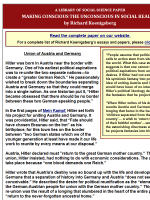
Return to the (Mother) Country (Nov 17, 2014) A LIBRARY OF SOCIAL SCIENCE PAPER MAKING CONSCIOUS THE UNCONSCIOUS
IN SOCIAL REALITY by Richard Koenigsberg Read the complete paper on our website. For a complete list of Richard Koenigsberg
s essays and papers, please click here. People assume that political ideas or calls to action stem from situations in
the world. What this case study suggests is that one cannot separate political aspirations from unconscious desires.
If Hitler had not externalized his symb
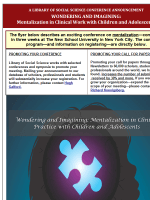
Exciting conference in New York City (Nov 17, 2014) A LIBRARY OF SOCIAL SCIENCE CONFERENCE ANNOUNCEMENT WONDERING
AND IMAGINING: Mentalization in Clinical Work with Children and Adolescents The flyer below describes an exciting conference
on mentalization coming up in three weeks at The New School University in New York City. The complete program and information
on registering are directly below. PROMOTING YOUR CONFERENCE Library of Social Science works with selected conferences
and symposia to promote your meeting.
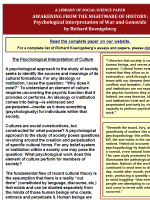
Awakening from the Nightmare of History2 (Nov 15, 2014) A LIBRARY OF SOCIAL SCIENCE PAPER AWAKENING FROM THE NIGHTMARE
OF HISTORY: Psychological Interpretation of War and Genocide by Richard Koenigsberg Read the complete paper on our website.
For a complete list of Richard Koenigsberg s essays and papers, please click here. I theorize that society is created
by human beings, and serves a human purpose. Cultural forms exist to the extent that they allow us to externalize, work
through and come to terms with our deepe
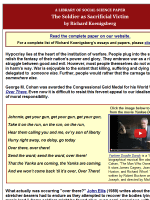
The Soldier as Sacrificial Victim (Nov 14, 2014) The Soldier as Sacrificial Victim A LIBRARY OF SOCIAL SCIENCE
PAPER The Soldier as Sacrificial Victim by Richard Koenigsberg Read the complete paper on our website. For a complete
list of Richard Koenigsberg s essays and papers, please click here. Hypocrisy lies at the heart of the institution of
warfare. People plug into the spectacle and relish the fantasy of their nation"s power and glory. They embrace war as
a righteous struggle between good and evil. Ho
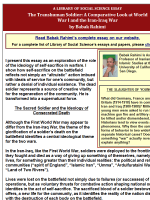
The Transhuman Soldier (Nov 13, 2014) A LIBRARY OF SOCIAL SCIENCE ESSAY The Transhuman Soldier: A Comparative Look
at World War I and the Iran-Iraq War by Babak Rahimi Read Babak Rahimi s complete essay on our website. For a complete
list of Library of Social Science s essays and papers, please click here. Babak Rahimi is Assistant Professor of Iranian
and Islamic Studies at the University of California at San Diego. THE SLAUGHTER OF YOUNG MEN What did
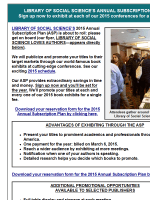
2015 Annual Subscription Plan (Nov 12, 2014) 77th Annual Meeting of the Rural Sociological Society (RSS) LIBRARY
OF SOCIAL SCIENCE S ANNUAL SUBSCRIPTION PLAN: Sign up now to exhibit at each of our 2015 conferences for a single fee
Attendees gather around the books at a Library of Social Science exhibit. LIBRARY OF SOCIAL SCIENCE S 2015 Annual Subscription
Plan (ASP) is about to roll: please get on board (our flyer, LIBRARY OF SOCIAL SCIENCE LOVES AUTHORS app
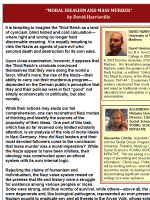
Moral Idealism and Mass Murder (Young Scholars Initiative) (Nov 12, 2014) First World War as Sacrificial Ritual
MORAL IDEALISM AND MASS MURDER by David Harrisville DAVID HARRISVILLE, University of Wisconsin, Madison David Harrisville
received his B.A. from Carleton College in 2009 and M.A. in 2012 from the University of Wisconsin-Madison. His dissertation
project, also at Madison under the guidance of Professor Rudy Koshar, is entitled, Unholy Crusade: The Moral Economy
of the Wehrmacht in Russia, 1941-44. It
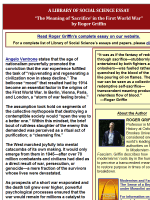
The Meaning of "Sacrifice" in the First World War (Nov 11, 2014) First World War as Sacrificial Ritual A LIBRARY
OF SOCIAL SCIENCE ESSAY “The Meaning of ‘Sacrifice’ in the First World War” by Roger Griffin Read Roger Griffin"s complete
essay on our website. For a complete list of Library of Social Science’s essays and papers, please click here. “It was
as if the fantasy of redemption through sacrifice—stubbornly entertained by both fighters and onlookers—was fuelled
rather than quenched by the blood of the fallen, l
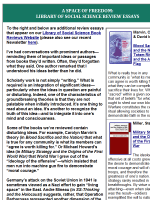
A space of freedom (Nov 7, 2014) A SPACE OF FREEDOM: LIBRARY OF SOCIAL SCIENCE REVIEW ESSAYS Marvin, Carolyn &
David Ingle Blood Sacrifice and the Nation: Totem Rituals and the American Flag What is really true in any community
is “what its members can agree is worth killing for,” or what they can be compelled to sacrifice their lives for. What
is “sacred” within a given society is that set of beliefs “for which we ought to shed our own blood.” Warfare constitutes
the central ritua
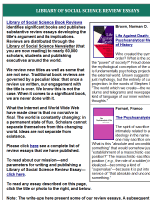
Beyond the traditional book review (Nov 3, 2014) LIBRARY OF SOCIAL SCIENCE REVIEW ESSAYS Brown, Norman O. Life
Against Death: The Psychoanalytical Meaning of History Who created the symbolic order? What is the source of the "power"
of society?" Freud observed that the mythological conception of the universe is fundamentally psychology projected into
the external world. Brown suggests that not just mythology, but the entirety of culture is a projection. In the words
of Stephen Spender: "The
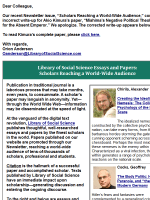
Dying for the Absent Emperor (Oct 31, 2014) Dear Colleague, Our recent Newsletter issue, Scholars Reaching a World-Wide
Audience, contained an incorrect write-up for Akio Kimura s paper, Mishima s Negative Political Theology: Dying for
the Absent Emperor. We apologize. The corrected write-up appears below. To read Kimura s complete paper, please click
here. With regards, Orion Anderson Oanderson@LibraryofSocialScience.com Library of Social Science Essays and Papers:
Scholars Reaching a World-Wide Audience
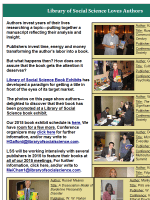
Library of Social Science Loves Authors (Oct 24, 2014) Library of Social Science Loves Authors Author: Kai Schaft
Title: Rural People and Communities in the 21st Century Publisher: Polity Conference: Rural Sociological Society Author:
Guillermo Bernal Title: Cultural Adaptations Publisher: APA Books Conference: National Latino/a Psychological Association
Author: William Wilson Title: The Declining Significance of Race Publisher: U. of Chicago Press Confere
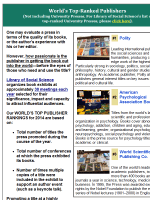
World"s Top Publishers (Oct 20, 2014) World"s Top-Ranked Publishers (Not including University Presses. For Library
of Social Science s list of top-ranked University Presses, please click here). #1 Polity Leading international publisher
in the social sciences and humanities, producing cutting-edge work of the highest quality. Particularly strong in sociology,
politics, social theory, philosophy, history, cultural and gender studies, and anthropology. An academic publisher,
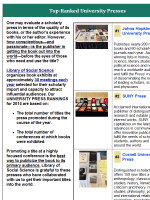
Top-Ranked University Presses (Oct 16, 2014) Top-Ranked University Presses #1 Johns Hopkins University Press Publishes
nearly 200 new books and 60 scholarly journals each year. Award-winning lists in history, science, literary studies,
political science and medicine reach a worldwide audience and fulfill the Press" mandate of disseminating the expertise
of leading scholars, scientists and physicians. #2 SUNY Press A
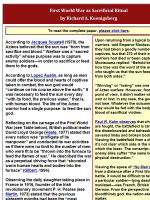
First World War as Sacrificial Ritual (Oct 7, 2014) First World War as Sacrificial Ritual First World War as Sacrificial
Ritual by Richard A. Koenigsberg To read the complete paper, please click here. Upon returning from a typical battle,
Aztec warriors told Emperor Moctezuma that they had taken a goodly number of captives, but that 370 of their own warriors
had died or been captured. Moctezuma replied: Behold brothers, how true was the word of the ancestors who taught us
that the sun feeds alike from both sides.
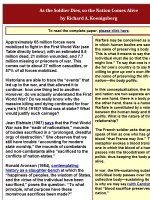
As the soldier dies, so the nation comes alive (Oct 6, 2014) As the soldier dies, so the nation comes alive As
the Soldier Dies, so the Nation Comes Alive by Richard A. Koenigsberg To read the complete paper, please click here.
Warfare may be conceived as an activity in which human bodies are sacrificed in the name of preserving a body politic.
This is what it means to say that the individual must die so that the nation might live. To say that one is willing
to die for one s country is to s
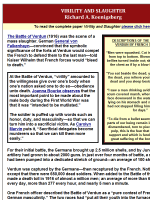
Virility and Slaughter (Oct 3, 2014) VIRILITY AND SLAUGHTER VIRILITY AND SLAUGHTER Richard A. Koenigsberg To read
the complete paper Virility and Slaughter please click here. DESCRIPTIONS OF THE BATTLE OF VERDUN BY FRENCH SOLDIERS
Men were squashed. Cut in two or divided from top to bottom. Blown into showers; bellies turned inside out; skulls forced
into the chest as if by a blow from a club. You eat beside the dead; you drink beside the dead, you relieve your
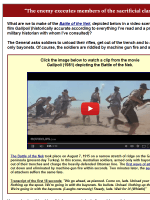
"The enemy executes members of the sacrificial class" (Oct 1, 2014) "The enemy executes members of the sacrificial
class" The enemy executes members of the sacrificial class What are we to make of the Battle of the Nek, depicted below
in a video scene from the film Gallipoli (historically accurate according to everything I ve read and a prominent military
historian with whom I ve consulted)? The General asks soldiers to unload their rifles, get out of the trench and to
attack with only bayonets. Of course, the so
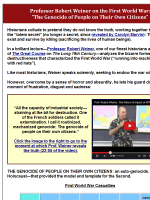
The First World War as auto-genocide (Sep 24, 2014) The First World War as auto-genocide Professor Robert Weiner
on the First World War: The Genocide of People on Their Own Citizens Historians collude to pretend they do not know
the truth, working together to conceal the totem secret (no longer a secret, since revealed by Carolyn Marvin): That
nations exist and survive by killing (sacrificing the lives of human beings). In a brilliant lecture Professor Robert
Weiner, one of our finest historians
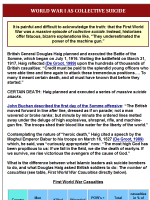
"They underestimated the power of the machine gun" (Sep 23, 2014) "They underestimated the power of the machine
gun" WORLD WAR I AS COLLECTIVE SUICIDE It is painful and difficult to acknowledge the truth: that the First World War
was a massive episode of collective suicide. Instead, historians offer fatuous, bizarre explanations like, They underestimated
the power of the machine gun. British General Douglas Haig planned and executed the Battle of the Somme, which began
on Jul 1, 1916. Visiting the bat
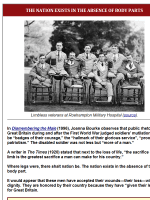
Nations Consume Body Parts (New) (Sep 19, 2014) Nations Consume Body Parts THE NATION EXISTS IN THE ABSENCE OF
BODY PARTS Limbless veterans at Roehampton Military Hospital (source). In Dismembering the Male (1996), Joanna Bourke
observes that public rhetoric in Great Britain during and after the First World War judged soldiers’ mutilations to
be “badges of their courage,” the “hallmark of their glorious service”, “proof of patriotism.” The disabled soldier
was not less but “more of
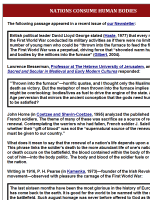
Feeding the gods of war (Sep 18, 2014) Feeding the gods of war NATIONS CONSUME HUMAN BODIES The following passage
appeared in a recent issue of our Newsletter: British political leader David Lloyd George stated (Haste, 1977) that
every nation during the First World War conducted its military activities as if there were no limit to the number of
young men who could be thrown into the furnace to feed the flames of war. The First World War was a perpetual, driving
force that shove
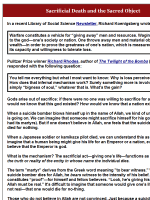
Sacrificial death and the sacred object (Sep 18, 2014) Sacrificial death and the sacred object Sacrificial Death
and the Sacred Object In a recent Library of Social Science Newsletter, Richard Koenigsberg wrote that: Warfare constitutes
a vehicle for giving away men and resources. Waging war is a gift to the god one s society or nation. One throws away
men and material objects wealth in order to prove the greatness of one s nation, which is measured in terms of its capacity
and willingness to
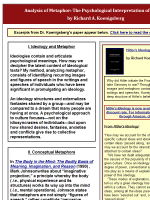
Embodied Metaphors & Ideology (Sep 15, 2014) Embodied Metaphors & Ideology Analysis of Metaphor: The Psychological
Interpretation of Culture by Richard A. Koenigsberg Excerpts from Dr. Koenigsberg"s paper appear below. Click here to
read the complete essay. Hitler"s Ideology by Richard Koenigsberg Why did Hitler initiate the Final Solution and take
Germany to war? Thr
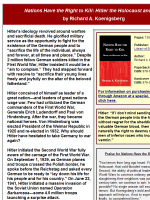
Genocide as a Function of Warfare (Sep 12, 2014) Nations Have the Right to Kill: Hitler the Holocaust and War Nations
Have the Right to Kill: Hitler the Holocaust and War by Richard A. Koenigsberg Pages: 136 pages Publisher: Library of
Social Science Author: Richard A. Koenigsberg Paperback ISBN: 978-0915042234 Hardcover ISBN: 978-0915042241 For information
on purchasing this book through Amazon at a special, discount rate, click here. Hitler: If I do
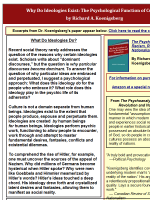
The Psychological Function of Culture (Sep 11, 2014) Why Do Ideologies Exist: The Psychological Function of Culture
Why Do Ideologies Exist: The Psychological Function of Culture by Richard A. Koenigsberg Excerpts from Dr. Koenigsberg"s
paper appear below. Click here to read the complete paper. The Psychoanalysis of Racism, Revolution and Nationalism
By Richard A. Koenigsberg For information on purchasing through Amazon at a special rate, click here. From The P
Sep 11, 2014
Call for a Review Essay:
US War-culture, Sacrifice and Salvation
Library of Social Science
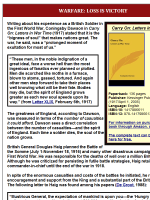
Warfare: Loss is Victory (Sep 7, 2014) WARFARE: LOSS IS VICTORY WARFARE: LOSS IS VICTORY Carry On: Letters in War
Time Paperback: 136 pages Publisher: Kessinger Publishing, LLC (1917/Apr 1, 2005) Language: English ISBN-10: 1417986611
ISBN-13: 978-1417986613 For information on purchasing this book through Amazon, click here. The complete text can be
read online here for free. Writing about his experience as a British Soldier in the First World War
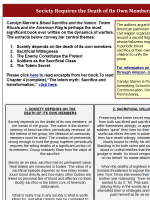
The most significant book ever written on war? (Sep 1, 2014) The most significant book ever written on war? Society
Requires the Death of Its Own Members The authors argue that American patriotism is a civil religion organized around
a sacred flag, whose followers engage in periodic blood sacrifice of their own children to unify the group. For information
on purchasing through Amazon, click here. Carolyn Marvin is Professor at the Annenberg School for Communication, University
of Pennsylvania. Carolyn Marvin&
Aug 6, 2014
Sacrifice: Bad Math, Bad Grammar
Ivan Strenski
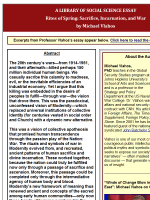
Sacrifice, Incarnation, and War - Michael Vlahos (Aug 8, 2014) Rites of Spring: Sacrifice, Incarnation, and War
A LIBRARY OF SOCIAL SCIENCE ESSAY Rites of Spring: Sacrifice, Incarnation, and War by Michael Vlahos Excerpts from Professor
Vlahos"s essay appear below. Click here to read the complete essay. About the Author Michael Vlahos, PhD teaches in
the Global Security Studies program at Johns Hopkins University’s School of Arts and Sciences and is a professor
in the Strategy and Polic
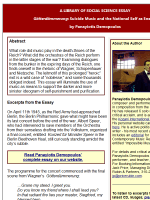
Suicide Music in Nazi Germany (May 1, 2014) Suicide Music in Nazi Germany A LIBRARY OF SOCIAL SCIENCE ESSAY Götterdämmerung:
Suicide Music and the National Self as Enemy by Panayiotis Demopoulos. Panayiotis Demopoulos is a Greek composer and
performer, holding a PhD in composition from the University of York. He has released 6 solo recordings to critical acclaim,
and is artistic director of the Kozani International Music Seminar. His personal website can be accessed here. He
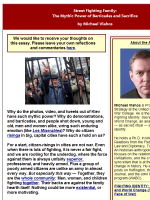
The Mythic Power of Barricades and Sacrifice (Mar 4, 2014) The Mythic Power of Barricades and Sacrifice Street
Fighting Family: The Mythic Power of Barricades and Sacrifice by Michael Vlahos About the Author Michael Vlahos is Professor
of Strategy at the United States Naval War College. He is the author of Fighting Identity: Sacred War and World Change,
an analysis of how war — as sacred ritual — shapes collective identity. He holds a Ph.D. in International Relations
from the Fletcher School of La
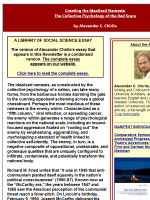
Psychology of the Red Scare (Feb 27, 2014) Psychology of the Red Scare Creating the Idealized Nemesis: The Collective
Psychology of the Red Scare by Alexander C. Chirila About the Author Alexander C. Chirila, holds a PhD in Writing and
Criticism from the State University at Albany, and currently teaches English and Literature at Webster University, Thailand.
He is the author of numerous short stories, articles, a full-length novel entitled True Immortality.
Nov 6, 2013
Sacrifice, American Exceptionalism and War-Culture
Kelly Denton-Borhaug
Review Essay of Stanley Hauerwas's book
War and the American Difference: Theological Reflections on Violence and National Identity.
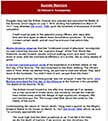
Suicide Warriors (Sep 18, 2013) What is the difference between the Islamic warrior who died for Allah and
the British soldier who died for God and country in the First World War? The magnitude of slaughter. In his report of
Aug 22, 1919—Features of the War—Haig summarized British casualties, stating that they were “no larger than to be
expected.”
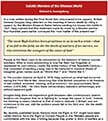
Suicide Warriors of the Western World In a note written during the First World War (discovered in his papers), British
General Douglas Haig reflected on the meaning of heroic death by citing a speech by the Moslem Emperor Baber before
sending his troops into battle in 1527. Haig claimed that this statement made by made by a Moslem warrior four-hundred
years earlier conveyed the “root matter of the present war.”